The Boxer armoured vehicle is expected to enter service with the British Army in 2025. This is its history.
The ARTEC Boxer 8×8 armoured vehicle was selected to meet the British Army’s Mechanised Infantry Vehicle (MIV) requirement, but this is not the first time it was selected, arguably, this is the third time lucky for the Boxer and the British Army.
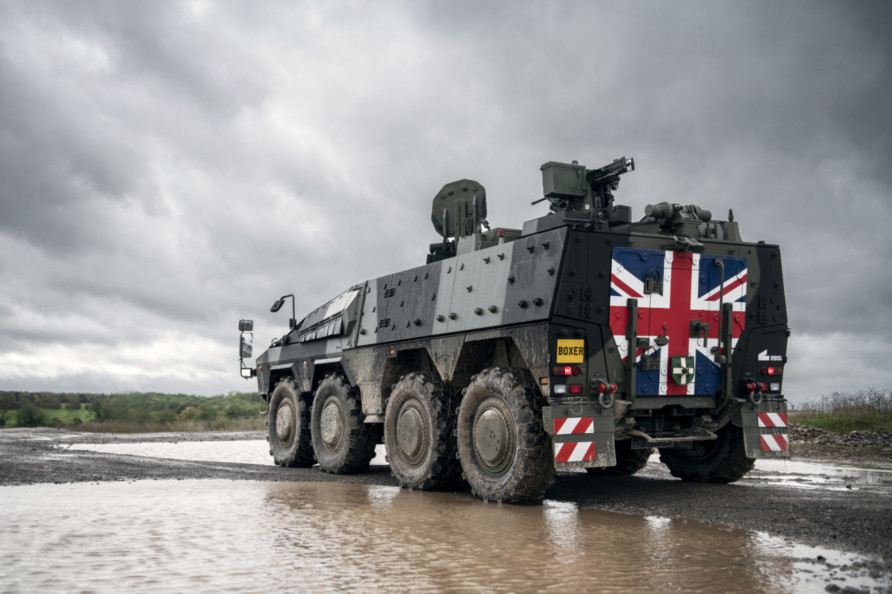
The involvement of the UK with Boxer began indirectly in the late eighties/early nineties.
Boxer Round 1 — The Multi-Role Armoured Vehicle (MRAV) Era
The international program that delivered Boxer was referred to as The Multi-Role Armoured Vehicle (MRAV). However, the UK’s component of this program was informed and preceded by another program, the Future Family of Light Armoured Vehicles (FFLAV)
The early history of Boxer is definitely international, with UK, German and French industry each playing key parts.
Boxer starts off with three national requirements.
- UK: Family of Light Armoured Vehicles (FLAV) and Future Family of Light Armoured Vehicles (FFLAV)
- Germany: Gepanzerte Transport-Kraftfahrzeug (GTK)
- France: Véhicule Blindé Modulaire (VBM)
Development concepts, test vehicles and national and multinational programs eventually came together with the French deciding to go their own way.
Although FFLAV was cancelled in 1994/5, one of its features that stayed was its numeric classification system for Mobility and Protection.
- Mobility: 1 to 3, with the highest mobility being 1
- Protection: 1 to 3, with the highest protection being 1
For instance, M1P1 would correspond to Warrior.
Meanwhile, France and Germany were also contemplating the replacement of legacy vehicles from the Cold War.
Véhicule Blindé Modulaire (VBM)
France has a lot of experience with multi-axle combat vehicles, like those from Panhard, GIAT, Renault, Berliet, and Lohr.
In 1991, the French army began exploring concepts for a replacement for the AMX-10P infantry fighting vehicle. The initiative was ultimately referred to as Véhicule Blindé Modulaire (VBM)
Gepanzerte Transport-Kraftfahrzeug (GTK)
In the early eighties, Daimler Benz carried out trials with heavy wheeled vehicles partly funded by the German government, the EXperimental Fahrzeug (EXF) was an 8×8 vehicle weighing just over 22 tonnes.
EXF had a wheel travel of +200 mm/-300 mm, and all wheels were steerable. However, early trials included a concrete weight representing a turret, bringing the weight up to a more representative figure.
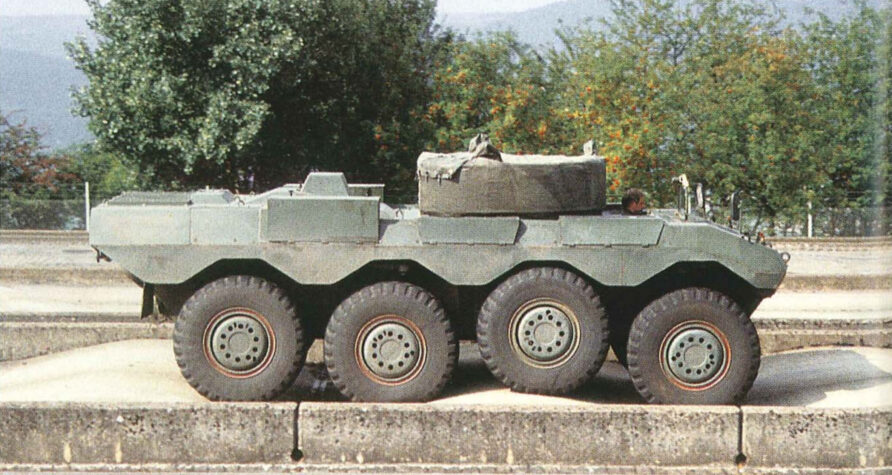
The objective of the programme was to demonstrate that wheeled vehicles could have the same mobility as a tracked vehicle at weights above and beyond the accepted maximum norm of 20 tonnes.
Furthermore, it featured an advanced centralised tyre inflation system.
To meet the then-emerging requirement for the Panther tank destroyer, EXF was further demonstrated and suggested.
The rear engined Radkampfwagen 90 was fitted with a Leopard 2 prototype turret.
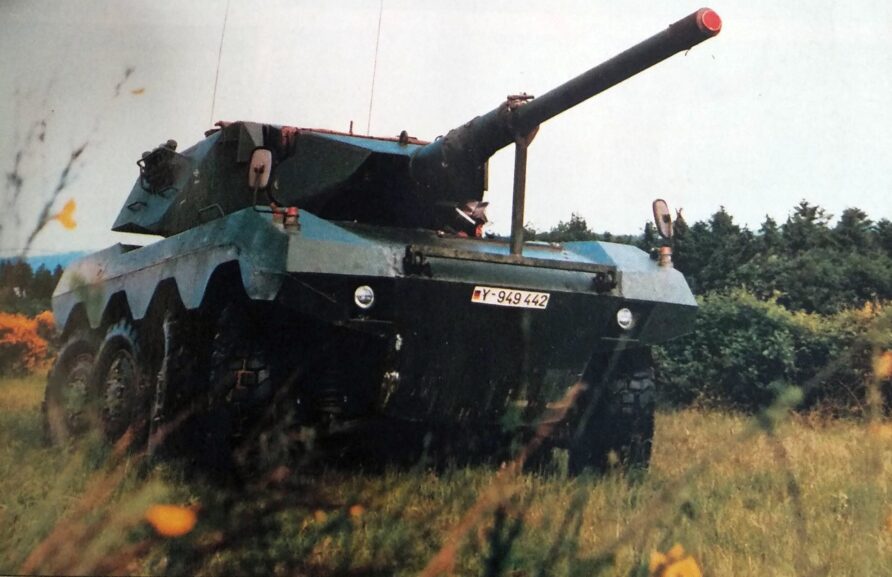
Further design work was completed by Daimler-Benz to describe how the same collection of components could be used in a modular approach for various front and rear engine designs.
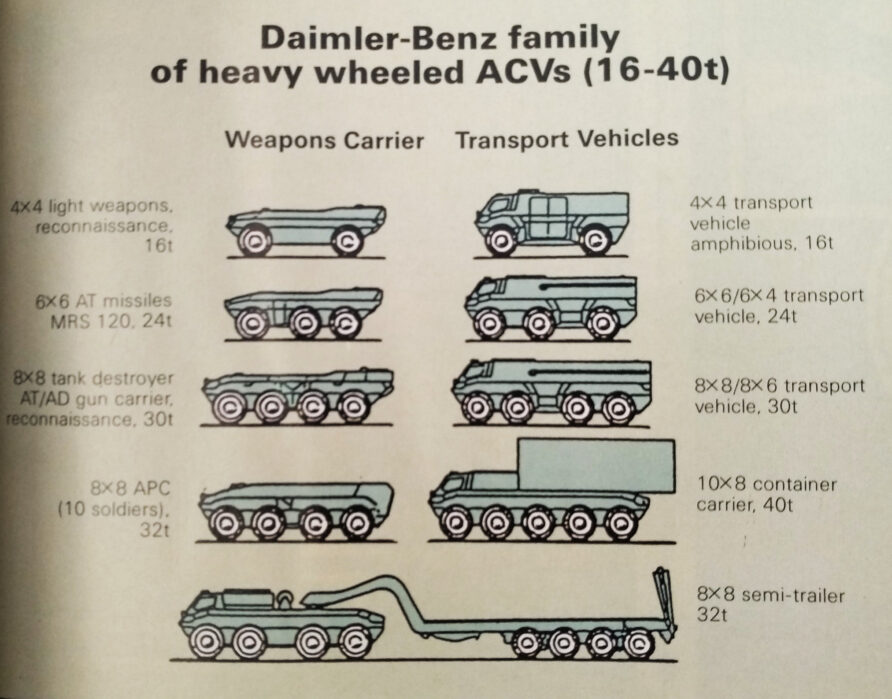
Although EXF was impressive, it was not pulled through into a specific vehicle, although it would inform GTK.
The Panther concept study was awarded to Wegmann with a modified Leopard I chassis and an ATGW launcher. It didn’t enter service either.
The GTK requirement was to replace Fuchs and M113 in the Heer. Initial requirements and concepts from 1990 were developed until final requirements were released in 1995.
A wooden mock-up was completed to evolve the design and requirements.
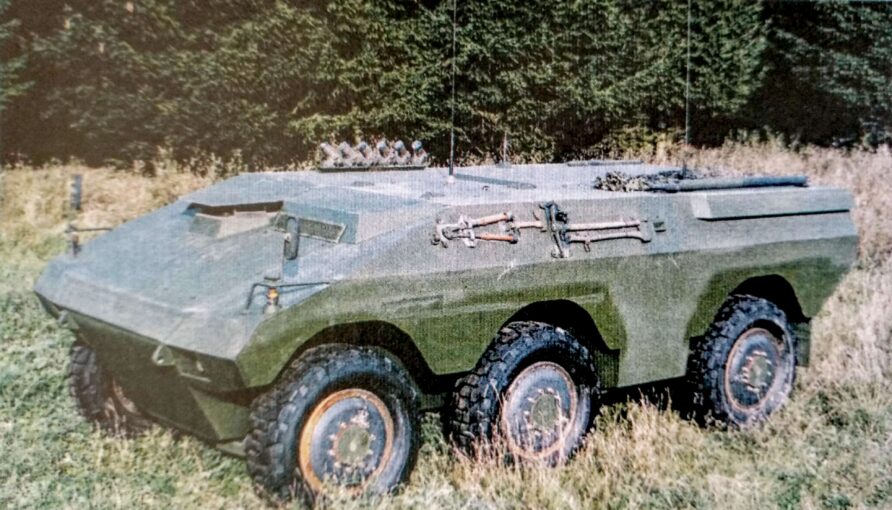
VBM and GTK Converge
In the early nineties, VBM and GTK were still working independently, but they would soon come together.
The two nations then agreed that a jointly designed vehicle would be able to satisfy both nations’ requirements. It would replace the French AMX-10RC, VAB and ERC-90 Sagaie and the German Spahpanzer Luchs, TPz1 Fuchs and M113.
Keeping politics in mind, both France and Germany were also committed to the idea that the vehicle would be used to equip the upcoming Euro Corps.
At a meeting in Bonn in December 1993, Francois Leotard, the French Defence Minister, and Volker Ruhe, the German Defense Minister, agreed to set up a joint arms agency.
It was not a European agency, but a French/German organization to manage a specific number of joint programmes. From this would eventually spring forth OJAC, or, as it was known in the French, the Organisation conjointe de coopération en matière d’armement.
One of these projects was the VBM/GTK.
Two French vehicles emerged from the VBM requirement while the process of convergence continued, one each from GIAT and Renault
In 1992, GIAT provided private funding for the Vextra technology demonstration vehicle to investigate the potential of heavy wheeled combat vehicles.
It was 27 tonnes in weight, powered by a Scania diesel engine, and was capable of carrying nine dismounted personnel or 6 tonnes of cargo.
Initial GIAT Vextra models were fitted with a one-man 25 mm cannon-armed DRAGAR turret.
Through the period, Vextra was extensively tested, including with a 105 mm gun-armed turret.
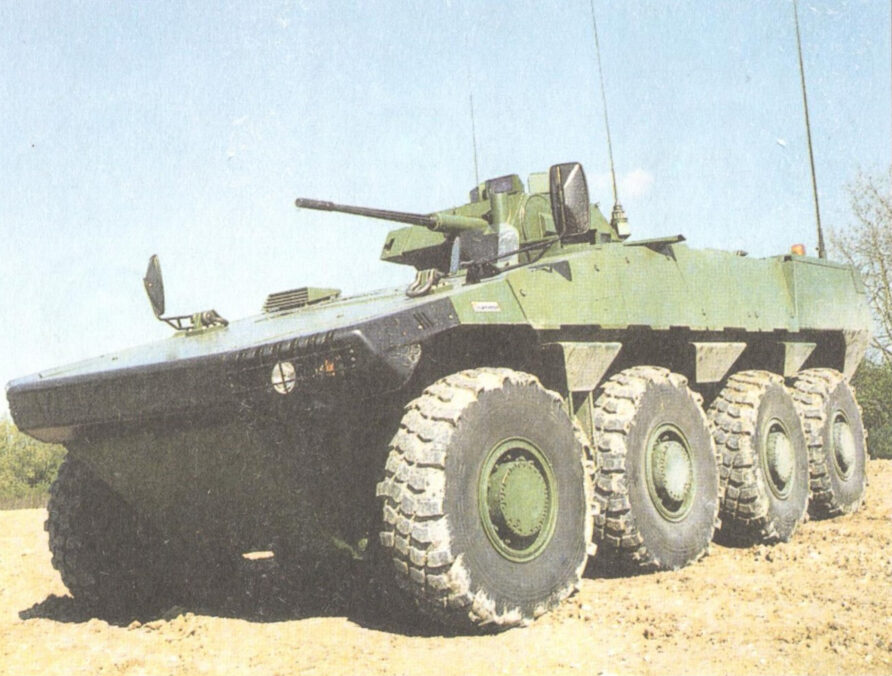
In 1994, the Renault X8A was showcased, although it was not made public until 1996.
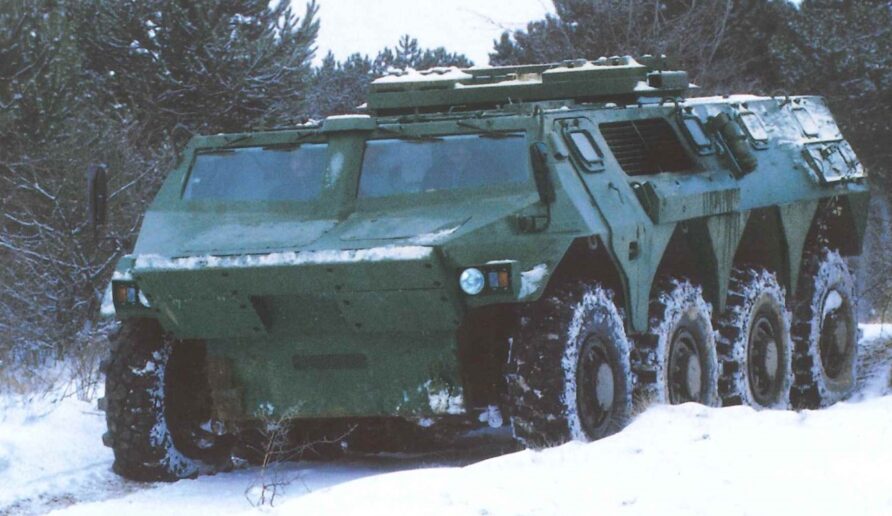
The French GIAT Vextra and German Daimler Benz EXF were on display at Eurosatory 94, described as potential designs for the VBM/GTK program.
A 25-ton wheeled vehicle capable of carrying nine dismounted personnel and achieving a road speed of 120 kilometres per hour was required.
Centralized tire pressure would provide comparable mobility to tracked vehicles, which holds particular significance to the French as they intend the vehicle to replace the AMX-10RC and operate alongside their Main Battle Tanks.
Panhard worked in collaboration with Mercedes-Benz, Krauss Maffei Wehrtechnik, and GIAT Industries to produce a joint concept study for the VBM/GTK requirement.

The vehicle concept was designed to be available in a number of 6×6 and 8×8 variants.

These vehicles included an infantry carrier and a fire support vehicle.
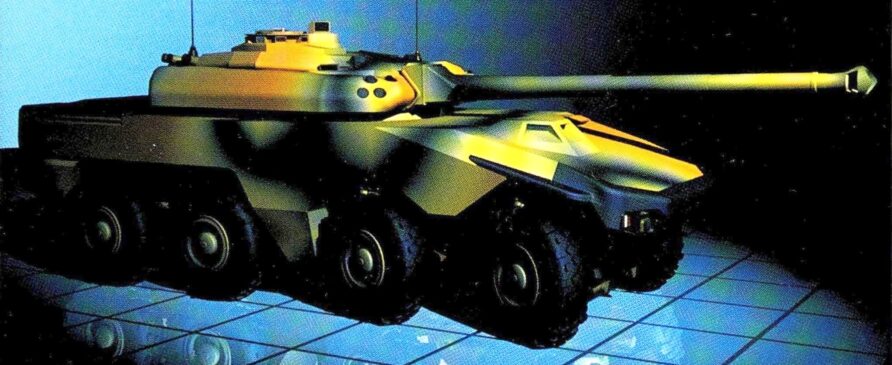
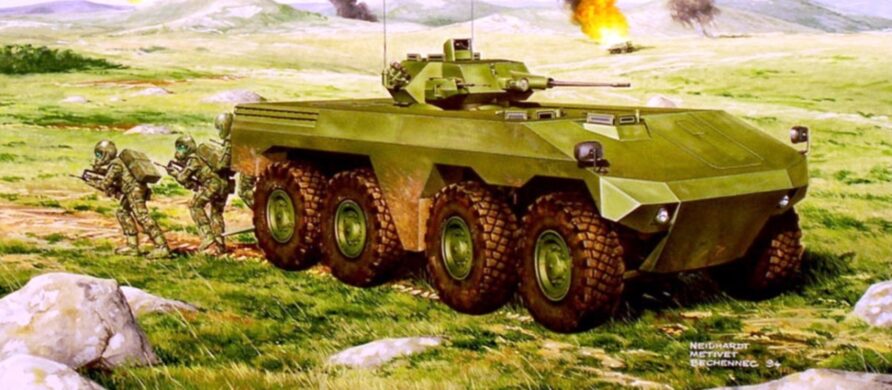
Also on display at Eurosatory 94 (on the GIAT stand) was a 6×6 mock-up referred to as the European Vehicle Armoured (EVA), also intended to showcase what the end product might look like and a realisation of the concepts shown above.
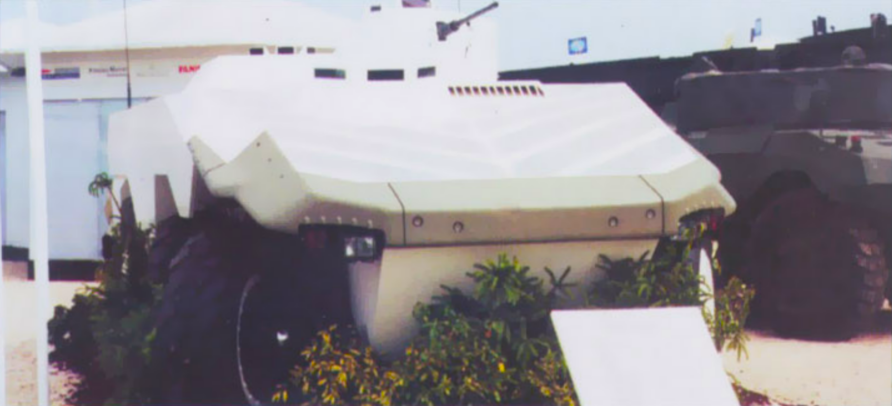
EVA combined elements from both the EXF and Vextra and had a 500hp engine and Renk automatic transmission. It was capable of accommodating 9 passengers and 2 crew, and weighed 22 tonnes in the 6×6 mock-up configuration.
At these stage, 6×6 and 8×8 configurations were included in the concepts, but it was still a French/German programme.
The UK Joins GTK/VBM and a Competition Takes Place
The British Army endorsed a new approach called the Light Armoured Vehicles Strategy after FFLAV was closed out in 1994/5.
CVR(T) to TRACER
The first component of this strategy proposed a life extension program for CVR(T), the withdrawal of CVR(W) Fox, and a medium-term programme to replace Scimitar and Striker CVR(T) with a new family of vehicles under the Tactical Reconnaissance Armoured Combat Equipment Requirement (TRACER) programme.
Alongside proposing the Warrior as an FV432 replacement, GKN would also propose ‘Recce Warrior’ as a CVR(T) replacement under TRACER.
Ferret to Future Command and Liaison Vehicle (FCLV)
Under the Future Command and Liaison Vehicle (FCLV) programme, the Ferret would be replaced by a new wheeled vehicle.
This would eventually be Panther.
Saxon and FV432 to Multi Base Armoured Vehicle (MBAV)
The Multi Base Armoured Vehicle (MBAV) would replace both tracked and wheeled vehicles, including Saxon and FV432, as well as those CVR(T) not replaced by TRACER.
Two vehicle specifications were included in the MBAV.
Replacing FV432 and some CVR(T), M1P1 would be met with a nationally procured tracked vehicle, using the FFLAV mobility and protection classification.
M2P2 would require an international programme to replace Saxon and some FV432 variants.
M1P1 became the Armoured Battlegroup Support Vehicle (ABSV) in service by 2006, initially projected to be further Warrior variants.
M2P2 became MRAV, but it could be upgraded to P1 without affecting its M2 mobility rating.
Below, roles and quantities (where defined) are shown.
- Armoured Personnel Carrier (470)
- Command Vehicle (180)
- Communication Vehicle (110)
- Armoured Treatment and Evacuation Vehicle (185)
- Armoured Repair and Recovery Vehicle
- Armoured Mortar Vehicle
- Mortar Fire Control Vehicle
The in-service date was planned for 2007.
The UK became involved in the Boxer story in mid-1995 when they were invited to join OJAC.
After the conclusion of FFLAV and the endorsement of LAV, the requirements of MBAV M2P2 were aligned with the French German VBM/GTK.
Three nations agreed in 1996 to develop a vehicle family that would meet the three national requirements using two competing consortia with equal national representation.
The Organisation conjointe de coopération en matière d’armement (OJAC) then became the Organisation for Joint Armament Co-operation, or OCCAR, with the UK, France, Italy, and Germany as founding members.
It’s worth noting that OCCAR has nothing to do with the European Union.
British and German intentions were that OCCAR would manage the programme through open competition, but the French did not agree.
A compromise solution was proposed by the German government, which included multinational consortia with an assured work share in the manufacturing phase.
At the end of the discussion, it was decided OCCAR would not manage the MRAV competition as it wanted and so it was managed by the German defence procurement organisation, Bundesamt für Wehrtechnik und Beschaffung (BWB) with the proviso that GIAT could join whichever consortia won, because France.
All the European manufacturers formed consortia because they understood the implications of losing.
These would eventually coalesce into two competing teams, each submitting their concepts for consideration by the three partner nations.
The requirement by then commonly known as MRAV called for a family of vehicles that could be used for multiple roles, high levels of protection and mobility were specified and an internal usable volume of 11m3, much higher than contemporary vehicles like the FV432, Fuchs or VAB.
It’s important to note that the vehicle was intended to be large.
The two competing consortia (noting that Renault was not in either) were:
Team International

TEAM (Technology for Armoured Mobility) International comprised Vickers Defence Systems, Alvis, Henschel, Kuka and Panhard and Levassor.

TEAM international adopted a conventional approach, wherein the slightly divergent national requirements were met by varying equipment fittings. However, the horizontally hinged two-part rear door mechanism (shown below) deviated from norms.
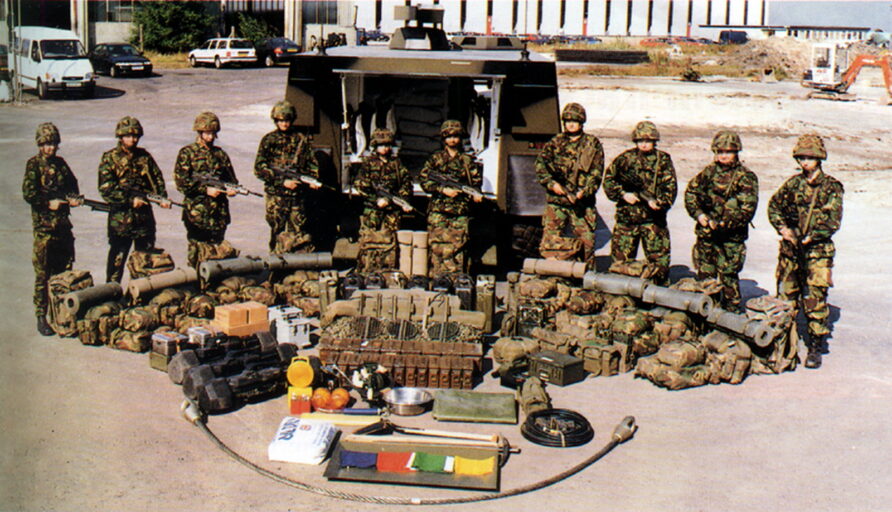
The 23.5 tonnes vehicle was powered by an MTU engine and had a suspension based on the Henschel TH400 6×6 reconnaissance vehicle.
Eurokonsortium
ARGE-GTK (Eurokonsortium) comprised GKN, Krauss Maffei, MaK/Rheinmetall, Wegmann and eventually GIAT (not shown in the graphic below)

Eurokonsortium would meet different national requirements using modules.

The 26.5-tonne vehicle used the same suspension as that of the Daimler Benz EXF and was powered by a Deutz engine.
As can be seen above, all were 6×6 designs and had protected driver viewports.
In 1997, the designs were revealed as mock-ups.
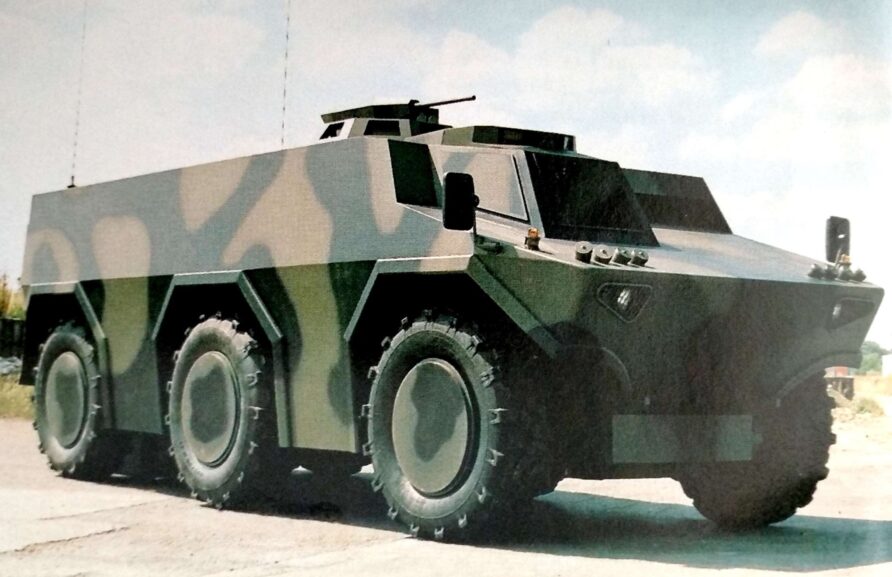
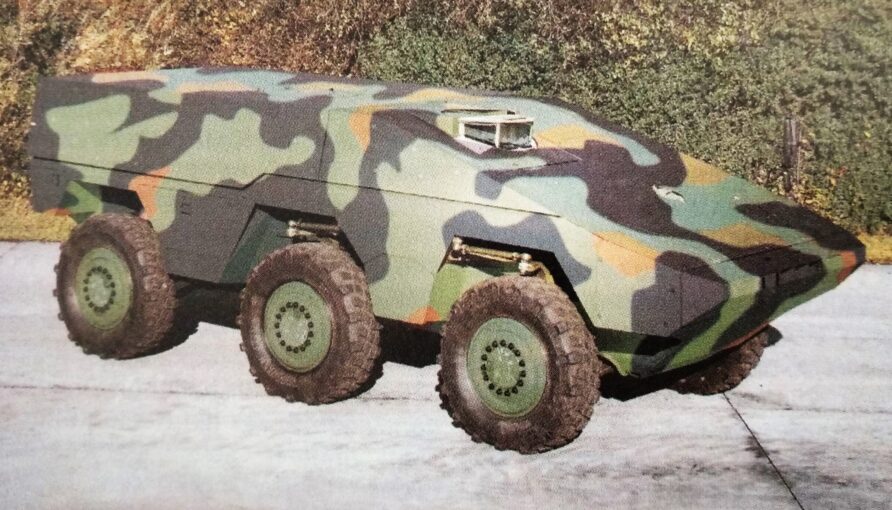
As the deadline approached, both consortiums continued their marketing efforts.
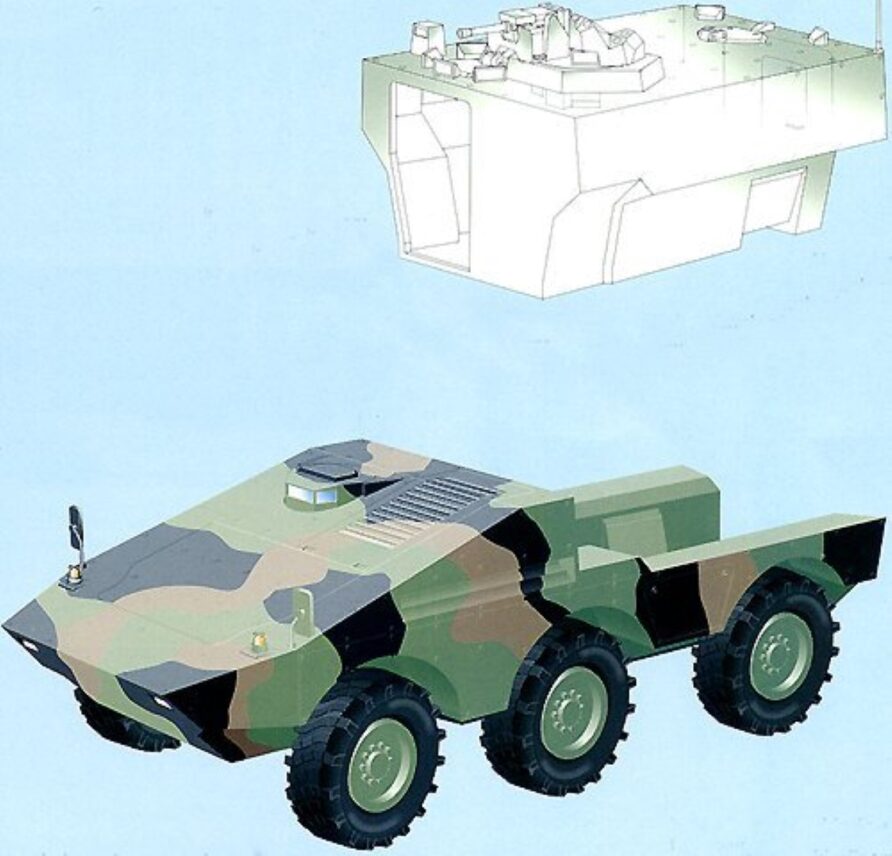
Unbeknown to Team International, the ARGE-GTK Eurokonsortium also submitted a proposal for an 8×8 variant.
The Netherlands joined the programme in 1997 as an observer.
New Labour came into power in 1997.
In April 1998, Eurokonsortium was announced as the competition winner.
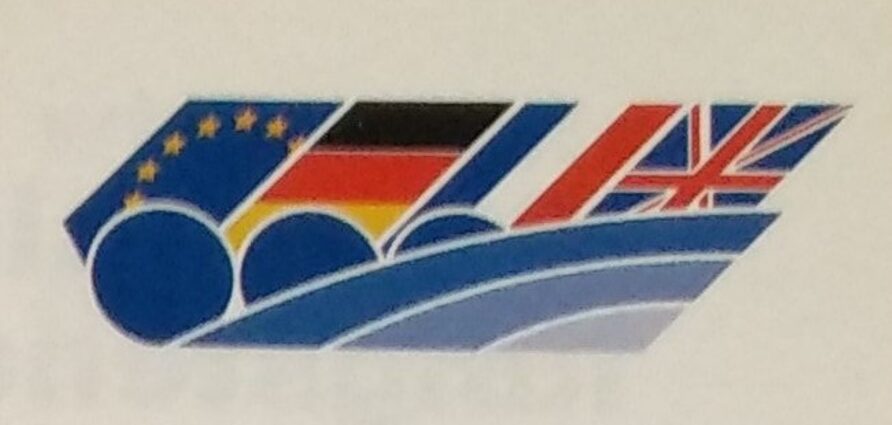
A House of Lord’s announcement described the decision:
Lord Gilbert: I am pleased to announce that, together with Germany and France, we intend to develop and produce a family of armoured utility vehicles to meet the requirements of all three nations. The UK needs these vehicles to replace FV430, Saxon and Combat Vehicle Reconnaissance (Tracked) utility vehicles.
We plan to sign a Memorandum of Understanding for the joint programme, known in the UK as the Multi-Role Armoured Vehicle, MRAV, covering development and initial production of a total of 600 vehicles.
Subject to the completion of the national approvals processes in Germany and France and the negotiation of satisfactory contract terms and conditions, it is intended to place a contract with Eurokonsortium, a consortium including GKN Defence Ltd from the UK, Krauss-Maffei/Wegmann and MAK from Germany, and GIAT from France.
This programme will be managed within the quadrilateral Organisation for Joint Armament Co-operation, known as OCCAR, and represents a major collaboration with our European allies.
Collaboration will bring a number of benefits, including improved interoperability and financial savings, through sharing of development costs and economies of scale in production. The project also offers UK industry the opportunity to strengthen its links with the leading companies in the European armoured vehicles industry
Team International threatened legal action because the original requirement was for a 6×6 design.
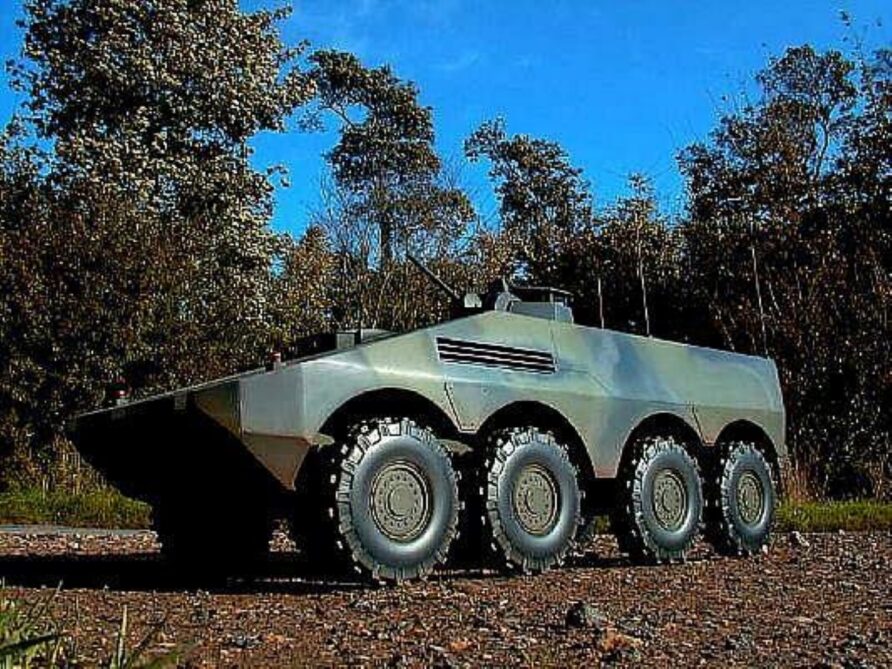
After submitting their own 8-8 proposal, five months after the official closing date, Team International’s protest stalled.
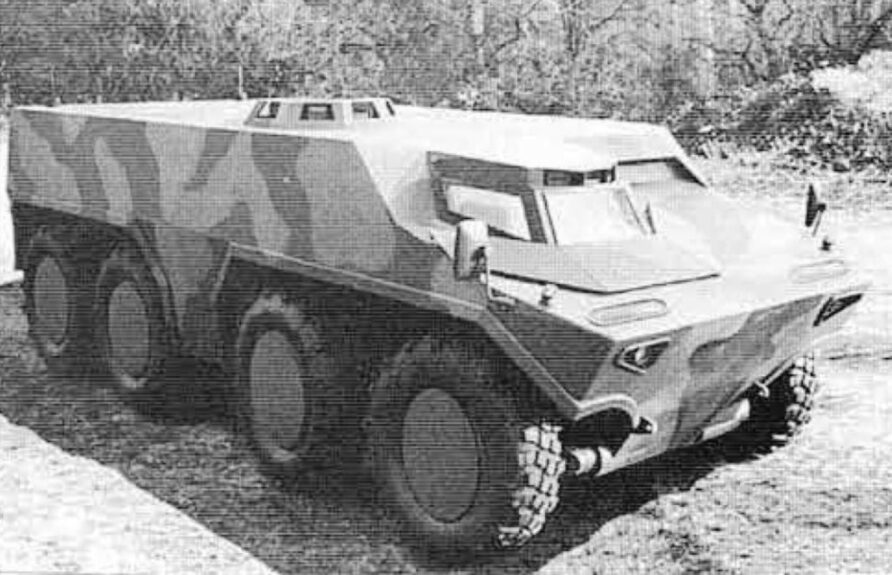
A July 1998 Parliamentary Question elicited this response from the Government:
Mr. Key: To ask the Secretary of State for Defence (1) if he will make a statement on the progress of the MRAV project; (2) how many multirole armoured vehicles he intends to purchase.
Mr. Spellar: Following the joint announcement with France and Germany on 22 April of our intention to proceed with collaborative development and initial production of the Multi-Role Armoured Vehicle, MRAV, and of the selection of the trilateral consortium “Eurokonsortium” as the preferred bidder, we have set work on hand to prepare a Memorandum of Understanding between the three nations. Detailed contract negotiations with the consortium are also proceeding. The initial production order will include 200 vehicles for each nation. No decisions have been taken on the final numbers required.
The competition’s end resulted in a swift convergence of losers, as evidenced by the acquisition of the GKN Defence business by Alvis in September 1998.
The 1998 Strategic Defence Review (SDR) committed the UK to an interventionist foreign policy, recognising a change in the security environment.
The British are, by instinct, an internationalist people. We believe that as well as defending our rights, we should discharge our responsibilities in the world. We do not want to stand idly by and watch humanitarian disasters or the aggression of dictators go unchecked. We want to give a lead, we want to be a force for good.
On the positive side, the collapse of Communism and the emergence of democratic states throughout Eastern Europe and in Russia means that there is today no direct military threat to the United Kingdom or Western Europe…The end of the Cold War has transformed our security environment.
The world does not live in the shadow of World War. There is no longer a direct threat to Western Europe or the United Kingdom as we used to know it, and we face no significant military threat to any of our Overseas Territories
And that forces would need to be more joint, exploit technology and more be expeditionary. Although it is well accepted that the 1998 SDR was a foreign policy led document that failed to win the backing of the Treasury, it set in train a series of projects and programmes that would include FRES, the Future Rapid Effect System.
The Strategic Defence Review also made clear there would be a European element to future defence acquisition. It also described continuing intent with MRAV.
Wherever possible, European governments should harmonise the requirements of their Armed Forces and pursue co-operative solutions. This not only avoids unnecessary duplication of development and production costs but makes sound operational sense. As part of their initiative, the Defence Ministers announced on 20 April that they would give high priority to resolving a number of governmental issues — for example relating to security and intellectual property rights – which could hinder restructuring and would sign a Letter of Intent setting out a timetable for this on 6 July.
The creation of a multinational organisation, OCCAR (Organisme Conjointe de Co-operation en matière d’Armament), involving Britain, France, Germany, and Italy to undertake common procurement also has an important part to play.
The outcome of the Strategic Defence Review fully reflects the importance that the Government attaches to maintaining a strong and healthy British and European defence industry combined with a continuing commitment to competitive procurement.
The Review’s forward equipment plans include a range of major European collaborative projects including Eurofighter, Horizon frigate, and the Multi-Role Armoured Vehicle (MRAV).
We will be seeking to ensure that there are realistic European options to be considered for our longer term-requirements such as the replacement for the Tornado bomber and improved strategic air transport
Following the 1998 SDR and Smart Procurement initiative, the MoD created a single Equipment Capability Customer (ECC) called Deputy Chief of Defence Staff (Equipment Capability), a 3* joint post.
Underneath, were four capability portfolios, each with a single manager;
- Strategic deployment
- Strike
- Manoeuvre
- Information superiority
Spread across these four portfolios were fifteen individual 1* Directors of Equipment Capability (DEC).
The Joint Capabilities Board was chaired by the Deputy Chief of Defence Staff (Equipment Capability) with the four Capability Managers, the Director-General (Equipment) and Director General (Research and Development).
The Director of Equipment Capability Ground Manoeuvre (DEC(GM)) would normally take the lead on requirements setting after consulting various stakeholders. Defence Equipment and Support (DE&S) then delivers the requirement to the user.
The Deputy Chief of Defence Staff (Equipment Capability) was responsible for equipment capability but did not sit on the Defence Procurement Agency Equipment Approval Committee.
Design work continued, including developing the 6×6 and 8×8 concepts
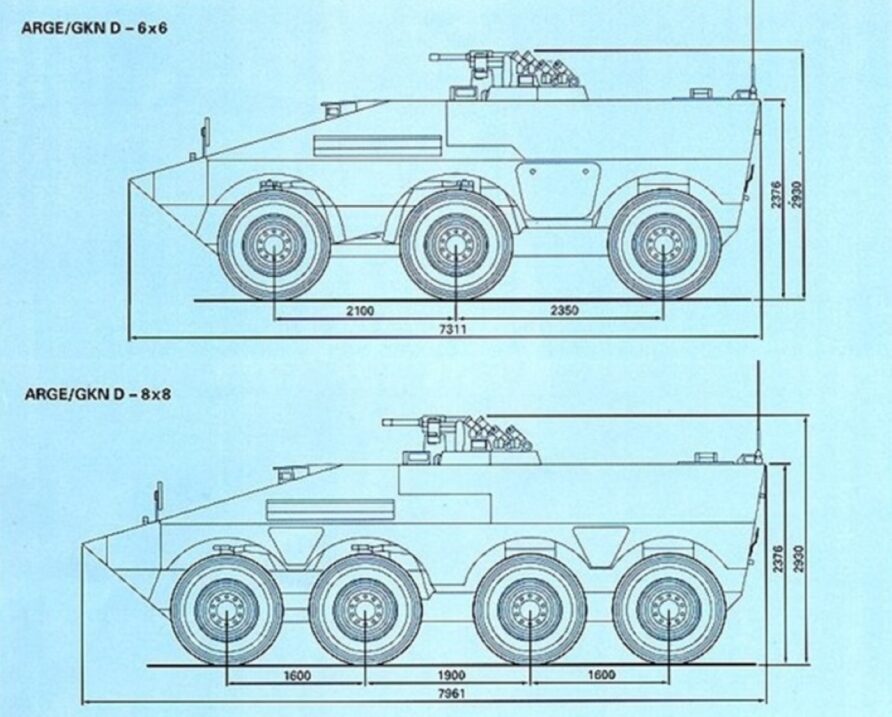
Many variants were proposed.
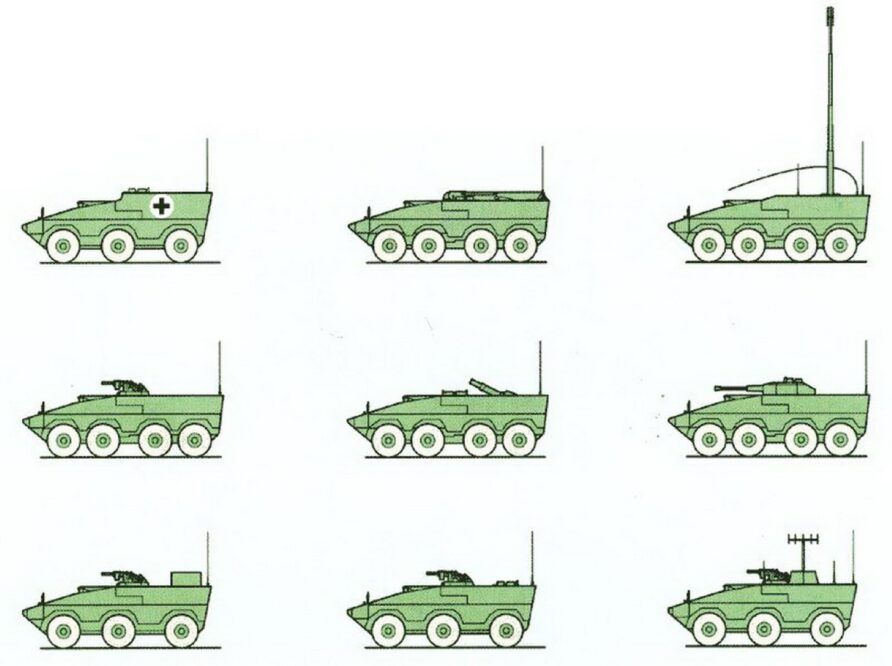
A year after the MRAV winner was announced, a lead nation had not yet been appointed, and there is no doubt that the devil made work for idle hands.
Germany and the UK aligned, while France increasingly moved away from MRAV.
They began to favour a wheeled infantry fighting vehicle, which would work closely with the Leclerc Main Battle Tank, armed with a medium calibre weapon. This role was fulfilled by Warrior and the new Puma vehicle in German service. France was also still smarting from the UK/German decision to insist that GIAT could only be part of one of the competing consortia, despite agreements on manufacturing.
Independently, the French had begun working on the VBM programme, adding an I (Infantry) and creating VBCI.
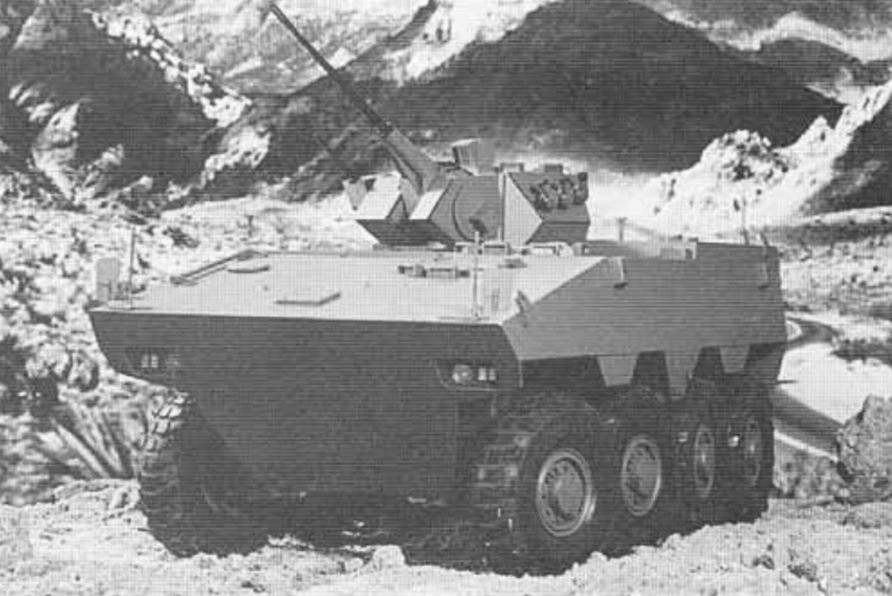
Before MRAV, GIAT wasn’t doing well commercially and the French Government wanted to keep its sovereign production capability.
France left the VBM/MRAV/GTK programme in 1999 to create the VBCI, interestingly, based largely on the Renault X8A, that was not part of the VBM/MRAV/GTK programme.
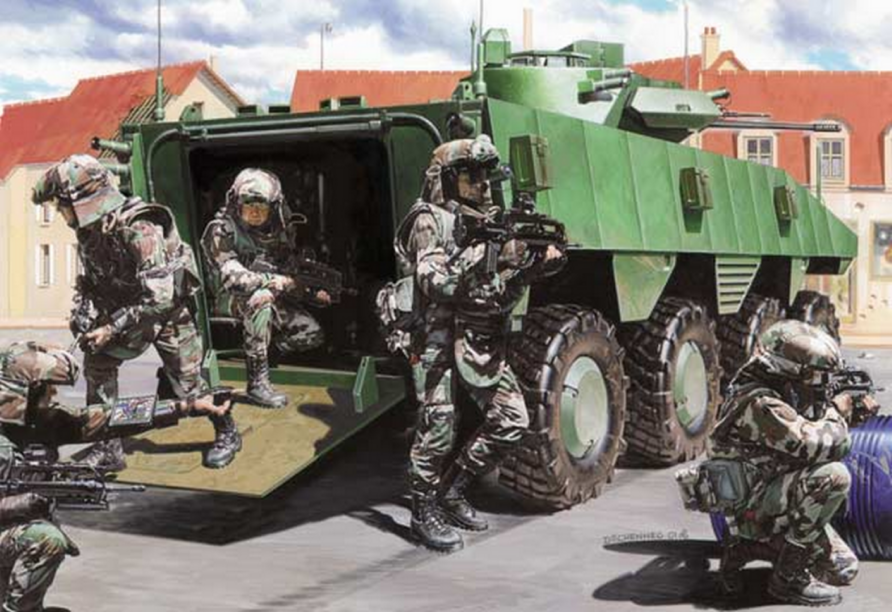
Helio competed for the VBCI turret with their 25 mm Bushmaster armed FVT925, which was shown below on a CVR(T) Scorpion.
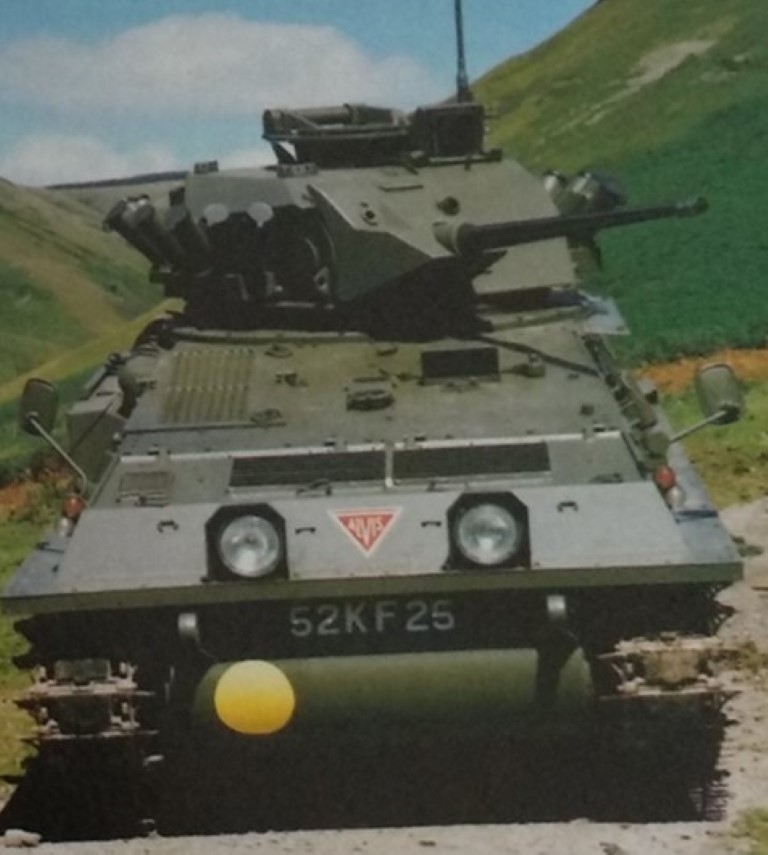
The Direction générale de l’armement (DGA) awarded contracts to GIAT and Helio in 1998 to trials their turrets.
A Side Trip to the Balkans
Although not directly related to Boxer, US operations in the Balkans during the early nineties had created an increasing impetus for change with the US Army’s vehicles.
It was further underlined by the 1999 Operation AGRICOLA. Operation AGRICOLA was the name given to the UK contribution to KFOR. KFOR entered Kosovo on the 11th of June 1999, two days after the adoption of UN Security Council Resolution 1244.
KFOR was to advance into Kosovo via several routes. UK forces were responsible for securing a route to Priština from Macedonia. The crucial Kacanik Defile was included in this route, a narrow gorge with a series of bridges and tunnels. During the rapidly changing time in the lead up to the ceasefire and deployment into Kosovo, as a show of strength and to gain greater influence, 250 Russian personnel in 30 wheeled armoured vehicles moved overnight and took up positions in Priština Airport, blocking access and presenting KFOR with a very delicate situation.
The situation was resolved without any shots being fired, despite some rather aggressive and erroneous directives from General Wes Clarke.
It is a fascinating incident to study. Click here for a good rundown, but what really sent shockwaves around the world was the fact that the Russians had completed a long road march right under the noses of NATO. This one incident would be used as an example many times in forthcoming arguments about medium-weight wheeled forces.
Back to Boxer
On the 5th of November 1999, Alvis released details of the contract:
Alvis plc is pleased to announce that a contract was signed on 5 November between the German and UK MOD, and ARTEC GmbH for the development of the Multi-Role Armoured Vehicle (MRAV.
Alvis is a shareholder in ARTEC, which is a joint venture company established to manage the MRAV programme. The value of the development contract is approximately £70m, and it contains a production option for an initial procurement of 600 vehicles.
The Alvis share of the development phase will be approximately £35m and its share of the initial production phase is expected to exceed £200m. The launch of MRAV is an event of major importance for Alvis.
MRAV is the largest European Armoured Vehicle programme for the next 10 years and beyond, and it will secure and enhance the interests of our employees and shareholders into the long term.
The collaboration with Krauss-Maffei and MaK, the leading land systems companies in Germany, provides an axis for further business development in Europe
The contract covered the full development and a production option for the first 600 vehicles (200 per country) at a value of approximately €750m.
Baroness Symons, the minister responsible for defence procurement, elucidated the announcement as follows:
The MRAV programme strengthens the links between our nations and will provide a springboard for the development of a more cohesive and competitive European defence industry in this sector.
The MRAV programme will provide the British army with a modern and flexible family of armoured utility vehicles that can operate in both high-intensity conflict and in rapid reaction peace support and humanitarian operations world-wide
The base vehicle would use common components, with national-specific variants being produced and assembled locally.
Development of the Eurokonsortium demonstrator was completed.
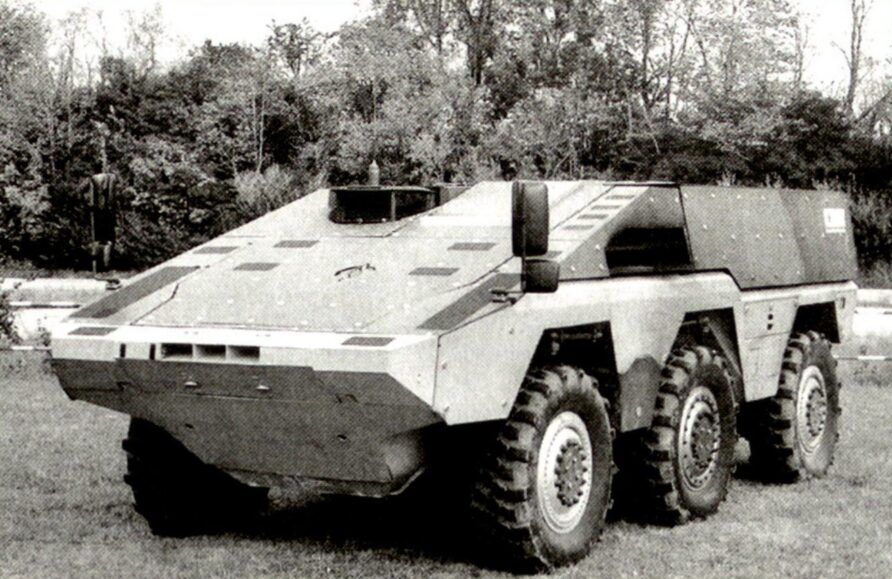
The Netherlands began discussions about joining the programme.
It was decided that the Organization for Joint Armament Co-operation (OCCAR) should inherit MRAV and manage it from there after it gained legal status in 2001.
The joint venture company ARTEC GmbH was formed, replacing Eurokonsortium, which consisted of Alvis Vehicles Ltd, Rheinmetall Landsysteme GmbH, and Krauss-Maffei Wegmann GmbH.
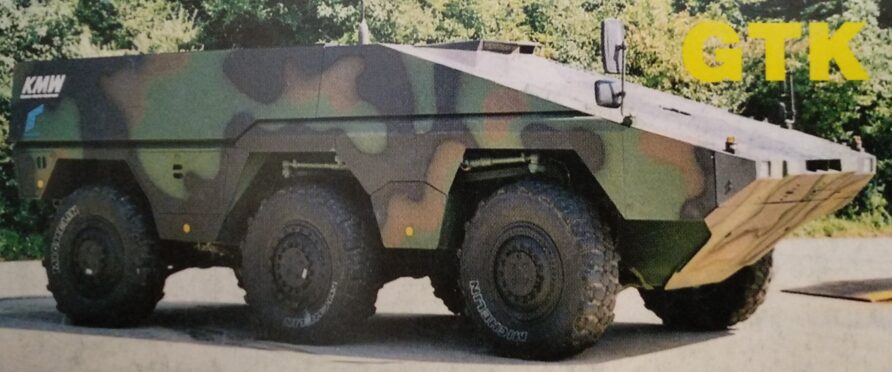
Work continued on the demonstrator.
The Dutch company Stork PWV joined ARTEC in February 2001 to fulfil the Pantser Wiel Voertuig requirement.
An updated logo appeared!
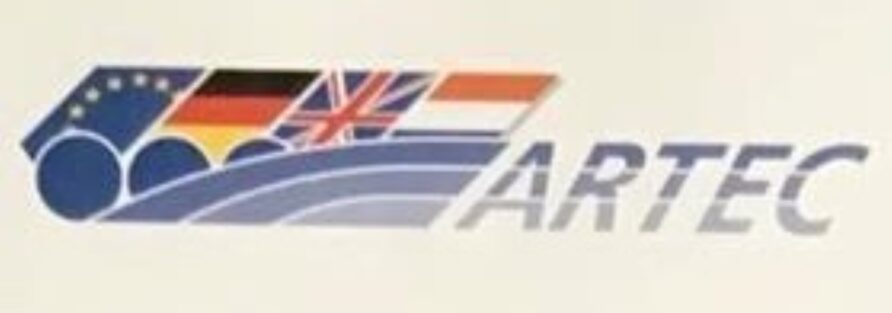
With the 6×6 option gone, all eyes were on the 8×8 variant.
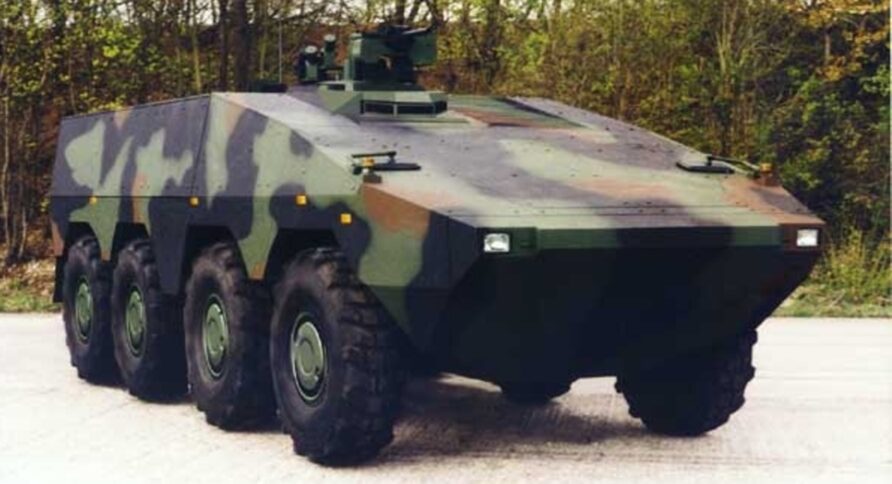
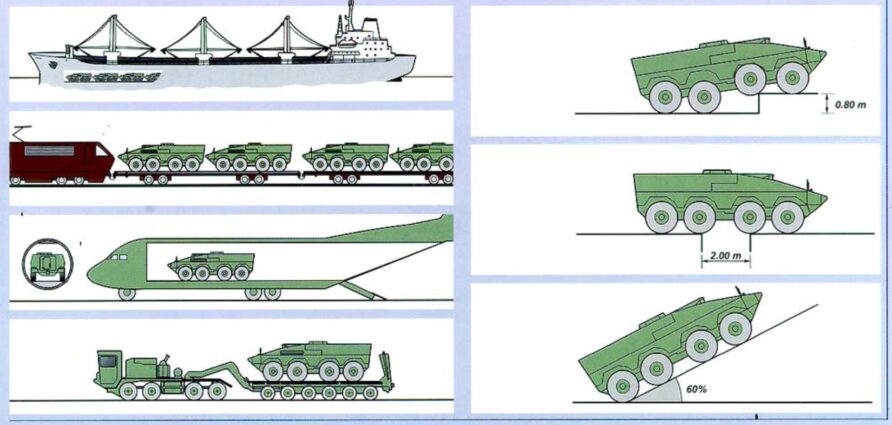
In 2001, the Ministry of Defence requested information from suppliers on how they could contribute to a medium-weight force.
BAE, Alvis Hägglunds, and Vickers responded.
This then happened, and while many would not have realised at the time, it would have a profound impact on US and British Army vehicle programmes.

In 2002, Air Marshal Sir Jock Stirrup was Deputy Chief of Defence Staff for Equipment Capability and Royal Marine Major General Rob Fulton was Director of Equipment Capability for Information Superiority.
Major General Fulton was the one who coined the phrase NEC and produced the NEC plan in 2002. It was endorsed by the Joint Capability Board the same year. In the same period, the Effects-Based Approach to Operations (EBAO) would also be a significant influence on the Future Rapid Effects System (FRES) programme.
The Joint Doctrine and Concepts Centre at Shrivenham, another result of the 1998 Strategic Defence Review, would develop the EBO theory further in the UK.
In 2002, the Director-General of the Joint Defence Command was Air Vice Marshal Ian McNichol.
Would it be fair to say that joint effects-based transformation was being driven solely by the RAF and RN, probably not, but they were very influential and this overall theme would, in turn, influence the Army and its vehicle choices?
While acknowledging the resemblances between FCS and FRES, it’s equally important to note the differences.
FRES saw the network as an enabler, while FCS saw it as the heart of the system. The role of heavy forces was recognized by FRES when FCS was looking to replace the main battle tank concept.
Similar problems often drive different people to find similar solutions. The main changes for both the US Army and the British Army were the same. Even though they had different goals, FCS and FRES were very similar.
Recognising the geopolitical change as a result of the 9/11 attacks, the New Labour government initiated discussions and consultations on a ‘new chapter’ for the 1998 Strategic Defence Review in February 2002.
Following the appalling events of 11 September, the Secretary of State for Defence announced that the Ministry of Defence would look again at how we organise our defence. This will not be a new Strategic Defence Review, but a “New Chapter” building on the review. We need to ensure we have the right concepts, forces, and capabilities to meet the additional challenges we might face from international terrorism.
The MoD requested a new joint approach for FRES from BAE and Alvis in July 2002, with BAE providing systems engineering and Alvis providing vehicle domain expertise.
Alvis was awarded a non-competitive contract by the MoD to develop plans for the Assessment Phase of a future FRES programme.
The target in-service date was set for 2009, seven years away.
If both the Generals commenting above were hoping for a simple solution, they were going to be very disappointed now that the Network Enabled Capability team was on the case.
The Strategic Defence Review – New Chapter was also published in July 2002.
The importance of being able to deploy quickly at a distance was again stressed.
We must retain the ability rapidly to deploy significant, credible forces overseas. It is much better to engage our enemies in their backyard than in ours, at a time and place of our choosing and not theirs. But opportunities to engage terrorist groups may be only fleeting, so we need the kind of rapidly deployable intervention forces which were the key feature of the SDR.
But it also requires the ability to deploy and redeploy rapidly, and it has potential implications for the mix of forces that are used. For instance, some theatres and scenarios, like Afghanistan, may point towards the use of rapidly deployable light forces rather than armoured or mechanised forces and artillery: and we are examining ways of providing such forces with improved mobility and firepower.
Operations in Afghanistan have again demonstrated the key role played by support helicopters. And, as part of our move towards more rapidly deployable forces, we are also pursuing the concept of a Future Rapid Effect System, a family of air-transportable medium-weight armoured vehicles.
We will also be accelerating the introduction of additional temporary deployed accommodation for our troops, and further improving its hot weather capability
The UK’s planning assumptions encompassed a broad range of variants, including but not limited to the armoured personnel carrier, command vehicle, communications vehicle (CommV), mortar carrier (ATV), Anti-Tank Platoon (ATPV), and two configurations of Armoured Treatment and Evacuation Vehicle (ATEV) for a total order of 775 vehicles, replacing FV432, some CVR(T), and Saxon.
54 armoured personnel carriers and 21 command vehicles were defined as the initial capability.
MRAV was intended to be transported by C-17 and the future large aircraft (A400M), but not by the C-130, this flip-flopping between A400M and C-130 turned out to be detrimental.
A great deal of British design expertise was put into MRAV, as well as the concept of operations.
Alvis acquired Vickers Defence Systems from Rolls-Royce in 2002, and the MRAV vehicle was named Boxer.
This was the same Alvis that had also absorbed GKN and was still building the Boxer prototypes.
Alvis also built the first 13 Boxer trials vehicles at its plant in Telford, and designed and built the UK Ambulance and Personnel Carrier modules.
It was doing all this whilst being paid to study a new set of vehicles under the FRES concept.
A June 2003 evidence session at the House of Commons for the Defence Select Committee provided some revealing information on FRES.
Lord Bach: Well, as to the question of whether it is a long way off or not, this is a new generation of capability that we hope to bring in. We are well equipped, we think, at the heavy end and at the light end too, but it is the medium-weight area where FRES fits in and we are moving as fast as we feel we can to initial gate approval and we hope to be able to tell you pretty soon and I will be able to make an announcement soon as to when we will.
There will be some pretty cutting-edge technology with FRES when we decide exactly what it is we want out of this process and with that cutting-edge technology it is absolutely crucial that the design, the technology reaches a certain stage of maturity before we try and apply it to what will be a very expensive and a very important programme which will last for many, many years.
I think it is more important that we get it right than that we rush it in, but we hope there will not be any capability gap. The General will be able to tell you whether there is a risk of a capability gap or not, but we think we have got this about right. General?
Furthermore, in later questions.
Lieutenant General Fulton: You cannot go out into the world anywhere and buy FRES.
The requirement for FRES is very demanding.
What we are seeking to do is to put a medium-weight capability into the field which means getting many of the vehicles down to a C-130 load. We are talking of the order of 17 tonnes. This is not going to be a main battle tank in 17 tonnes because the laws of physics do not allow that.
This is a medium-weight force, but the technology to which the Minister has referred is very demanding and, frankly, I do not know whether it will work because in order to get down there we are dependent, for example, on electric drive, so will that work?
We are dependent on some pretty interesting technologies for protection and survivability where in order to get a level of survivability that is acceptable on the battlefield, there will be some interesting questions on situation awareness, manned and unmanned turrets, for example.
What gives me confidence that we are not dragging our feet is the very, very close link that we have with the American FCS programme which is asking precisely the same questions at precisely the same time, and there are other countries doing the same, for example, Sweden’s SEP programme is also looking at that, so we, in conjunction with the American and the Swedes, clearly have an interest in producing something that is very, very similar.
There were some interesting points to pick out of that.
- The scale of the technical challenge and uncertainty in achieving technology goals,
- Close alignment with US and Swedish programmes,
- Confirmation that FRES was not a 70 tonne Main Battle Tank in a 20-tonne format, but…
- C-130 carriage as a minimum, not Future Large Aircraft as originally
We went from the A400M carriage to the C-130 carriage in less than a year.
The development of the ARTEC Boxer continued, with PT11 below, as built by Alvis in Telford.
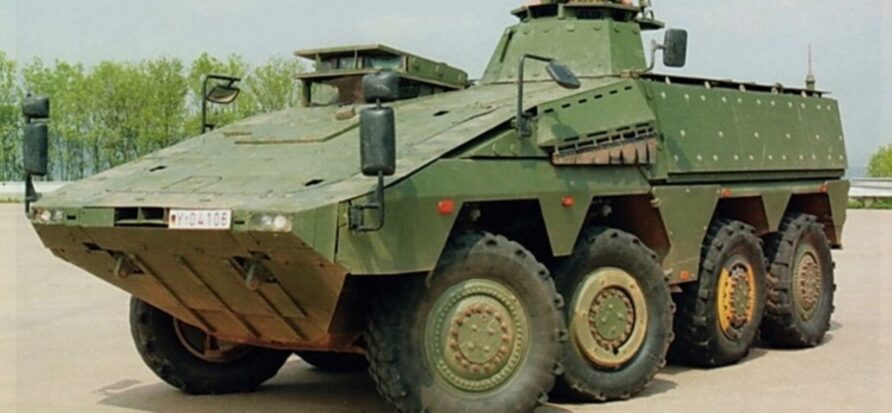
A month later, the UK withdrew from MRAV to pursue FRES, announcing the MRAV decision on July 17, 2003, Adam Ingram said.
Mr Adam Ingram (Minister of State (Armed Forces), Ministry of Defence; East Kilbride, Labour). We regularly re-visit existing plans for capability enhancements to ensure they remain tailored to the security environment in which we need to operate.
As such, we judge that the Multi-Role Armoured Vehicle (MRAV) is not ideally suited to the type of operations envisaged under the Strategic Defence Review New Chapter and other developing policy work. This, coupled with recent operational experience in the Balkans, Sierra Leone, East Timor, Afghanistan and latterly Iraq, has demonstrated the need for rapid deployability in expeditionary operations.
MRAV is not considered able to meet this capability requirement which will be pursued through the Future Rapid Effect System (FRES).
FRES will be a very significant component of the long-term transformation of the land battle through its contribution to network-enabled capability. We have written to the German and Dutch Governments to inform them of our decision to withdraw from the MRAV collaborative project.
This emphasized that MRAV would not meet the FRES requirement because it was too heavy.
Lord Bach, the Minister responsible for Defence Procurement, stated:
The SDR (Strategic Defence Review) New Chapter, and our experience on recent overseas operations, have shown the need for lighter armoured vehicles that can be quickly sent by air to a trouble spot when a crisis breaks
By the end of 2003, the initial FRES contract with Alvis had been ended after the Investment Approvals Board decided not to approve the investment strategy.
The budget line of £1.15 Billion allocated to Boxer production was deleted.
Major General Rob Fulton was appointed to the new position of Deputy Chief of Defence Staff (Equipment Capability) and thought that NEC would be part of every single programme, FRES being no different.
Against this backdrop was Iraq, and an emerging requirement for increasing levels of protection.
Germany and the Netherlands were left as the “none too happy” partners in the MRAV programme, but they kept going and the first production-ready prototype was delivered in December 2003.
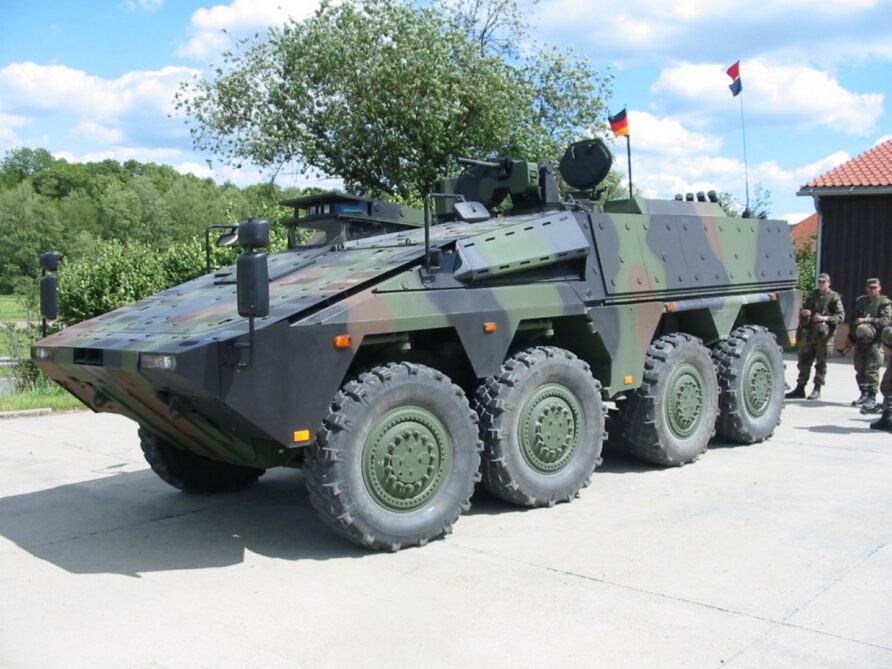
As the first production-ready Boxer model was being unveiled, the United Kingdom published the Delivering Security in a Changing World – Defence White Paper. It repeated many of the arguments found in the SDR New Chapter, but included additional information on medium-weight forces.
UK land forces currently consist of a mix of heavy and light capabilities.
The former offer firepower, integral tactical mobility and protection necessary to carry out ground manoeuvre warfare but require a considerable effort to deploy and support on operations. Light forces in contrast can deploy rapidly anywhere in the world but lack much of the firepower, mobility and protection to conduct decisive operations against an enemy equipped with armour and mechanised forces.
To increase our flexibility in responding to crises, a new set of medium weight forces will be developed, offering a high level of deployability (including by air), together with much greater levels of mobility and protection than are currently available to light forces.
The cost of the UK participation in MRAV was reported as £48 million in 2003. This would rise in subsequent reporting, as it often does.
The first Dutch-made Boxer was unveiled by Stork PWV at the end of 2003.
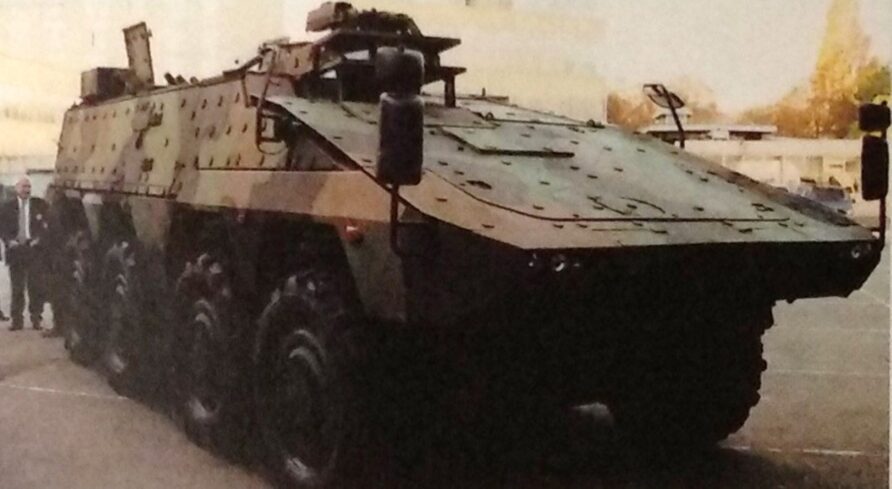
And that was the end of MRAV, at least for the UK.
CVR(T) and FV432 were still in service. Protected mobility, and the words IED and Snatch, were soon to enter the mainstream. The British Army was aligning to the US Future Combat System and saw the 20 tonne plus Boxer as too heavy.
Eighteen years after FLAV, the British Army was no closer to replacing its legacy fleet.
Boxer Round 2 — The FRES Era
There were huge political, social and technological changes that influenced the military theory in the nineties, and they all converged for the UK and US armed forces, in no particular order…
Geopolitics
A change in the political landscape after the Cold War made people think that they would have to intervene in a regional crisis as communism collapsed. This idea was reinforced by the 1998 Strategic Defence Review and the “Force for Good” foreign policy of the Tony Blair Labour Government.
Reductions in the defence vote, from between 5% and 5.5% of GDP in the early eighties to around 3% by the mid-nineties, with further reductions envisaged, legacy heavy forces were rapidly going unfashionable.
Technology
The revolution in microelectronics had provided military planners with a glimpse of the future. Precision engagement capabilities in the Balkans and Gulf War demonstrated how precision could in numerous instances replace heavy massed forces.
The UK took a cautious approach to the US Network Connected Warfare concept, focusing on technology as an enabler, not a replacement for speed, surprise, and superior fighting capabilities.
Deployability
In a political environment where operations would be conducted at arms-length from the USA and Europe, intervention forces could not afford six-month build-up times, like in 1991 in the Gulf. The US experience in the Balkans in the nineties simply reinforced this.
The conclusion drawn was that, in order to have an effect, you must be there.
The Sava River crossing, Task Force Hawk, and the ‘Priština Dash’ all added to the argument that rapid deployment capabilities were essential.
Inter-Service Politics
The Gulf War and UNPROFOR highlighted the continued relevance of traditional heavyweight armoured forces, but the US experience, first with IFOR and the Sava River crossing, and then with Task Force Hawk, left them looking flat-footed and sluggish.
This only served to intensify the conflict between the USAF and the US Army, which has been simmering since the Gulf War.
Meanwhile, the USAF and USN were getting into their precision effects stride, and the US Army knew it had to do better or get left behind in the battle for relevance. With that relevance, funding, the US Army knew it had to do something.
Against this backdrop, MRAV had advanced from FFLAV, linked up with a number of European programmes, got wrapped around the politics of European Union industrial rationalisation, moved close to an agreement, and then cancelled because it did not meet the emergent FRES requirement.
The second attempt at purchasing Boxer comes toward the end of FRES, after FRES experienced a combination of failures and being overtaken by events in the Middle East.
FRES was a response to the perceived requirement for a more mobile force that could swiftly intervene by reducing logistics footprint. For the UK specifically, it was all about ‘jointery’.
Despite the creation of a permanent joint force headquarters in 1994, operations in the Balkans again showed difficulties with coordination across the services.
Joint, expeditionary and the 1998 SDR went hand in hand.
At the beginning of 2004, several important parts of the FRES story were coming together.
The British Armed Forces had firmly adopted the emerging military transformational thinking, Effects-Based Operations, Network Centric Warfare, Agile Forces, and Directed Logistics. Implementation was still yet to be fully realised, though.
Network Enabled Capability emerged as the British version of Network-Centric Warfare. It said that the network would be an enabler of the other three concepts.
In essence, NEC is a tactical internet, the glue that binds the others. Effects-Based Operations, after a shaky start, was renamed Effects-Based Approach to Operations in 2006.
The Snatch controversy was about to break due to the deteriorating security situation in Iraq.
Third, budget pressure within the Ministry of Defense would influence choices on FRES and vehicles for Iraq.
Fourth, continued confusion about what FRES actually was would surface, and the Directorate of Equipment Capability (Ground Manoeuvre) would apparently ignore the Army, who wanted a simple and fast solution for FRES.
Lord Atlee posed a question in the House of Lords in January 2004. The wider concept of FRES was subject to much discussion during the early programme stages.
My noble friend Lord Vivian referred to FRES—future rapid effect system. Our AFV programme seems to be subject to constant revision. Is FRES a platform or a concept? If it is a platform—a vehicle on the drawing board—is it tracked or wheeled? Is it conventionally driven or electrically driven?
The muddle continued.
Mr Andrew Robathan (Blaby, Conservative). To ask the Secretary of State for Defence
(1) whether his Department classifies the Future Rapid Effects System programme as (a) a system and (b) a vehicle;
(2) whether the winner of the Future Rapid Effects System Systems House competition will be disqualified from playing a major role on the industrial side of the programme;
(3) whether the proposed Systems House approach is the preferred way forward for the Future Rapid Effects System programme.
Mr Adam Ingram (Minister of State (Armed Forces), Ministry of Defence; East Kilbride, Labour)
The Future Rapid Effect System (FRES) will provide a family of network-capable armoured vehicles that will form a key part of network-enabled capability. We expect to make an announcement on the assessment phase for the FRES programme shortly
A two-year Initial Assessment Phase contract for the FRES Utility vehicle program was announced by the Minister for the Armed Forces on May 5, 2004.
A year after we had withdrawn from MRAV, we were looking again for a utility vehicle, or as General Walker would describe it, an armoured box on wheels.
The Systems House was to be Atkins, confirmed in August 2004, with the MoD stating that an external and independent project management team would provide significant benefits in understanding the programme risks and recommending an appropriate acquisition strategy.
Essentially, Atkins would be the middleman between the MoD and industry and for the IAP, the MoD expected a bill for £120 million.
Atkins was also tasked to let the competitive Technology Demonstrator Programme contracts to the industry as part of a FRES Integrated Technology Acquisition Plan (ITAP).
Responding to the general confusion about FRES, General Sir Mike Jackson authored the RUSI paper to explain the Medium Weight Capability (MWCap).
He started by explaining there was an increasing requirement to intervene quickly to achieve the early political and military effect and that the key element of MWCap would be FRES but that whilst there would be a resource shift to the medium-weight force, It would not entirely replace light and heavy forces.
This last part is often lost in discussions about FRES.
Much in the article was made of the contemporary operating environment, characterised by a diversity of operational requirements in the same theatre. The ability to ‘nip things in the bud’ by rapid intervention by forces that were more capable than traditional lightweight forces was at the core of the concept.
Although not using the same language as ‘too fat to fly, too light to fight’ it was the same argument that General Shinseki was making for The Future Combat System (FCS) in the USA.
It is also fair to say that he acknowledged the essential ‘work in progress’ nature of the MWCap and that it was about much more than a vehicle replacement programme.
The paper also mentioned Iraq, twice, but not in the context of enduring operations, reinforcing the criticism levelled at MWCap that it was oblivious to what was happening in the Middle East.
In response to a Written Question, the Government confirmed the acquisition costs of FRES would be £6 billion, with through-life costs estimated at £49 billion. In subsequent evidence to the Defence Select Committee, Nick Prest, the then Chairman of Alvis, made somewhat of a large understatement;
in the armoured vehicle area I think it is fair to say that the MoD has had particular difficulty in formulating its requirements, launching procurement programmes and then sticking to them
By mid-2004, the projected In-Service Date for FRES was 2009.
Geoff Hoon announced the creation of the ‘Future Army Structure’ on December 16th, 2004. The announcement started with all the usual fluff about being ready for the challenges of today and tomorrow, being considered the best in the world and, God forbid, the term warfighting crept into the official lexicon.
The major changes described were the cessation of the Arms Plot, a reduction of 4 infantry battalions to 36 and a number of mergers and disbandments.
The Army was to have a structure based on two Heavy Brigades (CR2 and Warrior), 3 Medium Brigades (FRES) and 1 Light Brigade (Boot Combat High) plus Air Assault and Naval Service Commando Brigades.
OCCAR signed a contract with ARTEC in 2004 for the continued development of Boxer MRAV.
Between the issues of the Technology Demonstration Programme contracts at the end of 2004 to the infamous Trials of Truth in 2007, the MoD and Army were trying to deliver the transformation workstream whilst maintaining operations in Iraq and Afghanistan and dealing with an increasing number of Urgent Operational Requirements.
The workload became increasingly unsustainable.
Despite the best intentions of the Army, the whole concept of medium-weight rapid intervention came under sustained questioning as Iraq and Afghanistan stagnated, and with it, arguably, the whole reason for FRES.
At the 5th Annual Future Combat Vehicle Conference at RUSI on June 8th, Brigadier Bill Moore, Director Equipment Capability (Ground Manoeuvre) provided a description of the various UOR’s and capability enhancement in progress and an update on the Medium Weight Capability and FRES.
He confirmed that thinking on C-130 transportability had changed, yet again.
A400M and C-17 will dictate the weight and size limits for FRES. We estimate only seven to seventeen C130’s will be in service by the in-service date for FRES
Another flip-flop on weight and aircraft transportability.
The General Dynamics 8×8 Advanced Hybrid Electric Drive (AHED) test vehicle was also demonstrated in the UK in June 2005.
AHED used a hybrid electric power system and hub motors. A month later, General Dynamics were awarded an 18-month Wheeled Chassis Technology Demonstrator Programme contract by Atkins, the Systems House. AHED had a 500hp diesel engine and a large battery system that powered in-hub electric motors.
BAE established a Future Rapid Effect System (FRES) capture team at Farnborough in the summer to ensure all elements of the BAE organisation could be bought into proposals for future FRES Technology Demonstrator Programme (TDP) contracts.
Thales and BAE teamed up for the Electronic Architecture TDP.
General Dynamics UK had been awarded a chassis TDP earlier in the year, and BAE was hoping for the same. BAE then proposed the Swedish SEP (Splitterskyddad Enhets Platform) or Modular Armoured Tactical System) the programme might be exploited for FRES.
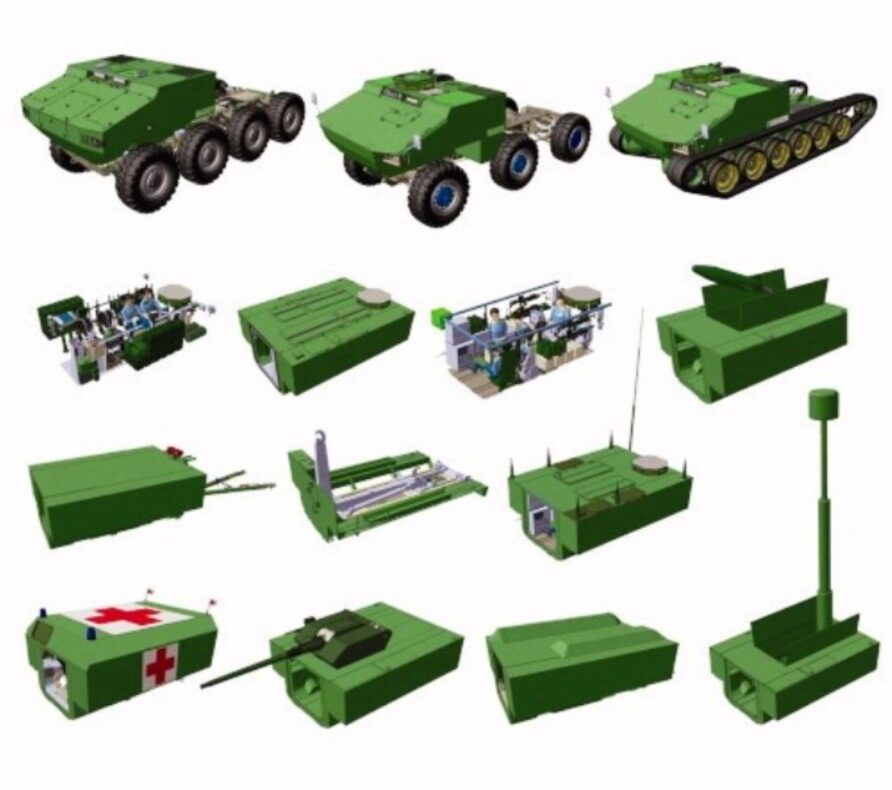
At this point, the tracked and 6×6 platforms were being tested after being funded by the Swedish Defence Materiel Administration (FMV).
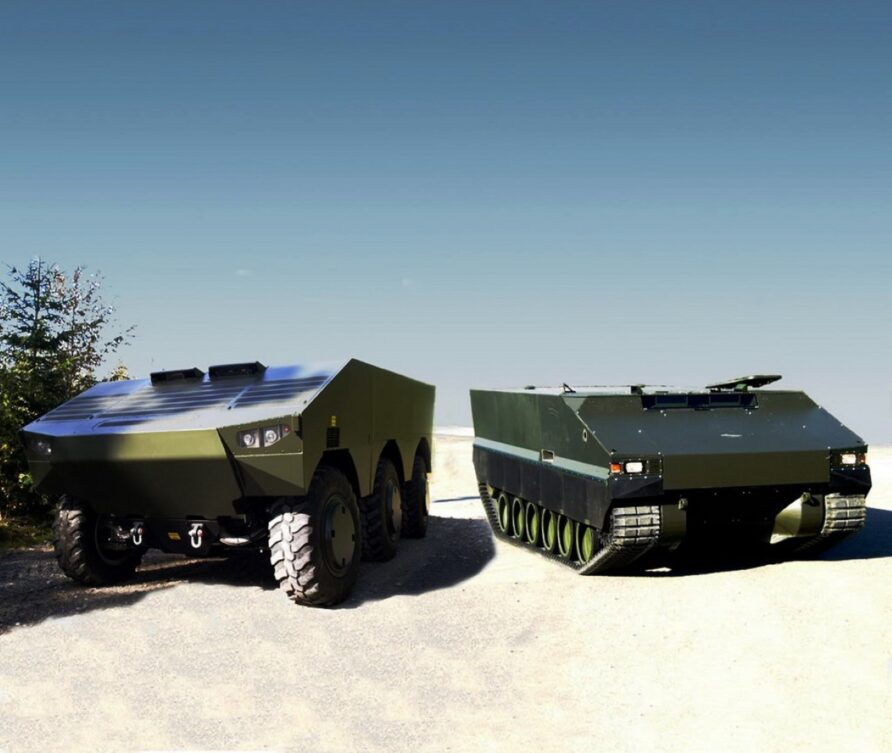
With BAE now owning Hägglunds, the synergies seemed obvious.
The tracked SEP weighed 17 tons, had 6.5 tons of cargo, and could go up to 85 kilometres per hour.
A sophisticated hybrid electric drive and a modular payload system were common to both tracked and wheeled chassis.
During a parliamentary debate on the 28th of June 2005, Don Touhig (Parliamentary Under-Secretary (Veterans), Ministry of Defence; Islwyn, Labour) revealed a number of interesting facts about FRES in response to a question from Ann Winterton MP, reproduced in full below;
It might be helpful if I clarify what FRES is. I shall outline the drivers for the requirement, and give details of the progress that we have made in an immensely complex and demanding programme. The underlying requirement for FRES stems from two strategic requirements. First, we need to replace some of our current armoured vehicles, such as the Saxon, the FV 430 and the CVR(T), and, secondly, we need to develop a medium-weight capability so that we have a balanced force of heavy, medium and light brigades.
FRES will also be rapidly deployable by air at battle group level—in other words, a battalion or regiment-sized force. The strategic defence review and its new chapter identified the need to enhance our expeditionary capability, but since then our thinking has developed further. The 2003 and 2004 defence White Papers clearly explain our vision to develop a highly effective medium-weight capability. As a result of the review, the Army will be rebalanced, reducing the emphasis on heavy armoured forces and increasing the emphasis on light and medium forces.
By ensuring that each deployable brigade is fully manned and has its own integral enablers and logistics, the Army will be better equipped and structured to conduct all types of operations. FRES is at the heart of the Army’s equipment programme and it will have wide uses, not only in the medium forces, but also as a key support role for our heavy forces.
Whether for short intervention operations or enduring peace support, we often need forces with greater firepower, protection and mobility than that of light forces, but with deployability and agility that cannot be achieved by heavy forces. By providing this capability, FRES will underpin the rebalancing of the Army and the development of a truly effective medium-weight force.
In a nutshell, FRES will be a family of medium-weight armoured vehicles of around 20 tonnes, enabled by communications, information and surveillance systems, with the growth potential to develop over time. It will be the central pillar of the Army’s capable and deployable balanced force, which will have a wide operational role, from warfighting to peacekeeping.
To help the hon. Lady, I can say that the issue of whether the vehicle is wheeled or tracked is under consideration as part of the assessment phase we are going through at this time.
FRES will fill a wide range of combat and support roles. Those roles will range from a vehicle to provide protected mobility for infantry, through command and control vehicles, to a new scout vehicle for reconnaissance tasks. These medium-weight armoured vehicles will mean that FRES will be significantly lighter than our current heavy armoured forces based on the Challenger 2 and the Warrior armoured infantry fighting vehicle, but I should make it clear that FRES will not replace Challenger 2, Warrior or the AS 90 guns in our heavy forces.
FRES will take full advantage of investment in our communications and information systems network. We intend that it should be network capable; it will not provide the network, but it will contribute to it. It will make full use of network-enabled capability. By this I mean that it will provide the coherent integration of sensors, decision makers and weapons systems through communications and information systems. That will enable FRES to perform roles such as command and control, dissemination of intelligence and situational awareness and control of firepower.
FRES is a complex and demanding programme. The requirement is broad and covers a wide range of military capability. We will need to take a pragmatic view of how to balance some of the individual requirements, such as combining high levels of protection and low weight, or large capacity and small size. The programme will need to interface with a range of existing and planned equipment if we are to deliver the full benefits.
Beyond the equipment programme, the Army will also need to consider the programme’s wider implications, such as the impact it will have on doctrine and how the Army trains. Given this complexity, we are approaching the programme with a careful, rigorous and objective assessment of the technical options. We will consider industrial issues and the acquisition strategy, as well as the broader implications for the Army of bringing FRES into service and, of course, the risk.
As part of the current assessment phase, which began last year, the FRES integrated project team assisted by Atkins, an independent systems house, is investigating those and other issues to ensure that FRES is cost-effective, value for money and successfully delivered. Until we make the main investment decision, time, cost and performance parameters will not be set. We will take that decision only when we are confident that the programme is mature enough to provide accurate answers to the issues that I have outlined.
The hon. Lady asked whether the 2010 date for the introduction of FRES was purely a coincidence, and from the Government’s point of view, it is. She also asked whether FRES is affordable. Affordability is a key factor in the assessment phase. Costs will not be formally approved until the main investment decision point. We currently expect FRES to have an approximate total procurement cost of £14 billion. The hon. Lady also made some important points about the use of FRES in urban areas, and the lessons that we have learned in recent conflicts will be taken into account throughout the assessment and planning stage.
To take the project forward, we have identified a series of planning assumptions that provide a basis for the planning of FRES and for interacting programmes. As new information emerges from the assessment phase, those assumptions may evolve, but under our current assumptions, we expect FRES to deliver about 3,500 vehicles, with the first variants entering service early in the next decade.
The assessment phase is now well under way, with technology risks being addressed through rigorous systems engineering work and a number of technology demonstrator programmes. So far two such programmes have been placed: a contract for capacity and stowage has been placed with the Defence Science and Technology Laboratory and a contract for defensive aid suites is with Akers Krutbruk. Another five contracts—two for the chassis concept, two for the electronic architecture and one for electric armour are currently being negotiated.
In parallel, the systems engineering work has developed a number of fleet options, which are now being assessed in more depth. The acquisition strategy will be critical to the successful delivery of FRES. Industrial capacity for armoured vehicle design, integration, manufacture and assembly is clearly key to the programme.
In the context of defence industrial policy, we will need to consider a wide range of issues, including employment. We must also assess the importance of retaining a UK industrial capacity and capability which, at a minimum, allows us to maintain and upgrade current and future equipment. The Defence Procurement Agency is currently considering how we can achieve that while delivering value for money.
As the hon. Lady suggested, another issue to consider is the scope for co-operation with other nations, including in the context of the European Defence Agency’s initiatives. We are clear, however, that current FRES timelines must be maintained. No decisions on co-operation between FRES and other nations’ armoured vehicle programmes have yet been made, nor do we expect to make any before the main investment decision point. I should also reassure the hon. Lady that FRES will not be dependent on the European satellite navigation system, Galileo, which is a civil programme under civil control.
FRES is a key programme for the Army and for defence and it is vital to fully achieving our vision of a rapidly deployable medium-weight capability. Its complexity means that we would be rash to rush into decisions before we have fully investigated all the issues. By following best practice, which is enshrined in the smart acquisition initiative, the programme is moving forward and it has considerable momentum. It remains a cornerstone of our future equipment programme.
Since the assessment phase started last year, a huge amount has been achieved. Atkins, the systems house, has been appointed and integrated into the FRES team. The system’s engineering process has begun to narrow down the options, and the development of an acquisition strategy has begun. The technology demonstrator programmes are under way and more will start soon. A wide range of firms were informally engaged through a highly successful industry day in January.
FRES will be an important enhancement to our defence capability, and I hope that, as debate continues, we will be able to share our plans and ideas with people such as the hon. Lady. She has taken a considerable interest in the matter, and, again, I thank her for raising the issue today.
Some important points from that are important.
- The rapid deployed by air element was only at Battalion or Battlegroup level, not, as many have subsequently claimed, whole brigades, for which the UK simply does not possess the air transport fleet for,
- Confirmed of the bulging out of the medium weight capability at the expense of light and heavy forces,
- FRES would be ‘significantly lighter than the current heavy forces and Challenger, Warrior and AS90, which was taken to mean sub 20 tonnes
- An in-service date of 2010 at a cost of £14 billion.
- 3,500 vehicles, taken together with the projected costs, a programme of significant international and industry interest
By the end of 2005, BAE had been awarded the second Future Rapid Effect System (FRES) chassis concept Technology Demonstrator Programme (TDP) contract to investigate the potential for the SEP to increase in weight to 28 tonnes, despite the earlier confirmation that FRES would be around 20 tonnes.
Confusing.
The Integrated Survivability Technology Demonstrator Programme (TDP) contract was awarded to Thales and an Electric Armour TDP to Lockheed Martin.
BAE also won the Gap Crossing and Electronic Architecture TDP’s.
The January 2006 FRES fleet review concluded that no off-the-shelf vehicle would meet the FRES requirement and that the earliest in-service date for the Army’s survivability and growth requirements would be between 2015 and 2018.
The review also concluded that US Stryker could be obtained for the Utility Variant, but it offered insufficient protection, lacked growth potential and the UK would be unable to make any modifications.
Also in March 2006, Janes reported a conversation with Brigadier Lamont Kirkland (Director Land Warfare) that described how the experience of US and British forces in Iraq had led to a major shift in thinking on FRES.
The MoD and industry alike were talking 17 to 22 tonnes for FRES for four years, only in the last four months had those involved with the programme taken a collective leap in sitting levels of protection
The new baseline weight ranged from 25 to 30 tonnes, which was beyond the capabilities of the C-130, but well within those of the FLA/A400M, and, as I’m sure was amusing to many, roughly the same as the Boxer.
General Dynamics and BAE, who were both in the middle of their FRES Chassis Technology Demonstrator contracts, also recognised the new reality.
The General Dynamics AHED 8×8 had completed the second phase of its Chassis Technology Demonstrator programme at 18 tonnes and was preparing for the final stage at an increased weight of 20 tonnes.
Janes went on to confirm;
Before the invasion of Iraq – and more specifically the coalition stabilisation mission that followed and which continues today – the future of the UK’s armoured capability was expected to centre around a medium-weight force of rapidly deployable vehicles. Now, however, the reality of operations in a largely urban environment against an asymmetric threat has forced a complete re-evaluation of the degree of acceptable risk to an armoured vehicle’s survivability.
The vehicles had shifted up several tonnes but doctrinally, it seemed there was little change except for a change to the 17 tonnes variant proposal, it was now 16, having dropped the air defence version.
The Medium Weight Capability strategic goal was defined as:
MWCap is an effects-based military capability made up of Joint Force Elements and optimised for Focused Intervention, Power Projection and Peace Support Operations.
MWCap will be air portable at small scale for rapid deployment within 7 days to the core regions. At Medium Scale, MWCap may act as the first echelon of a larger force.
MWCap will deliver greater lethality, protected mobility and endurance than Lighter Forces, without the deployment, logistic, and support limitations of Heavy Forces.
Although many claimed that FRES was about delivering Brigades by air, it was not.
Air portability rapid reaction was only at a small scale.
The Medium Weight Capability would also provide manoeuvre support to armoured brigades and the whole would be delivered over four steps that include a whole raft of joint capabilities, C-17, BCIP, Watchkeeper and the Future Strategic Tanker Aircraft.
This was joined-up thinking across the whole of defence.
The FRES requirement was now likely to be met by up to three vehicle families with commonality at the subsystem level.
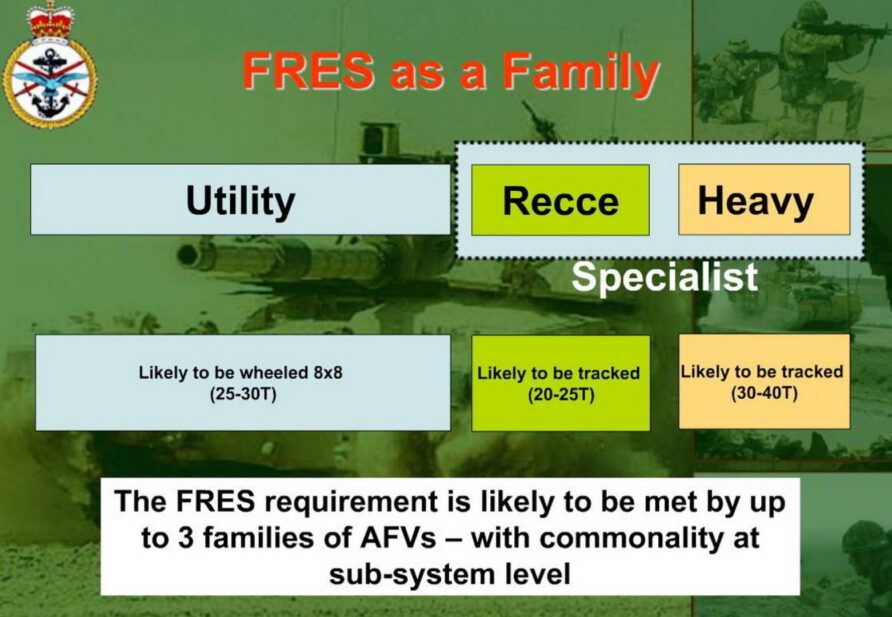
The air deployability requirement was now, again, A400M transport for the smaller variants at a range of 2,000 nm and a target of carriage of the larger variants over the same distance.
The variants and roles for the FRES concept continued to evolve, but initial thinking was based on the following assumptions.
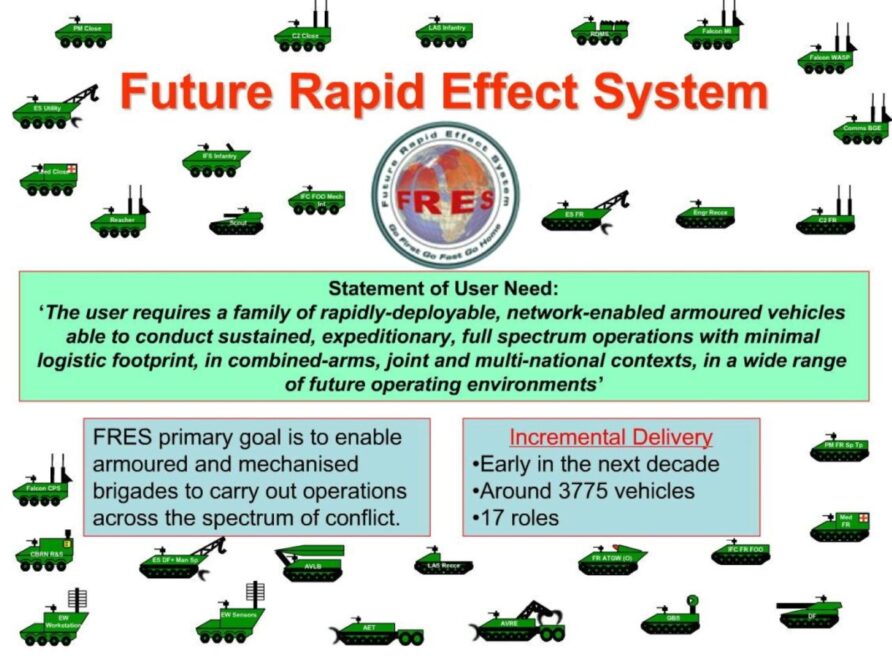
Utility Variant (wheeled 8×8, 25–30 tonnes)
- Protect Mobility Close Support
- Command and Control Close Support
- Light Armoured Support Infantry
- Indirect Fire Control Forward Observation Officer Mechanised Infantry
- Falcon Wide Area Service Provision (WASP)
- Falcon Command Post Support (CPS)
- Falcon Management Installation (MI)
- Communication Reacher
- Communications Battle Group Enhanced
- Command and Control
- Electronic Warfare Sensor
- Electronic Warfare Workstation
- Medical Close Support
- CBRN Reconnaissance and Survey
- Equipment Support Utility
- Route Denial Mine System
Scout Variant (tracked, 20–25 tonnes)
- Scout
- Ground-Based Surveillance
- Indirect Fire Control and Formation Reconnaissance Forward Observation Officer
- Equipment Support Formation Reconnaissance
- Formation Reconnaissance Medical
- Formation Reconnaissance ATGW (Overwatch)
- Formation Reconnaissance Command and Control
- Engineer Reconnaissance
- Protected Mobility Formation Reconnaissance Support Troop
- Formation Reconnaissance Light Armoured Support (Cargo)
Heavy Variant (tracked, 30–40 tonnes)
- Direct Fire
- Equipment Support Direct Fire Repair and Recovery
- Manoeuvre Support Armoured Engineer Tractor
- Manoeuvre Support Armoured Vehicle Royal Engineers
- Manoeuvre Support Armoured Vehicle Launched Bridge layer
The total vehicle count was to be 3,775 over 16 roles, with an estimated price tag of £14.2 Billion.
At Eurosatory in July 2006, BAE showcased SEP, progress was being made on the three 6×6 wheeled and one tracked test rigs with additional FRES funding as part of the Chassis Technology Demonstrator Programme.
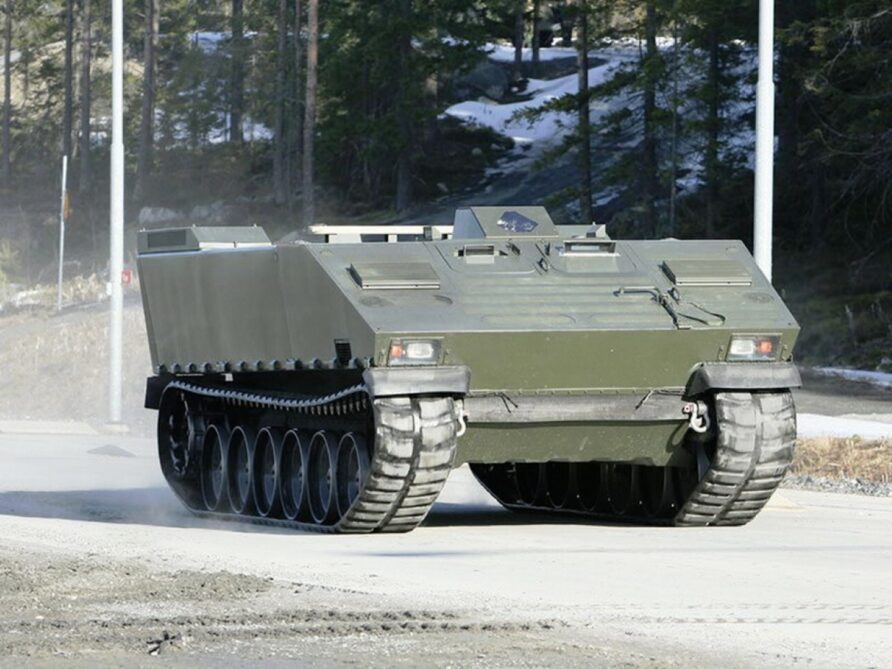
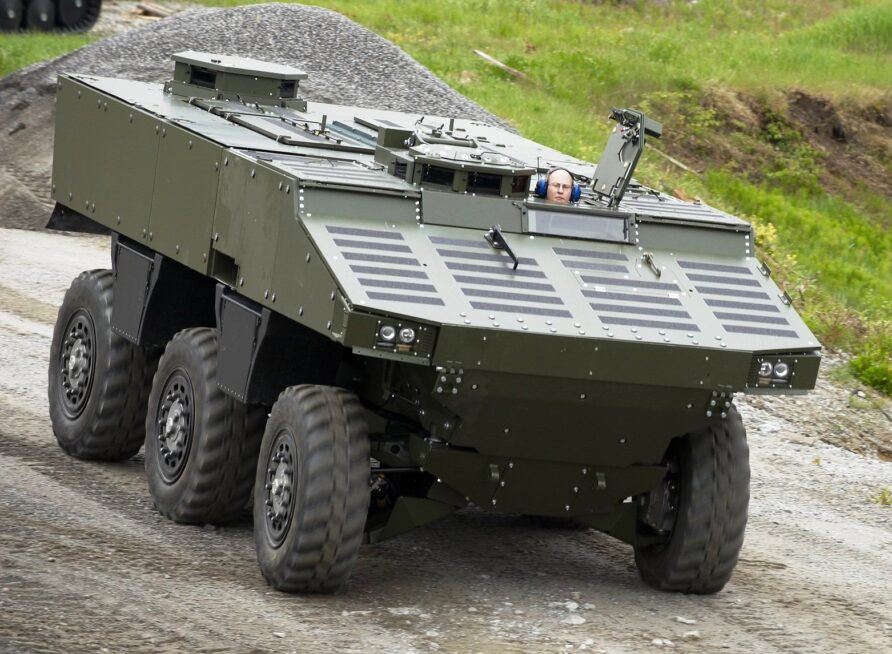
A Frost and Sullivan analyst wrote in a RUSI paper that the FRES increase in ‘weight’ to increase protection was incorrect, and instead, information superiority would provide greater protection.
The US-derived idea that ‘heavier is better’ for stabilisation missions is based on a false premise: it is not that heavier forces are indispensable, but rather that adaptable armour kits and better ISTAR capability to locate and track the enemy will allow for lighter, more easily deployable and adaptable systems without significantly raising the risk profile of a deployed force. Leveraging such information superiority will provide greater force protection as battlefield commanders will be better positioned to dictate terms of engagement to opposing forces, mitigating the effects of lighter armour configurations. This reinforces the view that MoD should look to developing its communications and new ISTAR concept instead of investing in costly bespoke AFVs in the 25–30 tonne range
Another RUSI paper, this time from Atkins, argued, unsurprisingly, for the MoD’s vision of greater protection;
The programme to procure and deliver FRES is about ‘the art of the possible’ and ‘coherence at pace’. There is now real and demonstrable momentum behind this critical programme. The UK MoD is investing today in driving a challenging FRES programme of emerging technology that will give the Army the operational edge needed to confront tomorrow’s threat – ultimately, our servicemen and women deserve no less
General Dynamics opened a FRES UK Joint Programme Office, David Gould and Dr Sandy Wilson presiding.
This period was intensely political, the Government was being accused of neglect and plain old lies by a number of MP’s and commentators, parts of the media were simply repeating MoD media ‘lines to take’, all whilst personnel in Iraq were struggling with an evolving threat and vehicles unsuited to it.
Back in the UK, FRES was chasing moving goalposts.
November 2006 saw another big FRES announcement and further information from the National Audit Office. The acquisition strategy for FRES would be built around three tiers, a Systems of Systems Integrator, Platform Designer, and a Vehicle Integrator or Manufacturer, each one subject to open competition.
When questioned by the House of Commons Defence Select Committee in December 2006, Sir Peter Spencer responded to a question about the value of TRACER and MRAV;
Because the project teams that were available at Abbey Wood would have drawn on the documents and the information which was learned from that work and used it as part of the foundation evidence as they built up their fund of knowledge as to what the requirement was and what sort of technologies were going to be needed to meet it.
One might have reasonably thought that £200m would buy a lot of information and documentation, but as things would pan out, evidently that was nonsense.
In fact, in the MoD’s official response to the select committee, it fessed up;
At this stage, specific pull-through from TRACER and MRAV has been limited
This response also included the immortal line;
Lessons have been learned
Meanwhile, Stork PWV (part of the ARTEC consortium) submitted their best and final offer to the Dutch defence ministry for the supply of 200 Boxer 8×8 armoured vehicles in five variants to start delivery in 2010. Janes reported the VAT inclusive ceiling figure was 503 million Euros.
The ARTEC consortium comprised Krauss Maffei Wegmann (36%), Rheinmetall Landsysteme (14%) and Stork (50%). As part of a wider series of changes and equipment orders, the German and Dutch governments placed a production order for their Boxer vehicles.
The Dutch 872 million Euro order for Boxer covered 472 vehicles, roughly £1.5m each.
Early in 2007, BAE showed their new 8×8 Integrated Demonstrator, a development of the 6×6 SEP.
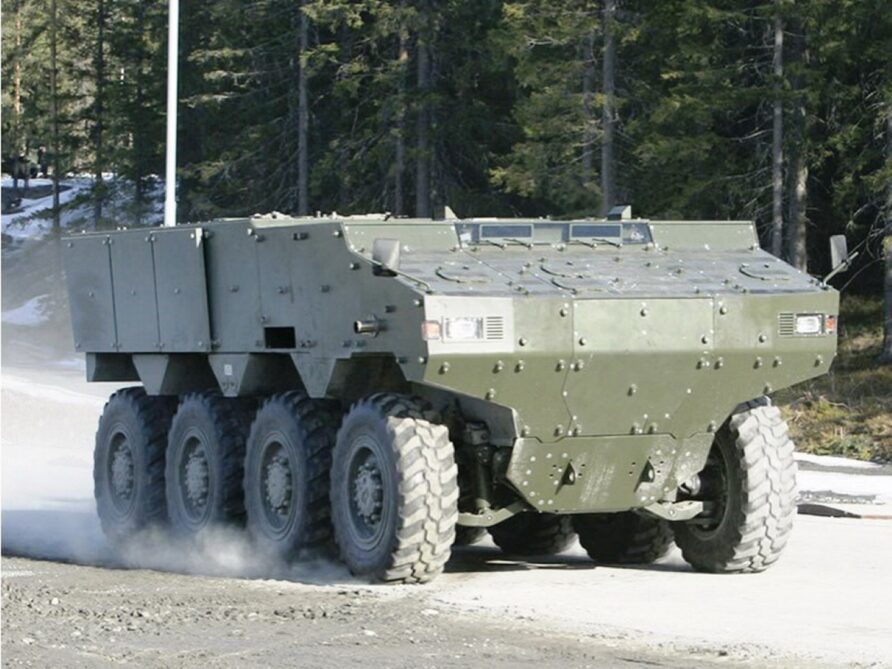
The vehicle had a conventional mechanical driveline but used two diesel engines in the left and right sponsons to provide direct drive to the wheels. This arrangement allowed the driver and commander to sit side by side and provided 13 m³ for the payload.
Also at the start of the year, a number of companies were lining up to respond to the FRES System of systems integrator (SOSI) requirement; BAE, Boeing, Lockheed Martin, SAIC and Thales.
The contract request for the Utility Vehicle integrator was issued in January 2007 with both the System of systems integrator (SOSI) and vehicle designer contracts planned to be awarded later in the year.
Janes reported on the acquisition strategy;
These competitions will result in the selection of one or more UV designs and one or two UV integrators. These selections will inform the generation of one or two UV Provider Teams to bid for the UV Demonstration Phase. There will not be a separate manufacturer competition for the UV programme. The winning party of the UV integrator competition will lead the provider teams and generate “robust” propositions for the demonstration phase while the winning UV designs will conduct ‘trials of truth’ due to take place by the end of the second quarter of 2007
It was envisaged that the initial order would comprise 120 vehicles with a total of 2,000 vehicles required in total, down from over 3,700 only a few months before. On the 6th of February 2007, the House of Commons Defence Select Committee released their report on FRES; The Army’s requirement for armoured vehicles: the FRES programme
Between 2001 and 2003 the MoD commissioned Alvis Vickers to carry out ‘concept work’ on a new programme: the Future Rapid Effect System (FRES). There appears to be little tangible output from this concept work which cost the MoD a combined total of £192 million.
It didn’t improve from there.
A sorry story of indecision, changing requirements and delay
The report detailed much of the FRES background and this interesting statement from Lieutenant General Andrew Figgures CBE, Deputy Chief of Staff (Equipment Capability).
The impression that the Army’s current armoured vehicle fleet lacks sufficient capability for expeditionary operations was reinforced by General Figgures who told us that recent operational experience in Iraq and Afghanistan had demonstrated that the Army needs a medium force “in order that we can fight as we would wish to fight. General Figgures confirmed that Mastiff and Vector were not considered long-term solutions.
…are not armoured fighting vehicles, they are a means of conveying people from A to B [with reduced risk] so they would not do what we require from FRES. They would not be able to carry out offensive action in the way that we would anticipate
FRES was still considered the long-term solution to Army requirements and the protected mobility fleet was for ‘over there’, certainly not how the Army saw it fighting in the future, or how they would want to fight.
The Chief of Defence Procurement, Sir Peter Spencer, was emphatic that FRES and the Protected Mobility vehicles were entirely unique;
These UORs have not impacted on the budget for FRES, full stop.
The four key requirements for FRES were described as:
- Survivability: through the integration of “passive and active armour and other vehicle protection technologies”;
- Deployability: it must be able to be transported by an A400M;
- Networked enabled capability: it must incorporate Bowman and ISTAR and other advanced digital communication systems (both data and voice) to allow full integration of the vehicles into the wider military network; and
- Through-life upgrade potential: It must be capable of being developed and throughout its expected battlefield life of 30 years
Finally, the report reconfirmed the Army’s stance that no off the shelf vehicle available would meet the FRES requirement, for any variant.
The main reason cited was upgradeability over the expected 30-year lifecycle of the vehicles, specifically, 10-15% additional weight growth.
An interesting position given a) the age of the vehicles that were currently in service, b) none of them was specifically designed to be massively upgradeable and c) the difference between in-service weights and current weights of the same vehicles.
As an example of the latter point, Warrior had grown 28% in weight since its introduction and CVR(T), 42%. There was still a great hope that FRES would be a significant export success, despite the preponderance of other similar vehicles on the market. Intellectual Property issues were of great concern because of this, and the MoD was insisting that all IP would be retained by the UK.
There was a lot of confusion about the In-Service Date, and it’s here that the Systems House really showed how important it is to be independent of the MoD.
Atkins submitted evidence to the committee that was crystal clear, FRES could be in service by 2018, but the assertion by the Army and others that 2012 would be a more realistic date was not supported by evidence.
The Chief of Defence Procurement went on record as stating the committee should not be taking Atkin’s view at face value. In evidence to the committee, the professional head of defence procurement did not know about the Alvis pre-assessment contract;
That predates my involvement. I have no recollection of an assessment phase contract being given to Alvis Vickers but I will certainly go away and look up the detail and if I am wrong I will send you a note
It is surprising that the man in charge could only draw from such a narrow knowledge base, the committee also thought the same;
Q52 Mr Jones: Can I say, Sir Peter, I find it absolutely remarkable that you can come here today in charge of this programme and say that you did not know about a non-competitive contract let to Alvis Vickers. I know about it; industry knows well about it.
Sir Peter Spencer: You called it an assessment phase contract and I challenged the fact it was an assessment phase contract.
Q53 Mr Jones: That is changing it. Are you aware of any non-competitive work given to Alvis Vickers in 2002?
Sir Peter Spencer: I am aware there was non-competitive work done before the initial gate.
Q54 Mr Jones: What was that?
Sir Peter Spencer: It was simply pre initial gate phase work.
Q55 Mr Jones: What was involved in that?
Sir Peter Spencer: To set out what the options would be.
Q56 Mr Jones: A minute ago you told us you did not know about it. Now you are trying to describe what went on.
Sir Peter Spencer: I am sorry, I do not mean to be pedantic but you asked me about an assessment phase contract; it was not an assessment phase contract.
Q57 Mr Hancock: What was it then?
Sir Peter Spencer: For the third time, it was a pre initial gate concept phase contract.
Q58 Mr Hancock: What did you get out of that?
Sir Peter Spencer: You get a broad understanding as to the sort of capability, the sort of aspirations that the customer has, the sort of technology which needs to be matured in order to move towards a solution. It is a perfectly normal part of the cycle. It is unexceptional.
Q59 Mr Jones: Sir Peter, that is not true, I am sorry. If you are sitting here today and telling us that that was just part of this entire process, that is not the case. Alvis Vickers were livid when you severed that contract because they were under the impression that FRES was going to be a non-competitive process and that work was part of what they thought was the start of the actual process. I understand and they can supply the information to us if you want that something like £14 to £20 million was spent in that phase. What happened to that work? It is no good coming here trying to wriggle out of it and say to this Committee firstly that you did not know what was going on and the next thing trying to explain what went on.
Sir Peter Spencer: Chairman, do I have to be on the receiving end of quite so much provocation? We could have quite a sensible and illuminating discussion.
Q60 Mr Jones: We could if you answered the questions but you do not.
Sir Peter Spencer: It is the way they are framed, I am afraid, which is extremely provocative.
Q61 Mr Jones: I am sorry, but you cannot come to this Committee if I ask you a question and say to me firstly it did not exist and then in the next breath, when you start trying to wriggle out of it, try to say to me that you were completely aware of this.
Sir Peter Spencer: I am not trying to wriggle out of anything.
Of course, Sir Peter was correct, technically.
The contract to Alvis was for a Concept Phase activity, not an Assessment Phase activity.
However, it is hard not to sympathise with the Committee’s view that this was an evasive answer that showed them little respect.
It also seemed that the underpinning FRES requirement had changed, from General Figgures;
I am in danger of repeating what he said but FRES is required as a replacement armoured vehicle in the armoured brigades and to equip the medium weight brigades, now known as the three mechanised brigades. It is required to enable the armoured brigades to fight conventional wars, rather as we saw in TELIC 1, and it is required to enable the mechanised brigades to both support the armoured brigades with what we in the Army would say a manoeuvre support brigade, and also to be deployed in peace-keeping and peace enforcement operations. So there is a balance of capability between those two and the tactics, techniques and procedures which are used in those instances are subtly different because of the rules of engagement and so on and so forth.
By May 2007, ARTEC was nearing delivery of the first Boxer vehicles for the German Army.
Confirmed orders at this point were;
- Germany; total 272 vehicles in three variants. 135 armoured personnel carriers (APCs), 65 command post (CP) variants and 72 armoured ambulances.
- The Netherlands; total 200 vehicles in five variants; 55 Command Post CP, 58 ambulances, 27 cargo vehicles, 19 cargo/command and control vehicles and 41 engineer group vehicles
2007 marked the end of the FRES Technology Demonstration Programmes.
- Hard kill defensive aids system TDP (May 2005 to December 2006) Akers Krutbruk Protection AB
- Electric armour TDP (January 2006 to June 2007) Lockheed Martin INSYS
- Integrated survivability TDP (January to December 2006) Thales
- Chassis concept TDP (August 2005 to March 2007). General Dynamics AHED (Advanced Hybrid Electric Drive)
- Chassis concept TDP (August 2005 to March 2007) BAE SEP
- Gap crossing TDP (January 2007 to September 2007) BAE
- Stowage and capacity TDP (February 2005 to May 2006) Defence Science and Technology Laboratory (DSTL)
- Electronic Architecture TDP (August 2005 to March 2006) Lockheed Martin UK
- Electronic Architecture TDP (August 2005 to March 2006) Thales
Lord Drayson had insisted that the MoD stick to the FRES(UV) 2012 In-Service Date, despite what Atkins said, and pushed hard to give the Utility Variant some momentum.
Given the political situation regarding protected mobility, the desire for an off the shelf vehicle was pushed to the front. Instead of a completely bespoke vehicle that would not be in service by the new target date of 2012, the new position was a modified military off the shelf vehicle, an evolution of existing designs.
This was a marked change from the fleet review conclusions that only a bespoke vehicle would meet the requirement as described in evidence to the Select Committee that was adamant no production vehicle would do.
The market was assessed, all 8×8 vehicle manufacturers invited to provide information and three vehicles were selected to go forward to the so-called ‘Trials of Truth’ in summer.
The Patria AMV and Iveco Freccia were assessed but not selected to go forward to the trials.
One of the Boxer prototypes in APC configuration would participate in the Trials of Truth, joined by a Véhicule Blindé de Combat Infanterie (VBCI) from Nexter and the General Dynamics Piranha V.
The Ministry of Defence (MoD) has selected the vehicles that will participate in trials for the utility variant of the Army’s Future Rapid Effect System (FRES) later this summer. The selected designs are BOXER (ARTEC), Piranha (GD UK) and VBCI (Nexter). The outcome of the trials will be announced by the end of November, when one or more utility vehicle designs will go forward for detailed assessment.
The FRES family of vehicles is vital for the Army of the future. They will have high levels of protection and will also be air-transportable, allowing troops to deploy rapidly across the globe at short notice.
Defence Minister Lord Drayson said:
“My highest priority is to ensure that our Forces have the equipment they need to achieve success on operations today, tomorrow and in the future. FRES has a vital part to play in the future of the British Army. I signalled my commitment to the FRES programme last year and this announcement provides tangible evidence of progress. The selection of these designs for inclusion in the utility vehicle trials is a part of the competitive acquisition strategy developed to ensure that we deliver the best solution for the Army.”
”General Sir Richard Dannatt, Chief of the General Staff, said:
FRES is my highest equipment priority and I am determined that we will make this programme a timely success – it is at the heart of the future Army. I am therefore very encouraged by the significant progress that has been made in identifying the three best candidate vehicles for us to trial this summer and I look forward to maintaining this momentum in the programme to the next decision point by November this year. We need to take this exciting project forward, together with our industrial partners as soon as possible.”
In addition to the utility vehicle design competition, the Ministry of Defence is also running competitions to select a company which will work with the designer to integrate key systems onto the vehicles, and a company that will have strategic oversight of the entire FRES programme and its links to the existing fleet, known as the system of systems integrator. In a clear sign of the MoD’s commitment to drive the FRES programme forward, contracts for this work will be awarded within 12 months.
The FRES programme will equip the Army with a range of new vehicle types over and above the utility variant. This includes reconnaissance, direct fire, and engineer support vehicles. These will also be open to competition from industry
The Chassis TDP’s had cost the MoD considerable sums, and both General Dynamics and BAE had also invested their funds in AHED and SEP respectively.
Because of the timeliness pressure from Lord Drayson, time into service was to be a significant driver for FRES.
Instead of developing a vehicle for FRES UV, the MoD would now simply buy one off the shelf and modify it to suit, no more SEP, and no more AHED.
Iraq, time, and physics had defeated the sub twenty tonne goal, the British Army needed a vehicle and needed it fast, and its weight was of less importance.
The Trials of Truth took part at the Armoured Trials and Development Unit at Bovington in late summer 2007.
Shown below are the Boxer, Piranha and VBCI. It is noteworthy that the General Dynamics vehicle was a Piranha Evolution, an interim design, and not the Piranha V, and Boxer was one of the initial prototypes.
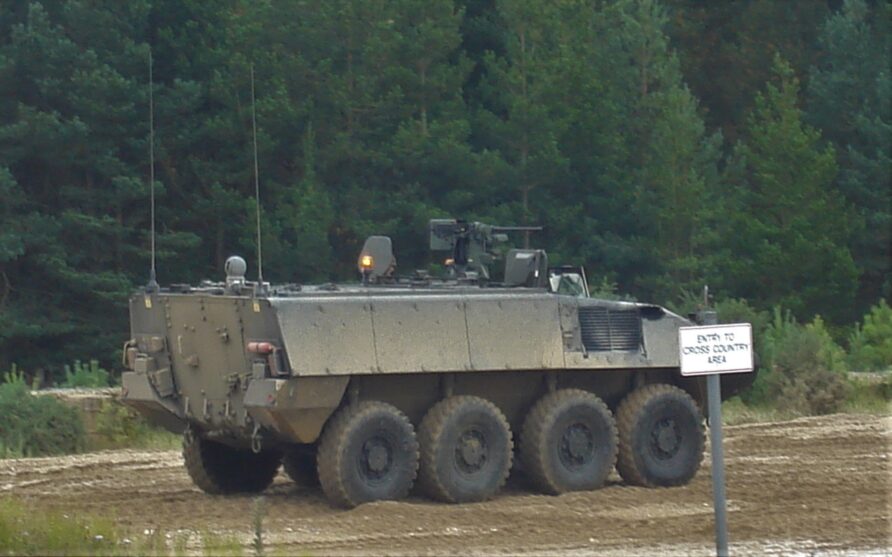
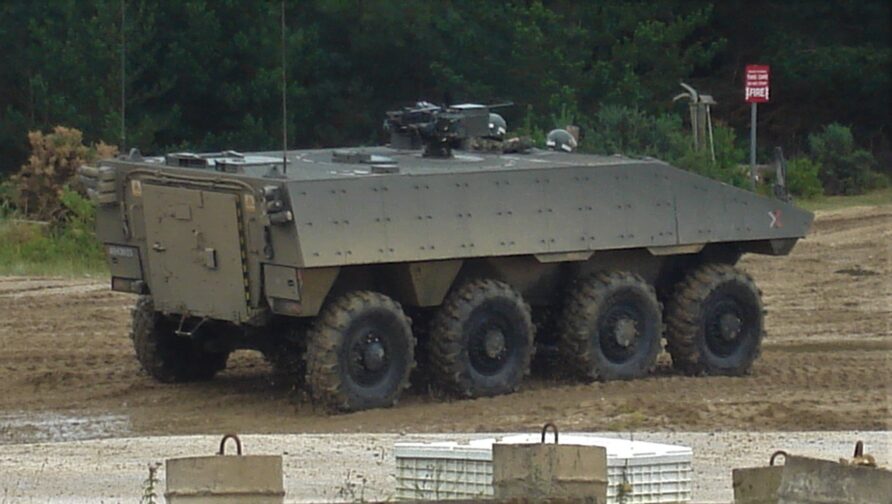
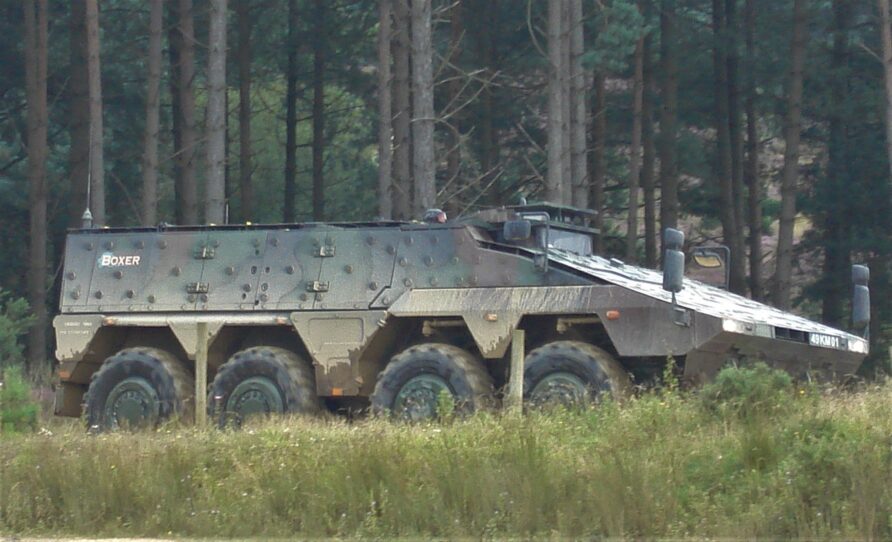
With the trials complete, the industry waited on the MoD’s decision.
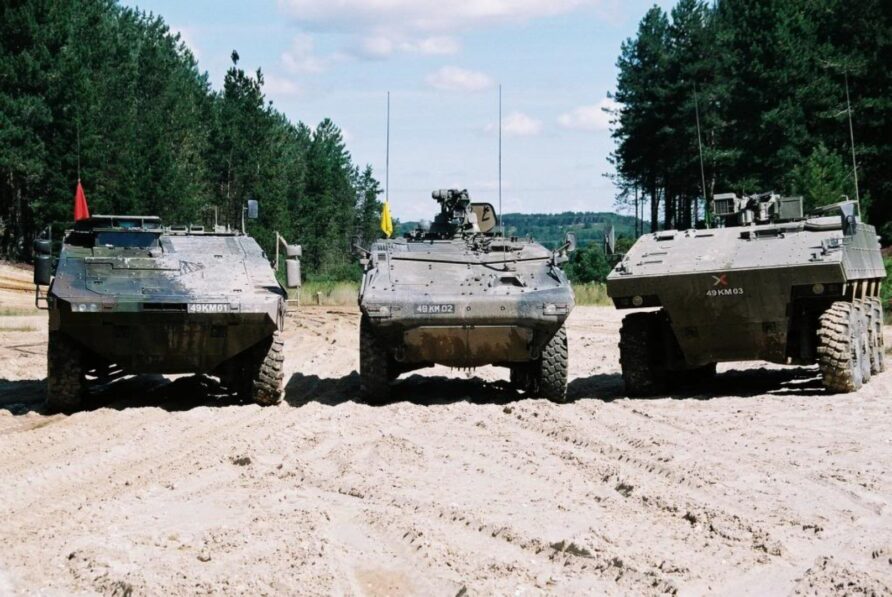
Lord Drayson resigned from office in November 2007 after a series of reported ‘blazing rows.’
It was speculated that he was prevented from applying his considerable commercial experience to the government environment, in effect, the Civil Service had seen him off.
Lord Drayson had previously prevailed over the Permanent Under-Secretary, Bill Jeffries, on the selection of the Thales/Boeing team as preferred bidder for the prized FRES System of Systems Integrator without a formal competition.
This was another blow for BAE. Bill Jeffries sided with the Army, Lord Drayson wrote to Des Brown (Secretary of State for Defence), laying out the impasse. Des Brown backed Bill Jeffries and the Army, Lord Drayson walked.
Baroness Taylor of Bolton succeeded him.
On the FRES Utility Vehicle (UV) requirement;
- 1988, FFLAV, a wheeled utility vehicle between 14 and 19 tonnes
- 2003, MRAV, a wheeled utility vehicle between 25 and 30 tonnes, was cancelled because it was too heavy, cost £57 million
- 2006, FRES aspiring to a wheeled utility vehicle between 25 and 30 tonnes.
- 2006, the Germans and Dutch placed a production order for MRAV Boxer, a wheeled utility vehicle between 25 and 30 tonnes
The cost to get to these conclusions, roughly £200m, or about 130 Boxers if anyone is counting. This figure does not include money spent on FRES, either.
The Defence Select Committee published their Defence Equipment 2008 report on March 11th, in evidence to the committee, the MoD made this statement on FRES;
Real progress has been made on FRES. Implementation of the FRES competitive Acquisition Strategy is being driven hard to ensure we deliver, as early as possible, a FRES capability that meets the Army’s needs through life
Further evidence to the committee raised the same issues of upgradeability through life that had been emphasised in previous submissions;
Mr Holloway: Notwithstanding your comments about adapting it through its life, you are buying something now against a range of threats as yet unknown, which tries to do absolutely everything. Surely, given the gigantic cost of this I still do not understand why you would not be better getting the best available thing at the time in specific numbers?
Lieutenant General Applegate: What we have done is to identify what we believe is the best available developmental vehicle in the market place that has a future. The alternative is to buy something that is basically a cul-de-sac and goes nowhere; it cannot be upgraded and cannot meet the threats over time.
We believe that we have now identified that particular preferred design for the utility vehicle and we are confident that in conducting what is an aggressive programme to deal with some of the technological risks to produce something as early as we know the Army wishes which will provide a level of capability that is far in excess of what we have today in order to meet those threats and, importantly, that it would have growth.
If we bought something now literally off the shelf effectively we would have to shoe-horn in, as we do on UORs at the moment, a series of subcomponents in a very poor fashion and it would have very limited life, so it would be a bad decision. The Army is quite convinced about that, and there is a decision as to whether you literally buy off the shelf, assuming there is the ability to ramp up production, or have something that gives the Army confidence will grow through life.
We must have that confidence if we are to grow. One of the things we have noted with the current range of vehicles is that we tend to have them for a long time and increase their capability over time. We also have tended to increase their weight, their demand for power, the levels of protection and the other elements we put on them. To try to do that with an off-the-shelf system at the moment would be a recipe for disaster
Given that both VBCI and Boxer were practically off the shelf and Piranha V was ‘developmental’ the writing was on the wall for VBCI and Boxer.
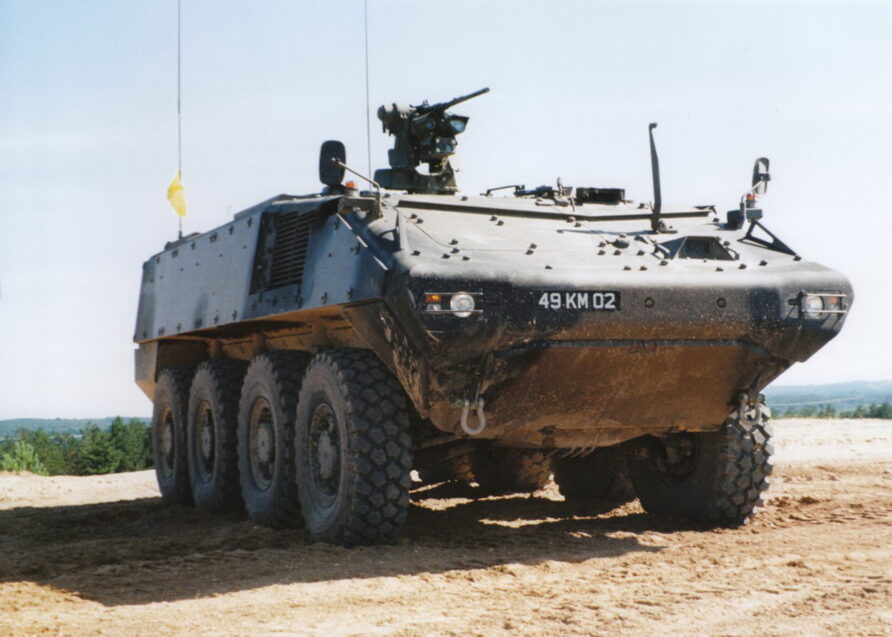
Many commenters asked why to bother with testing VBCI and Boxer if the Army was set on a development vehicle.
Following BAE’s continued investment in SEP, a demonstration in April 2008 showed off one fitted with active protection from ADS GmbH.
The trial demonstrated a successful defence against two RPG-7 warheads.
In early May 2008 came the announcement everyone had been anticipating, the General Dynamics Piranha V was selected as preferred bidder for the FRES Utility Vehicle.
General Dynamics United Kingdom Limited, a wholly owned subsidiary of General Dynamics (NYSE: GD), has been selected by the UK Ministry of Defence as the provisionally preferred bidder for the Utility Vehicle Design (UVD) for the Future Rapid Effect System (FRES). Subject to satisfactory completion of the package of work on risk reduction and confirmation of preferred bidder status the team, led by General Dynamics UK Limited, will develop the PIRANHA V as the FRES Utility Vehicle for the British Army. The company will now enter negotiations with the MoD to determine the scope of development work required.
Dr Sandy Wilson, president and managing director, said: “We are delighted that PIRANHA V is the British Army’s choice for the FRES Utility Vehicle. With over 9,000 PIRANHAs already in service, the family’s pedigree speaks for itself. We have continued development work at our own initiative, and we will work closely with the Ministry of Defence to de-risk the programme. At the same time, we will be continuing our strong bids for the Utility Vehicle Integrator (UVI) role and for the follow-on FRES Specialist Vehicles (SV).”
PIRANHA V will deliver an extremely reliable platform with superb protection and mobility to meet the Army’s FRES requirement, together with the necessary growth potential to meet future challenges. General Dynamics’ comprehensive experience of delivering wheeled armoured fighting vehicle (AFV) programmes to tight timelines reduces potential risk considerably and will be invaluable in delivering PIRANHA V to the MoD. The vehicle offers a cost-effective and robust solution that complies fully with the Defence Industrial Strategy.
General Dynamics released two images of the proposed Piranha V design that showed a number of differences from the vehicle that participated in the Trials of Truth; different side armour, a more angular nose, remote weapons station and active protection equipment.
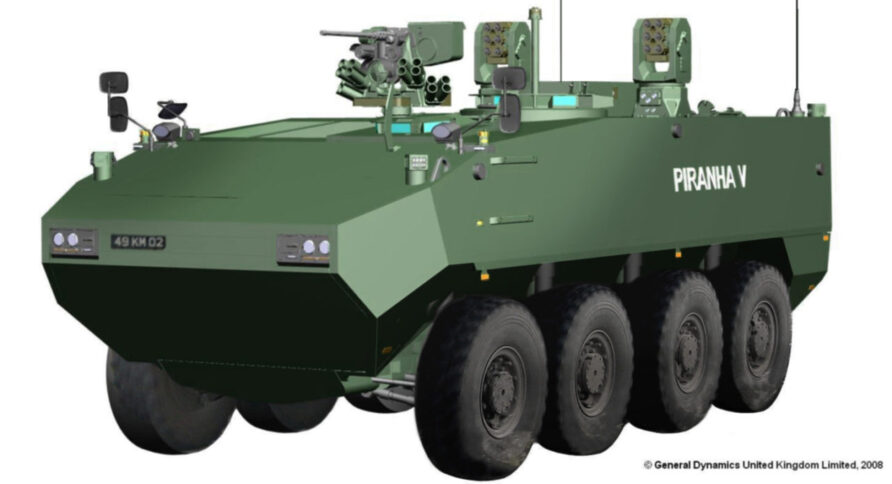
A preferred bidder was not a contract award though, the MoD and General Dynamics then entered into a period of negotiation covering many issues but especially, intellectual property. Also of note, the fact that the scope of development work had yet to be determined.
The Lord Drayson goal of meeting the 2012 In Service Date with a non-developmental vehicle was ditched, the British Army seemingly went back on that, returning to a development vehicle, or at least a development of an existing vehicle.
Meanwhile, in the USA, a seismic shift was about to take place in the Future Combat System (FCS) programme.
After being restructured in 2007 in response to the requirements of operations in Iraq and Afghanistan, the new Defense Secretary (Robert Gates) was about to mark the card of the FCS. Delivering a speech in Colorado in May, Robert Gates vented his frustration with the US military:
I have noticed too much of a tendency toward what might be called ‘next-war-itis’ — the propensity of much of the defense establishment to be in favor of what might be needed in a future conflict. It is true that we would be hard-pressed to launch a major conventional ground operation elsewhere in the world at this time — but where would we sensibly do that?
Smaller, irregular forces — insurgents, guerrillas, terrorists — will find ways, as they always have, to frustrate and neutralize the advantages of larger, regular militaries, and even nation-states will try to exploit our perceived vulnerabilities in an asymmetric way, rather than play to our inherent strengths. There have been 150-plus attacks so far on MRAPs and all but six soldiers have survived,” Gates, these vehicles are saving lives.
That is the war we are in. That is the war we must win.
FCS was no longer the flavour of the month.
Although FCS and FRES had diverged, this and continued accusations that the Army was not funding protected mobility vehicles because they were preserving funding for the next war and FRES meant the implications were, again, obvious. The accusations were made by many, putting shiny new vehicles over ‘protecting our boys’ was a common media theme.
FRES was in trouble.
Making the assumption that future operations would include more Afghanistan than the Gulf War, the MoD published the Defence Strategic Guidance document in June. Although the full spectrum combined arms operations were still considered an important capability to retain, the DSG focussed on enduring stabilisation of counterinsurgency type operations.
Preferred bidder status was withdrawn from General Dynamics in December 2007, with the MoD citing an inability to come to an agreement with General Dynamics on commercial and intellectual property issues.
In a series of wider changes, the System of Systems Integrator was also removed from the programme.
In a December 11th 2008 statement to the House of Commons, John Hutton, the new Secretary of State for Defence, said;
We undertook to inform Parliament about the major decisions emerging from our examination of the equipment programme as soon as we were able to do so. The following are the key conclusions.
In May 2008, we announced the provisional selection of Piranha V, offered by General Dynamics (UK) Ltd, as the preferred design for the FRES utility vehicle. Following a period of intensive negotiations with General Dynamics to address a number of commercial issues, it became clear to both parties that it would not be possible to reach agreement on the commercial conditions required to enable further progress on the basis of the current procurement strategy. I have therefore decided that we should withdraw General Dynamics (UK)’s provisional preferred bidder status.
Our examination of the equipment programme has, separately, considered the balance of investment and priority in the army’s armoured vehicle programme. We have concluded that, in the context of current operations, and bearing in mind the considerable recent investment in protected mobility, the highest priority should now be accorded to delivering the warrior capability sustainment programme and the FRES scout vehicle as quickly as possible. Against that background, we have decided to restructure the FRES programme, giving priority to FRES scout over the FRES utility vehicle. Whilst this will mean a delay to the programme, we recognise the importance of the utility vehicle and are now looking at the best way to take this procurement forward. General Dynamics (UK) will have an opportunity to compete in any future utility vehicle competition.
The National Audit published their annual tale of woe on the 18th of December, otherwise known as the Major Projects Report. The cost of the FRES Assessment Phase had risen by £206 million to £319 million, due to the Specialist roles now being included in the Assessment Phase.
This document also noted that FRES would now meet 16 roles and comprise five families of vehicles:
- Utility
- Reconnaissance
- Medium Armour
- Manoeuvre Support
- Basic Capability Utility
No mention of the major decision on the Utility variant though, but for Boxer, its second association with the British Army was finished.
The 2009 FRES programme got off to a cracking (not) start as the Defence Select Committee published its Defence Equipment 2009 report in February.
The FRES programme has been a fiasco.
In February 2007 we concluded that the MoD’s attempts to meet its medium-weight vehicle requirement had been a sorry story of indecision, changing requirements and delay. Two years later the story is, incredibly, even worse. We find it extraordinary that, some seven months after announcing General Dynamics UK as the provisional preferred bidder for the FRES Utility Vehicle, the MoD has announced that priority is now to be given to the FRES Scout Vehicle. Whilst we recognise that the MoD’s equipment requirements need to reflect changing threats, that is no excuse for the MoD’s behaviour in this programme; they have wasted their and industry’s time and money. The FRES Utility Vehicle programme was, from the outset, poorly conceived and managed. The MoD must work out what its requirements are for medium-weight armoured vehicles and identify lessons from the saga of the FRES Utility Vehicle programme.
In March, it was announced that FRES Specialist Vehicles would be obtained in a single programme, this would go to become Ajax.
The MoD responded to the Defence Select Committee’s scathing Equipment Report in May.
On the accusation that the MoD could not hit water if it fell out of a boat, it said this:
We do not accept this conclusion
And went on to state:
Defence has invested significantly in Protected Mobility (PM) in the recent past, however the PM package has never been designed as a substitute for the Utility Vehicle (UV) programme; indeed, it has been designed to cater for the specific operational requirements of Iraq and Afghanistan, and the capability delivered falls significantly short of the stated UV requirement to deliver the medium component of the Balanced Force through the FRES programme.
In May 2008 we announced the provisional selection of Piranha V, offered by General Dynamics (UK) Ltd, as the preferred design for the FRES UV. Following a period of intensive negotiations with General Dynamics to address a number of commercial issues, it became clear to both parties that it would not be possible to reach agreement on the commercial conditions required to enable further progress on the basis of the current procurement strategy. It was therefore decided that we should withdraw General Dynamics (UK)’s provisional preferred bidder status.
Our examination of the Equipment Programme, in 2008, separately considered the balance of investment and priority in the Army’s armoured vehicle programme. We have concluded that, in the context of current operations, and bearing in mind the considerable recent investment in Protected Mobility, the highest priority should now be accorded to delivering the Warrior Capability Sustainment Programme and the FRES Scout vehicle as quickly as possible. Against that background, we have decided to restructure the FRES programme, giving priority to FRES Scout.
We are now considering how best to take forward the procurement of the Utility Vehicle, but General Dynamics (UK) will have an opportunity to compete in any future Utility Vehicle competition.
The cost of the FRES UV programme until the end of February 2009 was £133m. This investment in the UV programme will serve to progress and de-risk the early stages of the SV programme. The Department can confirm that we have identified lessons that will be applied to all elements of the FRES programme as it moves forward. We are now considering how and when to reset the competition
This was the first time the £133 million figure was released but it wasn’t the first time that the MoD and the phrase ‘lessons’ was mentioned in the same paragraph as FRES.
Money spent so far; £133 million on FRES UV and £57 million on MRAV
Total = £191 million
A Telegraph article on the 9th of October 2010 quoted the eponymous ‘Senior MoD Official’;
FRES is dead in the water. It’s a dead duck. It is the definition of everything that is wrong with the MoD’s procurement process
Interestingly, FRES as a term had been decreasingly seen in news releases and in Transformational Army Structure (TAS) there were references to the Early Effects Force as part of the Multi-Role Brigade structure.
This was followed by ‘The Annual Kick the MoD in the Teeth Report” from the National Audit Office, published on the 10th of October.
For FRES, it revealed that the actual/forecast cost for FRES UV had risen to £162 million, with no explanation of why.
More significantly, it described how FRES had been recast as three separate projects:
The Future Rapid Effect System has been recast from a single programme into three constituent programmes; Specialist Vehicle, Utility Vehicle and Manoeuvre Support. The Future Rapid Effect System funding lines have now been split across the three programmes and in future will be reported separately in the MPR
Meanwhile, the pre-SDSR silly season was by now in full swing; leaks, counter-leaks and inter-service backstabbing plumbed new depths, sadly.
The Strategic Defence and Security Review was published on the 19th of October 2010.
A Short Note…
Think Defence is a hobby, a serious hobby, but a hobby nonetheless.
I want to avoid charging for content, but hosting fees, software subscriptions and other services add up, so to help me keep the show on the road, I ask that you support the site in any way you can. It is hugely appreciated.
Advertising
You might see Google adverts depending on where you are on the site, please click one if it interests you. I know they can be annoying, but they are the one thing that returns the most.
Make a Donation
Donations can be made at a third-party site called Ko_fi.

Think Defence Merch
Everything from a Brimstone sticker to a Bailey Bridge duvet cover, pop over to the Think Defence Merchandise Store at Red Bubble.
Some might be marked as ‘mature content’ because it is a firearm!
Affiliate Links
Amazon and the occasional product link might appear in the content, you know the drill, I get a small cut if you go on to make a purchase
Back to Boxer…
Multi-Role Brigades survived contact with SDSR 2010 but not unscathed, they would now be self-supporting instead of using the Joint Theatre Enabling Command, and also force reductions across the board became the chosen position.
Although SDSR confirmed its commitment to FRES the concept of the Medium Weight Capability seemed to be dead in the water.
The original FRES vision of a bulging medium joined by a smaller heavy and light capability was gone.
Dissenters on both sides of the Atlantic pointed out several realities about the future (rapid effects system or combat system). UK and US legacy vehicles had performed superbly in a range of operations from the Gulf to Kosovo, and technology risk for the bold and ambitious new programmes was very high.
As FRES progressed during the initial stages (whilst MRAV was still running or only recently closed), these conflicts between the transformationists and traditionalists would play out in a number of different ways that, ultimately, crippled the programme.
Although General Dannatt had been instrumental in getting MRAV and TRACER cancelled in favour of FRES, in his autobiography he made the point about getting something into service quickly.
We were not aiming for a highly technical solution, merely something that could meet most of our requirements in a timely fashion.
This sentiment was echoed by the Chief of the General Staff, General Michael Walker who was quoted in the book ‘Transforming Military Power Since the Cold War’ about what the requirement was;
A big armoured box, stick an engine in it, a set of tracks or wheels, and upgrade it as and when we needed
External and internal factors meant FRES could not be sustained.
By early 2011, FRES as a concept was dead, there was no wake, no funeral, it was just shuffled out the back door in the hope that no one would notice, and for the second time, Boxer in the British Army went with it.
CVR(T) and FV432 were still in service.
Twenty-six years after FLAV, the British Army was no closer to replacing its legacy fleet.
It had spent at least £191 million to arrive at this point.
Boxer Round 3 — The MIV Era (Third Time Lucky)
In July 2011, the Future Reserves Commission published its first report. This was followed by the announcement most people had foreseen, a further reduction in Army personnel numbers.
Army 2020 would consist of 82,000 regular personnel and 30,000 Army Reserve.
The previous terms of reference for Army 2020 were;
To develop and recommend options, starting from first principles, for the design, structure, capabilities and capacities of an integrated Army of 2020 – that importantly – would be designed to cost and deliver the 20 percent saving required
In charge of the study to decide how to get from A to B was Lt General Nick Carter, Director-General Land Warfare. Its relevance to FRES was mainly related to final numbers, a smaller force overall would simply need fewer vehicles, a smaller production number would mean those development costs being spread thicker than over a large number, i.e. the final unit cost would rise.
As the Army began to think about what would follow Afghanistan, the issue of mobility was at the forefront.
At the RUSI Land Warfare Conference, General Sir Peter Wall, the Chief of the General Staff, commented:
We have got far too used to a post-expeditionary psyche, where we have hard-wired bandwidth and quite sophisticated facilities in places like Camp Bastion. We need to transition our thinking to a more expeditionary psyche, where in the early days of a new campaign, we will be forced to operate without the sophistication we have managed to grow in the Afghan landscape.
Like a number of other armies, we have over this period been forced to put some aspect of our war-fighting capability temporarily on hold as we got completely absorbed by the challenges of success in Afghanistan.
Combined arms maneuver remain a part of our repertoire, but it has to modernized and coupled with the ability to handle asymmetric threats and irregular threats and also take account of additional dimensions in battlespace, for example cyber. The Army has an excellent suite of equipment at the moment, but it is specific to the Afghanistan challenge, if we look at our forward equipment program, it’s rather a different story.
We face a budget which is reducing considerably over the early years of the current decade, after which we will certainly require real-term growth over the latter part of the decade if we are to resource [our plans] for Future Force 2020
At the same conference, Major General Bill Moore, the MoD’s director of battlespace manoeuvre and Master General of Ordnance said:
While support for operations [in Afghanistan] is the main effort, we need to deliver a coherent Future Force 2020. If we don’t get this right and don’t get the Warrior [capability sustainment program] funded and maintain the other things in our program, the Army will be walking to war from 2015.
In 2011, in preparation for deployment to Afghanistan the German armed forces did two things, first they upgraded existing vehicles to the ‘Afghanistan A1’ configuration and second, announced that all new vehicles would now come off the production line in this same configuration, starting from vehicle number 41.
Most changes were minor, like more storage space, an improved crew harness with an integral airbag, fitting smoke dischargers, and raising the height of the remote weapon station to improve depression angles.
An upgrade more significant was the integration of an ECM system and improved belly armour.
VBCI was already in Afghanistan by this point, both vehicles rejected by the MoD in the FRES UV Trials of Truth
Throughout 2011, the Army was faced with the challenge of trying to fit five multirole brigades into the personnel reductions described by SDSR and the additional reductions announced in July.
After SDSR 2010, the Three Month Exercise, and a planned exit from Afghanistan on the horizon, it became apparent that the Multi-Role Brigade construct was not sustainable.
By July 2012, Army 2020 was in the public domain and, while the media focused on the Reserves and cap badge bunfights, the Multi-Role Brigade was deleted, replaced with the Reaction Force, Adaptable Force and Force Troops.
There was also a strong sense that the Army needed to break out of the ‘Afghanistan envelope’, as Sir Peter Wall put it.
After the Lancaster House agreement on working together in defence, the UK said they would try out VBCI for 8 months.
Phillip Dunne MP said this in Janes.
VBCI had fallen down on three elements in the original competition: accessibility to the vehicle’s powerpack, the vehicle’s armour protection levels, and its growth potential. VBCI has undergone a significant upgrade, the new export variant of the VBCI includes the ability to remove the vehicle’s powerpack in the field and an improved suspension and transmission to increase the VBCI’s maximum weight from 29 tonnes to 32 tonnes.
Other improvements include fourth-axle steering, a repositioned fuel tank, upgraded cooling and engine performance, and small hull reconfigurations to increase the vehicle’s internal volume
After rejecting VBCI in 2007, the British Army was trialling it again.
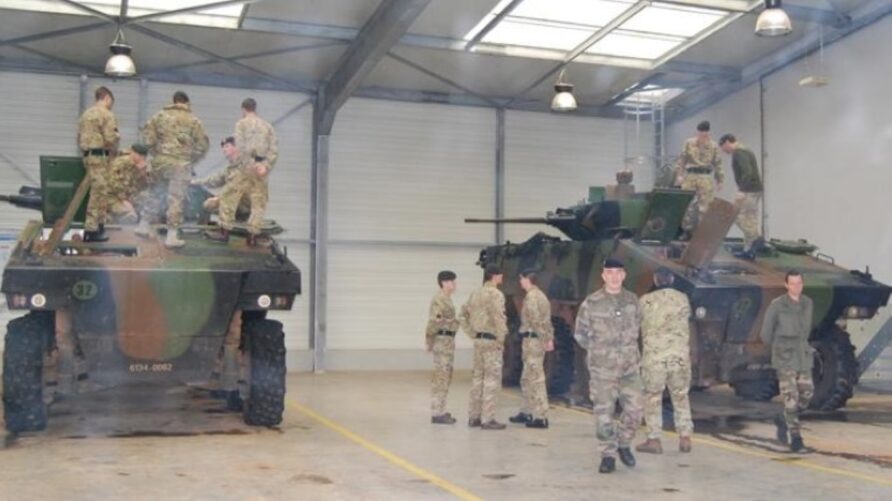
In November 2015, the National Security Strategy and Strategic Defence and Security Review was published and focussed on three key themes; Protect our People, Project our Global Influence and Promote our Prosperity.
The Future Force 2025, for the Army, built on the adaptable force/reactive force model and specifically of relevance to the medium-weight force, would comprise the following:
A war-fighting division optimised for high intensity combat operations.
The division will draw on two armoured infantry brigades and two new Strike Brigades to deliver a deployed division of three brigades.
We will establish these two Strike Brigades to be able to deploy rapidly over long distances using the new Ajax armoured vehicles and new mechanised infantry vehicles.
They will double the number of brigades ready for operations. With these, and 16 Air Assault Brigade’s very high readiness forces, we will improve our ability to respond to all likely threats
David Cameron also described the new structure:
We will create 2 new ‘strike brigades’ by 2025 to be rapidly deployable, able to self-deploy thousands of kilometres, and with a much lower logistic footprint. They will use the new Ajax family (previously known as Scout) range of vehicles, comprising 6 variants and almost 600 armoured vehicles.
The two STRIKE Brigades were to be created by re-rolling one Infantry Brigade and one Armoured Infantry Brigade.
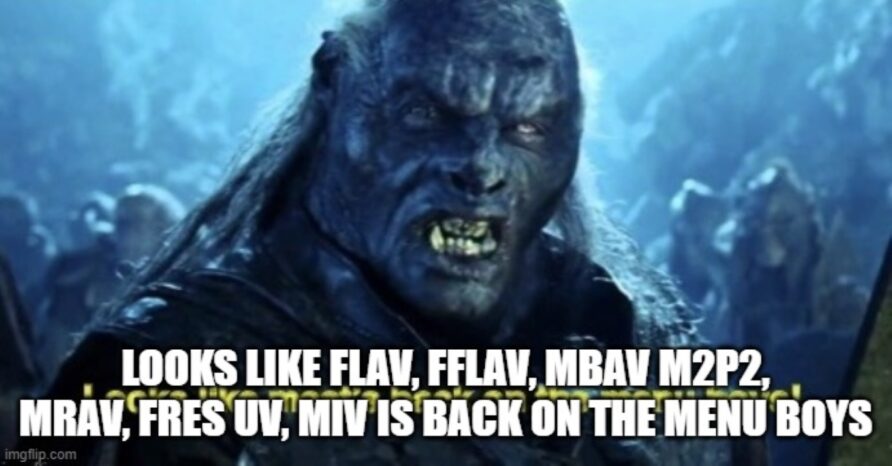
In 2016, the Bundeswehr announced all its Boxers would be upgraded to the A2 standard, a package of improvements in all areas of the vehicle’s design, from repositioning the towing cable to common displays.
In October 2016, several news outlets reported that The MoD intended to purchase the Rheinmetall Boxer to meet the Mechanised Infantry Vehicle (MIV) requirement without competition.
Quantities were reportedly up to 800 at a cost of £4 million each.
Lithuania joined the Boxer programme in August 2016.
In December, Janes reported that as part of Army 2020 Refine, main battle tank numbers would be reduced from three regiments to two.
One unit would re-role to Ajax as part of the Strike Experimentation Group.
An extract of the full statement is reproduced below:
The Army is refining its force structure to deliver the capabilities set out in the Strategic Defence and Security Review (SDSR) 2015 and modernise the Army’s ability to fight at the divisional level. The SDSR 2015 significantly increased the readiness levels required of the Army, underpinned by investment in new capability and a war-fighting division as part of Joint Force 2025. It introduced the innovative Strike brigades, based on the new AJAX vehicle family and the development of Specialised Infantry battalions, reconfigured to provide an increased contribution to countering terrorism and building stability overseas.
I am today setting out refinements to the Army which will take place during the life of this Parliament. These have been aligned with the “Better Defence Estate” strategy announced in early November. As we previously committed, we will continue to sustain a regular Army of 82,000, a whole force of 112,000 regular and reserve troops and the Army’s footprint in the devolved nations. All existing regimental cap badges will be retained. Large parts of the Army will be unaffected but it will involve some units changing their role, equipment or location.
A modernised division will be centred on the 3rd (UK) Division, organised with four brigades of two Armoured infantry and two Strike, rather than three Armoured infantry as now. A significant uplift in capability, it will hold one of each at high readiness, rather than the current single armoured infantry brigade. From this, in times of crisis, the Army will be able to deploy a credible division of three brigades. To develop and transition to this new posture, in 2017 the Army will launch a Strike Experimentation Group in Warminster. This will ensure that the first new Strike Brigade will be formed by the end of the decade.
Summary of changes proposed under Army 2020 Refine
Strike Brigade
The first Strike Brigade will operate from Catterick and Salisbury Plain and will be composed of the Household Cavalry Regiment, The King’s Royal Hussars, the 1st Battalion Scots Guards and The Highlanders, 4th Battalion The Royal Regiment of Scotland. A number of Royal Logistic Corps (RLC) and Royal Electrical and Mechanical Engineer (REME) units will be allocated to provide close support logistic support, beginning with 1 Regiment RLC and 1 Close Support Battalion REME.
Support
The changes announced will require adjustments in some supporting and enabling elements of the Army. HQ 102 Logistic Brigade, 32nd Regiment Royal Artillery, 35 Engineer Regiment, Headquarters 64 Works Group Royal Engineers, 2 Medical Regiment, Headquarters 4th Regiment Royal Military Police, 33 Field Hospital and 104,105 and 106 Battalions of the Royal Electrical and Mechanical Engineers reserve will be rationalised, with all manpower in those units being redeployed to other areas of the Army in its refined structure.
The basic organisation of a Strike Brigade would, therefore, consist of;
- 1 Regiment of Ajax in the reconnaissance role
- 1 Regiment of Ajax in the ‘medium armour’ role
- 2 Battalions of mechanised infantry in the yet to be purchased Mechanised Infantry Vehicle (MIV)
- Supporting CS/CSS
At the end of 2016, Patria showed an AMV fitted with a modified Lockheed Martin Warrior two-man turret.
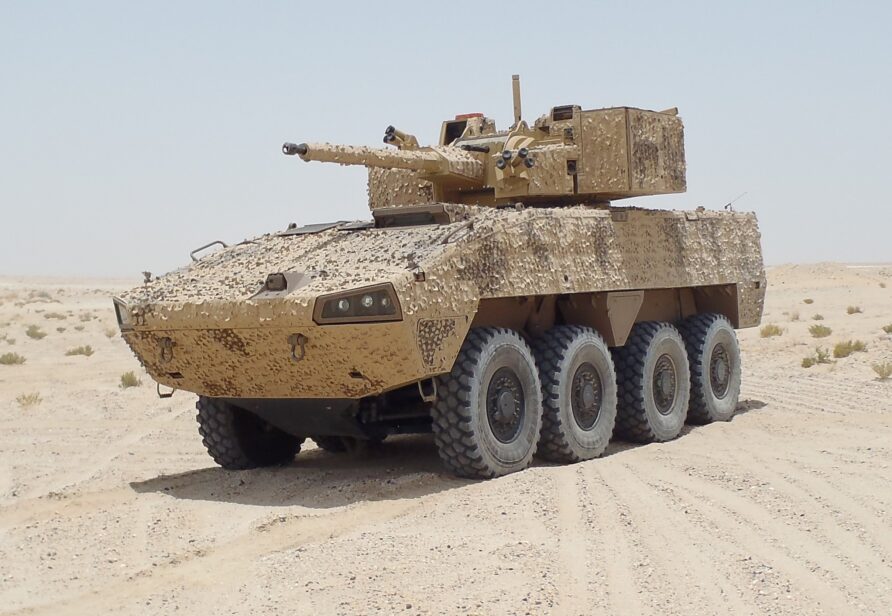
Experimentation with the Strike Brigade continued throughout the year and in 2017, despite earlier indications that Rheinmetall would not offer Boxer for the MIV requirement, Rheinmetall started to build a UK industrial team for the bid, the aim was to produce 60% of the vehicle by value in the UK.
The 400th Boxer was delivered in February 2017.
The total Boxer programme now stood at 696 with the vehicles in service or planned to be in service, with Germany, the Netherlands, and Lithuania.
Future Force Concept (JCN 1/17) was released with little fanfare but was a significant document in that it looked across the range of future challenges and described the means in which they might be met.
For the Land Domain, and of particular relevance to STRIKE, it described the need for dispersion and concentration. It also noted that dispersed forces are more difficult to sustain and that logistics reduction efforts must be sustained to enable this.
Although the General Dynamics Piranha V, Patria AMV and Nexter VBCI were on show, from the media output, one could be forgiven for thinking that only the Rheinmetall Boxer mattered.
General Dynamics emphasised the speed of delivery for Piranha V with a comment that initial vehicles could be delivered from existing productions before transferring manufacturing to their South Wales factory.
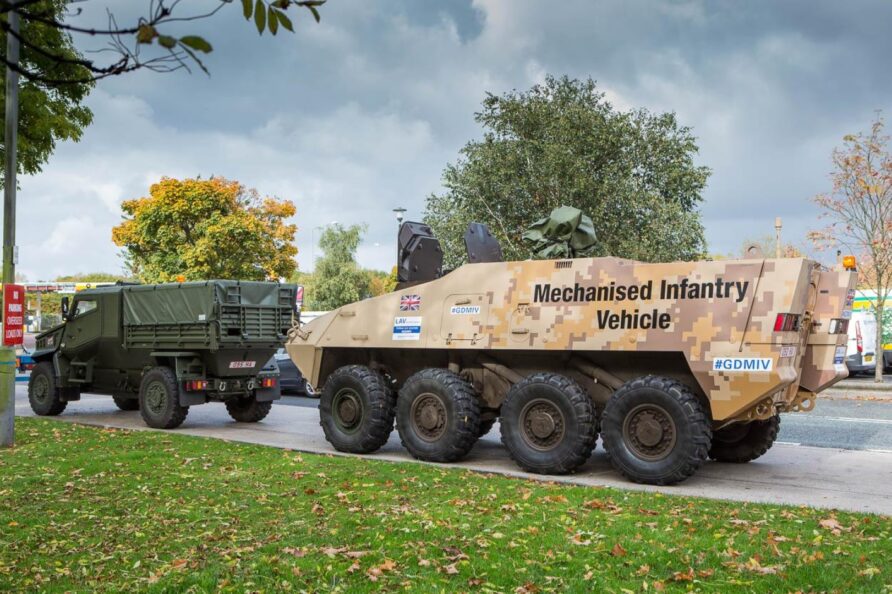
Many manufacturers returned information to the MoD in response to enquiries; ARTEC, BAES, FNSS, General Dynamics, Nexter, Patria, ST Engineering, and Thales.
Speculation continued throughout 2017 regarding the MoD’s desired acquisition strategy, whether an open competition or direct selection and purchase.
In January 2018, Harriet Baldwin (Parliamentary Under-Secretary of State and Minister for Defence Procurement responded to a letter from Julian Lewis MP (Chair of the Defence Select Committee) regarding the Mechanised Infantry vehicle.
In February 2018, a Rheinmetall press release described the industrial partnership arrangements, should they be selected.
Leading British companies in the defence sector BAE Systems, Pearson Engineering and Thales UK have signed agreements with the ARTEC consortium as partners for the production of BOXER. Should the armoured wheeled vehicle be selected as the British Army’s next generation Mechanised Infantry Vehicle (MIV), at least 60% of BOXER’s value creation and 100% of final assembly will take place in Britain. To ensure the best value to the British tax payer, ARTEC has defined a competitive process for the main partners and their supply chains to follow.
ARTEC’s investment in the UK value chain is estimated to secure or create at least 1,000 jobs all across the country. The UK partnership approach will ensure that British companies are fully embedded in the MIV supply chain. Rolls Royce, Parker-Hannifin, WFEL and British subsidiaries of the ARTEC parent companies will also supply British content.
Further, Rheinmetall intends to establish a modern production and integration centre for armoured vehicles in the UK as part of the programme. This represents a significant commitment from Rheinmetall which will lead to long-lasting armoured vehicle capability in the UK.Further, Rheinmetall intends to establish a modern production and integration centre for armoured vehicles in the UK as part of the programme. This represents a significant commitment from Rheinmetall which will lead to long-lasting armoured vehicle capability in the UK
Also in February 2018, Slovenia selected Boxer and plans to purchase 48 of them.
After a competitive evaluation, Australia Rheinmetall Defence Australia (RDA) was selected as the preferred tenderer for Land 400 Phase 2 with Boxer.
The Phase 2 programme was defined as; Mounted Combat Reconnaissance Capability, primarily enabled by the Combat Reconnaissance Vehicle (CRV) mission system (the ASLAV replacement).
The $5 billion projects was to provide the Australian Army with 211 new vehicles, plus 12 additional modules.
A video from 2018 that has some useful information.
A March 27th 2018 article in the Telegraph claimed the MoD was getting closer to ordering Boxer.
Britain’s military is closing in on a multi-billion pound deal to equip the army with eight-wheeled armoured vehicles that will form a key part of the country’s future combat strategy. Defence sources say the Ministry of Defence is requesting information about pricing ahead of a potential purchase of hundreds of Mechanised Infantry Vehicles (MIV). Although not an order, the request for information — due to be made any day — will help military planners cost up the deal ahead of a so-called “main gate” decision on whether to go ahead. It is thought the MoD could ultimately order as many as 500 MIVs at a cost of up to £2bn.
This was another media article that contributed to speculation regarding MIV and its acquisition strategy, especially in balancing speed into service and the degree by which the UK supply chain can be established.
The Government announced its decision on March 31, 2018.
The British Army has taken a step towards exploring a deal for a fleet of new armoured vehicles, potentially supporting at least 1,000 British jobs, by announcing it is re-joining the Boxer programme today. The UK will re-join the Boxer programme and explore options to equip the Army with the 8×8 troop carriers to modernise its vehicle fleet and meet the Army’s Mechanised Infantry Vehicle requirement.
The UK played a major role in the original design, development and testing of the Boxer, and would reassume the rights it had as a project partner if a deal was to go through — allowing the option for the vehicle to be built and exported from the UK. The deal could see the Boxer fully assembled in the UK with at least 60% of the manufacturing with British industry, sustaining and developing UK industrial capabilities, facilities and skills.
Artec, the consortium who manufacture the Boxer vehicle, have already made commitments to British industry by signing partnership agreements with BAE Systems, Pearson Engineering and Thales UK, in anticipation of a deal being struck. It is expected that British companies would compete for the manufacture and supply of many of the vehicle sub-systems, as well as for a full production and assembly line in the UK. Estimates suggest Artec’s planned investment in the UK could secure or create at least 1,000 jobs, based across the country including locations such as Glasgow, Newcastle, Sheffield, Stockport, Telford and Wales.
With the likes of Rolls Royce already powering Boxers with engines and Parker-Hannifin, William Cook Engineering and other British companies also supplying sub-systems for the vehicle, this deal could secure a broader industrial UK partnership. The MOD is now taking forward negotiations with the Organisation for Joint Armament Cooperation (OCCAR) and Artec. Looking forward to the Assessment Phase, concluding in 2019, this will consider the comparable benefits of manufacturing locations and different supply chains for Boxer, as well as value-for-money. Any deal will be subject to commercial negotiation and assessment in 2019 and the aim is to have the first vehicles in service with the Army in 2023.
OCCAR is a European intergovernmental organisation which facilitates and manages collaborative armament programmes through their lifecycle between the UK and European allies. The organisation manages the Boxer programme and, as an OCCAR member state, the UK has the necessary Intellectual Property Rights to the Boxer and greater control over ensuring Britain benefits from supply chain work.
The MOD conducted a comprehensive market analysis of Mechanised Infantry Vehicles in-service, entering service and in development. The analysis was guided by the British Army’s requirements and how best to deliver them. The Boxer delivered on protected mobility, capacity, flexibility, utility, and agility. As part of the proposed deal, the UK is also expected to see substantial inward investment from Rheinmetall, one of Artec’s parent companies, who signalled their intention to launch a production and integration centre for armoured vehicles in the UK as part of the programme. This would represent a significant commitment which would lead to long-lasting armoured vehicle capability in the UK.
The other of Artec’s parent companies, Krauss-Maffei Wegmann (KMW), already has a substantial UK manufacturing facility in Stockport, from where it designs, manufactures and supports complex military equipment as far afield as the US and Australia, as well as parts of Europe.
Further details emerged on the 18th July 2018 with a Transparency Notice
The UK MOD intends to purchase, via the Organisation for Joint Armament Cooperation (OCCAR), an initial procurement of batched quantity 400-600 protected 8×8 BOXER vehicles in 4 variants plus driver training vehicles, reference vehicles and support. The batched quantity may be revised if the demands of any UK strategic direction impacts on MIV. Support covers spares, consumables, technical publications, tools, test equipment, training systems and support; project, safety, quality, security, configuration, obsolescence management services (throughout design, development, manufacture and in-service); repair and maintenance activity; and Post Design Services (e.g. future development of different vehicle variants), upgrades and new capabilities or requirements determined by any new defence priorities (e.g. security threat based); requirement based (e.g. medium calibre cannon); changes to legislation; introduction of new systems; emergent safety / environmental issues; and standardisation.
Value excluding VAT: 11 500 000 000.00 GBP
In February 2019, the 500th production Boxer was delivered.
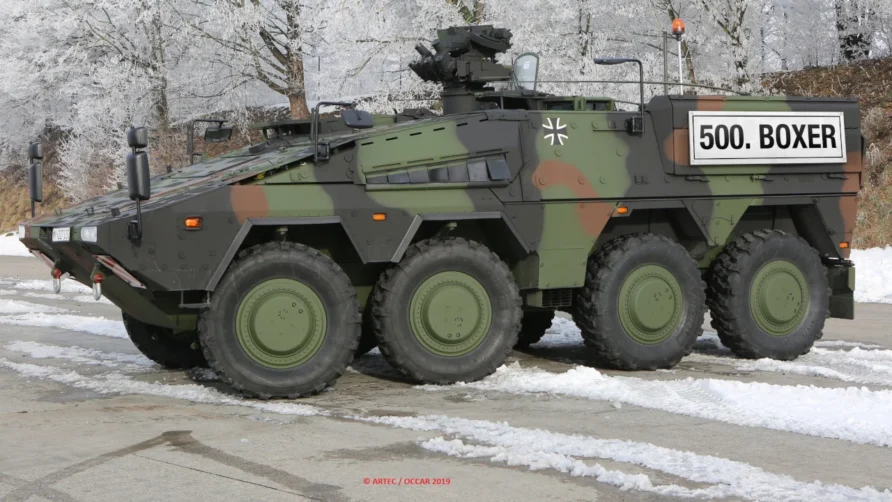
Later in the year.
On the 4th of November 2019, the OCCAR-EA Director and the ARTEC Chief Executive Officers signed a contract for the procurement of more than 500 Boxer vehicles on behalf of the United Kingdom of Great Britain and Northern Ireland (UK).
The contract includes the delivery of 5 prototypes in four specific Build Configurations (Infantry Carrier, Specialist Carrier, Command Post and Ambulance) and 523 series vehicles, initial In-Service Support Packages and Special to Role Kits. The vehicles will be equipped with a remote controlled weapon system with a 12.7mm L1A2 Heavy Machine Gun or a 7.62mm L7A2 General Purpose Machine Gun, depending on the mission. They will also have missile, blast as well as Rocket Propelled Grenades (RPG) protection.
The UK vehicles have the ability to change within the variants (Build Configurations) by changing the interior, introducing different kits and assemblies depending on the mission.
The production of the UK fleet will be shared between Germany and the UK. As a first step, the prototypes will be manufactured in Germany by the main-subcontractors of ARTEC, the companies Krauss-Maffei Wegmann and Rheinmetall. The first phase of series production will be conducted on the German production lines of both companies. Workers from the UK will be trained on how to assemble the vehicles and after the necessary knowledge transfer, the production will be transferred to new facilities in the UK. The plan says to have the first trials in June 2022 and the delivery of the first series vehicle to the British customer by November 2022.
The order value was reported to be €2.6 billion (£2.3 billion).
The short timescales for the UK assessment were greatly enabled by Australia kindly sharing their test data.
As can be seen from the above press release, each of the Artec consortium members would receive 50% of the order, and each of these conducting the majority of their share in the UK through two subsidiaries; Rheinmetall BAE Systems Land (RBSL) and KMW’s subsidiary WFEL.
RBSL is a joint venture between BAE Systems (45%) and Rheinmetall (65%).
Defence Equipment and Support released the following video in November 2019
Both RBSL and WFEL continued to develop their respective supply chains throughout 2019 and 2020, with additional development and trials, work being conducted in conjunction with the Armoured Trials and Development Unit (ATDU).
The first subcontract was awarded to WFEL in July 2020. Pearson Engineering, Rolls Royce, Thales, William Cook and Parker have also joined the supply chain.
Supply chain contracts continued to be reported as the supply chain was established
and
On June 1st, 2021, the British Army announced the first UK Boxer pre-production vehicle had entered construction.
Rheinmetall will develop and fabricate first prototypes at its plant in Kassel, Germany, where the first series vehicles will also be produced. Workers at the German plant will share technical knowledge, particularly their specialist welding expertise, with British colleagues at RBSL.
A few days later, WFEL followed this with an announcement echoing the UK production start.
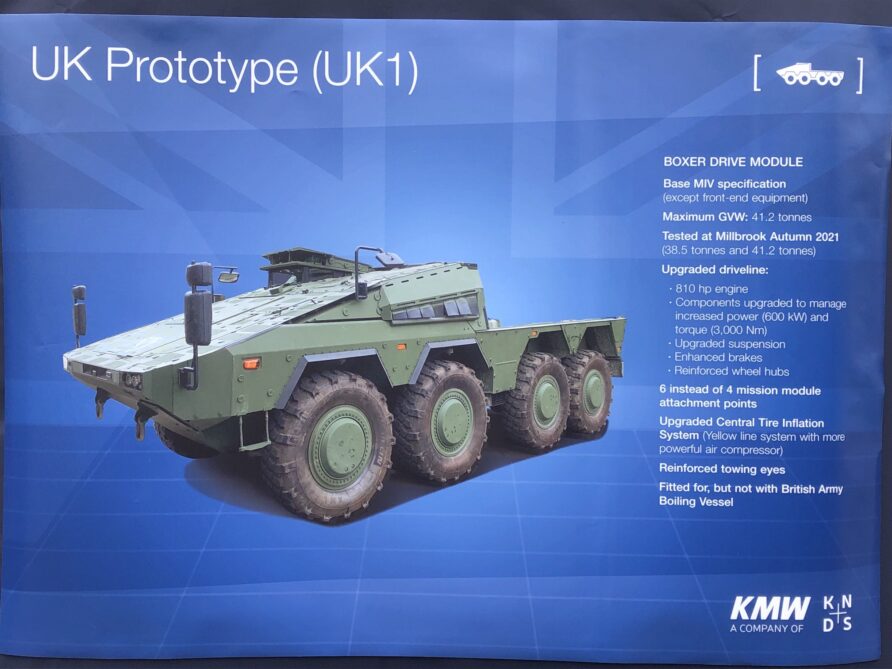
June 24th, 2021, saw ARTEC officially hand over the last of 131 BOXER APCs of the 2nd batch in the version GTFz A2 to representatives of the German MoD, Bundeswehr and the Federal procurement agency.
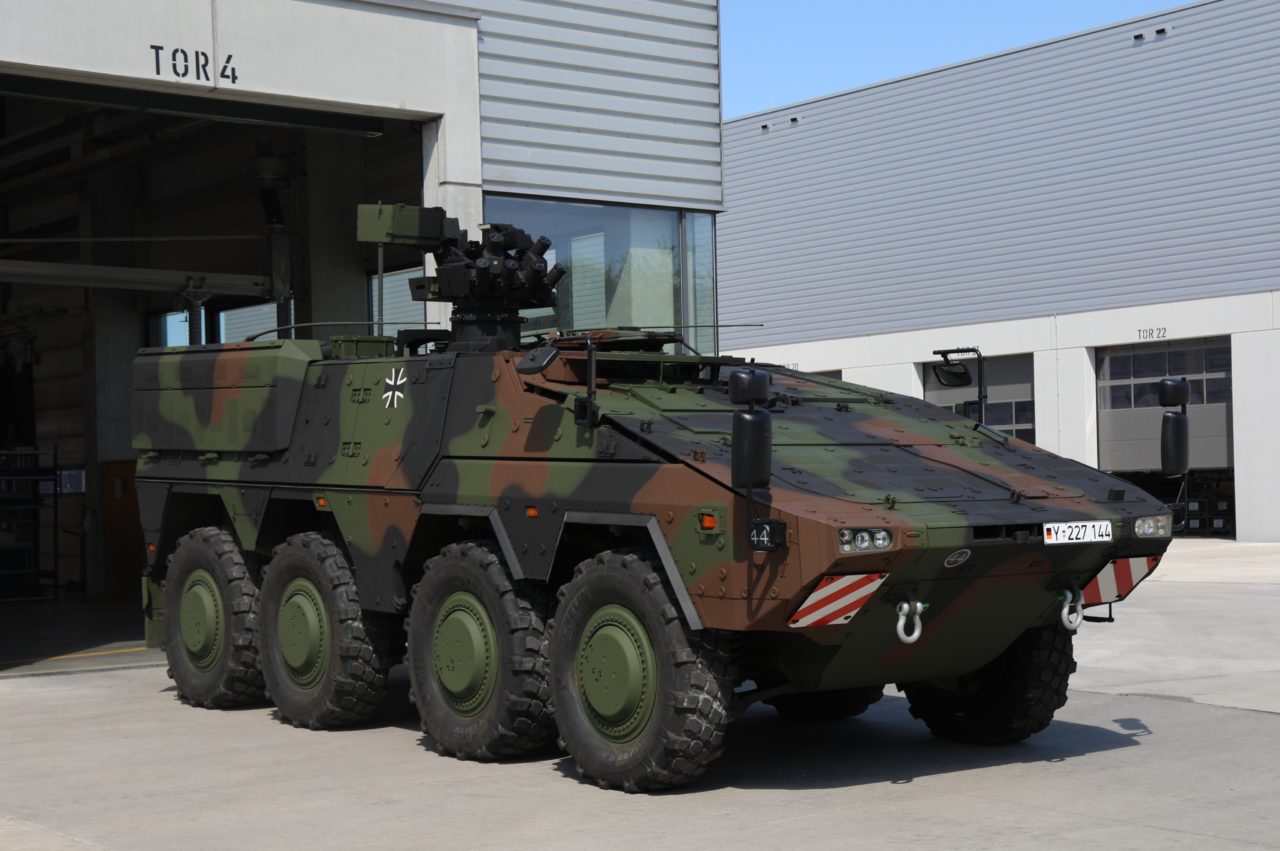
In April 2022, the British Army announced it would receive an addition 100 vehicles.
Boxer armoured vehicle programme boosted to 623 vehicles as joint UK-Germany production begins in Telford, Stockport and Munich.
The British Army will receive 100 extra armoured Boxer vehicles, ensuring more vehicles reach the frontline faster and bolstering the programme to a total of 623, as the UK maintains defence ties with Germany, the Prime Minister has announced today.
The modern digitalised armoured vehicles can be used to transport troops to the frontline and can be rapidly reconfigured to fulfil different roles on the battlefield.
The UK and Germany have worked closely together on the Boxer programme for the British Army, with the Boxer build in the UK benefitting from German expertise, data and collaboration
Later in the year, a delay was announced, with Janes reporting.
Production is successfully under way for Boxer and 623 of the new armoured vehicles will be delivered to the British Army. Global supply chain pressures are not unique to defence, and no delays are expected for the first deliveries in 2023 or Boxer’s initial operational capability (IOC) in 2025
The British A3 variant was tested at Millbrook with additional weight.
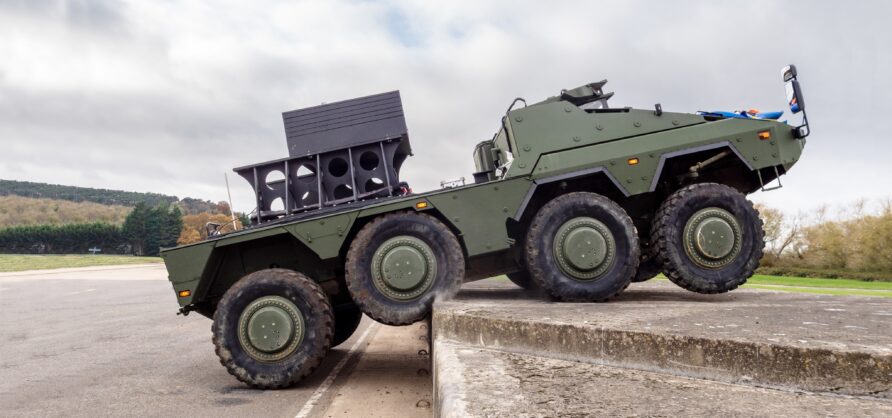
In April 2024, the British Army announced it will purchase the RCH155 system as part of the Mobile Fires Platform (MFP) requirement.
A significant milestone in the modernisation of our artillery was reached today, following a landmark defence agreement with Germany.
Prime Minister Rishi Sunak and Chancellor Scholz announced our collaboration with Germany on the Remote-Controlled Howitzer 155 mm (RCH 155) 52 calibre Wheeled Artillery Systems.
We aim to deliver RCH 155 into service this decade. It will equip Royal Artillery soldiers with a world-class close support artillery system to deliver lethal and decisive effect for ground warfare across the span of operations.
In response to a written question, James Cartlidge MP, Minister of State, replied
RCH155 will be developed through a jointly led collaborative procurement between the UK and Germany. Working collaboratively on a joint assessment and qualification plan will exploit the combined capabilities of each nation’s test and trials centres enabling faster delivery at less cost. The certainty of platform choice also enables us to advance early acquisition of ammunition and other critical enablers in the assessment phase. Concurrently, we will continue to explore opportunities to accelerate delivery of RCH155 to the Army, where possible and in line with the new Integrated Procurement Model.
The assessment phase of the programme will determine the most appropriate manufacturing approach and confirm the number of platforms required by the British Army. The Army aims to achieve a Mobile Fires Platform Minimum Deployable Capability within this decade.
The joint programme is potentially worth upwards of £3 billion and marks a step change towards a deeper industrial and wider defence relationship between the UK and Germany.
Many noted that this was decision was made without any formal competition, again.
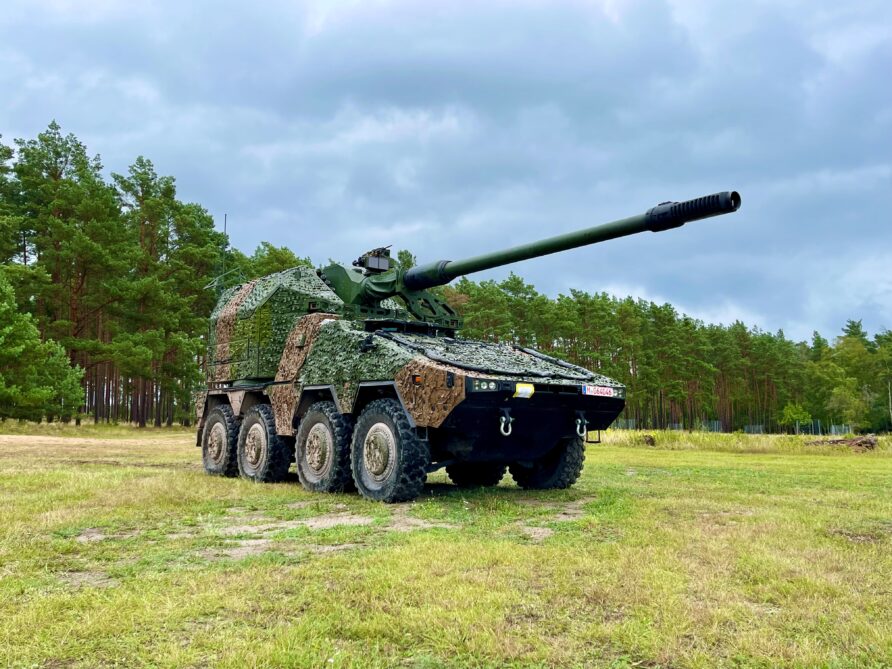
The image below shows Boxer at the Alvis Vickers, BAE Systems and RBSL plant in Telford, over the course of two decades.
Same vehicle (more or less), different owners.

Final thoughts.
Without any formal competition, the British Army selected Boxer to meet its MIV requirement and, together with the MoD and Industry, has built (or rebuilt) a resilient industrial capability to deliver it (they don’t get enough credit for this last part)
CVR(T) has recently left service, FV432 remains
Forty long years after FLAV, the UK will replace much of the legacy fleet with a vehicle it helped fund and develop, then rejected, twice.
It will have one of the largest fleet of Boxers.
They will be manufactured by UK subsidiaries of German owned companies.
Change Status
The second part of this article covers Boxer characteristics and variants, click HERE to open.
| Date | Change |
| 29/03/2017 | First Issue |
| 25/09/202 | Update on progress |
| 23/07/2021 | Update on progress |
| 16/05/2024 | Update on progress |
You can obtain this article as a downloadable PDF, each time I update, the update will be free to download
read more (Affiliate link)
Discover more from Think Defence
Subscribe to get the latest posts sent to your email.



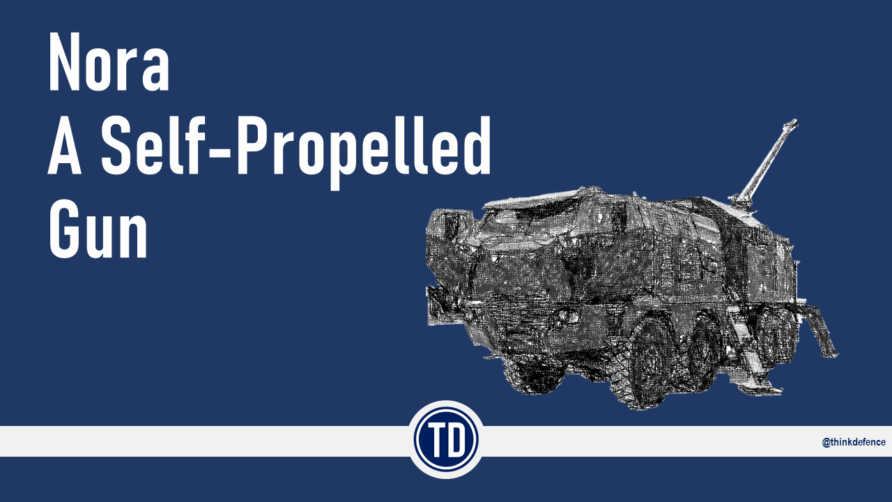
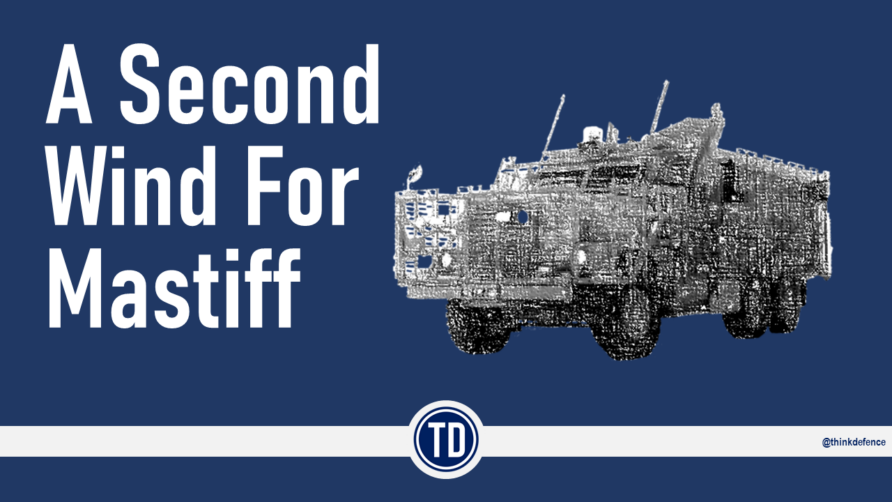
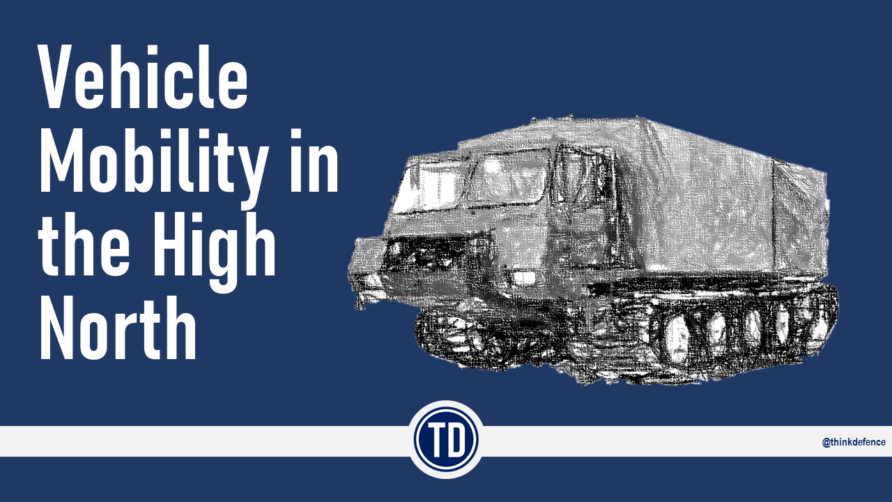
Boxer is an excellent vehicle but the MOD couldn’t go far wrong in purchasing Patria either and which is already deployed in versions fitted with both the Amos mortar system and a 105mm gun. To me the missing vehicle in the MIV proposals is a dedicated ATGW carrier as used to be provided by Striker/Swingfire. An elevating box launcher for Brimstone plus an automated loader would seem to be ideal solution.
Ivan – I don’t think we need Brimstone on a vehicle like Boxer due to it’s size and weight. With it’s range it can be fired in in-direct fire mode from a the US Army Multi-Mission Launcher, MML has been tested with Hellfire and carries 15 missiles. For a Striker replacement on both Ajax and MIV I agree on an under armour pop up launcher, but with MMP.
Why introduce a third ATGW system into the UK inventory, especially when it has only 40% of the range of the, er, British made alternative…and a less effective war head?!
Ivan
It would not be 3rd type because I would replace Javelin with MMP. However, Javelin, MMP or Spike are the “right size” for RWS, turret or other Armoured vehicle launchers. They are essentially infantry ATGW and so their use provides commonality with dismount ATGW teams,
The Brimstone is too big and heavy, and it’s range is for to great and cannot be any where near utilized in a “direct fire” mode. Use it’s range, MMW active seeker and others features in an appropriate long range engagement methodology.
I think you’re just playing fantasy armies, Jed. There is no more prospect of the skint MOD replacing Javelin with another system just as there is no prospect of them adopting MML either. You’re objections don’t hold much water as swingfire was never an infantry weapon and was never considered “too heavy” by anybody, being only ever vehicle mounted. Troops used Milan, as they now use javelin. Brimstone can be used in a direct fire mode. And only weighs 50
Kg, a weight any fit bloke should be able to handle, but the weight is only relevant when it is being loaded onto the vehicle. There is an obvious paucity of anti tank weapons in the UK armoury, if MIV is going to have any battlefield overwatch then use an existing system, and if the bumpf is to be believed, Brimstone is as good as it gets.
This is good news although a loooong time coming.
I think the money being spent on Ajax is going to hobble the programme in terms of numbers we can afford over numbers we need. The decision to change priorities to the scout programme over the utility version is going to prove a pain for years. It was obvious that the UV and MRVP programmes were and are needed more.
This is by far the best article I’ve read on the history/development of he Boxer and the progression from MRAV to MIV. A solid choice for the UK Army, though one has to wonder what would have happened if they had not dropped out of MRAV in the first place. I understand the reason for dropping out, just doing a “what if”. Now that “standard” 8×8 protection levels have grown beyond what a C-130 can carry I would love to see the IBCTs transition from the Stryker to the Boxer (wishful thinking I know) as in my opinion it’s a much better vehicle for that role that the current Stryker and we get the added bonus of commonality with our allies in both Europe and Australia.
I know, as evidence by the pictures in the article, that the 155mm AGM had been mounted on the Boxer but does anyone know if a 105mm direct fire module, akin to Centauro or Stryker MGS, been thought/tossed about? I very much like the drive-by-wire capability shown in the JODAA video and can see several use cases for it.
Anyways, again well done on the article and I look forward to seeing the updates as more info is made available.
Jed, I agreed totally with your article on Strike Brigades of three years ago. Mixing Ajax and Boxer makes no operational sense at all! Let Ajax loose among the Armoured Brigades, stop putting CTA turrets on Warrior. Put them instead on scout/fire support versions of Boxer. Also buy a small number of Boxers with 155mm guns and GMLRS. If we’re going to exchange smaller Heavy and Light forces for creating wheeled Middleweight forces that exchange protection for greater in-theatre strategic mobility, let’s do it in a way that is operationally workable. At the moment we’re spending a lot of money buying two top drawer vehicles and will end up with neither fish nor fowl.
If you stop putting CT 40 turrets on the Warriors, what do you do with the armoured infantry?
Mr.fred, I believe what SR meant was to replace Warrior with the IFV version of Ajax rather than just upgun the Warrior to 40CTA and so the armored infantry would benefit from a newer more well protected ride. The turrets that were destined to upgun the Warriors could instead be used to arm the Boxers giving it a bit more punch than the normal .50cal RWS.
Where’s the money coming from for Ajax IFV versions, how are we going to afford to buy enough MIV for the 2 strike brigades and extra Ajax (which cost a lot more than Boxer)?
Are people forgetting that there are a lot of 432 variants that still need replacing in the armd brigades plus Challenger upgrades let alone MRVP 4×4 and 6×6 to procure before we start dreaming of an Ajax IFV.
The Army can create 4 coherent brigades (2 armd and 2 strike) with what we have now and what is getting ordered without cancelling Warrior and adding more costs just for the sake of it.
What Ajax IFV?
Also, there’s more to Warrior CSP than the turret.
Mr.fred, my apologies I should have used “an” instead of “the” when referring to an IFV version of Ajax as there is no defined IVF variant. In my mind the it was a “simple” solution of putting an unmanned version of the Ajax 40CTA turret on the Ares APC turning it into the Ares/Ajax analog of the Warrior.
As far as money goes, we have the similar funding problems here in the US, too many things the “must” be done an not enough money to do them all. Personally I prefer moderate near term pain to avoid excessive long term pain or put another way, take one step back to take two steps forward but I’m no acquisition expert no politician so I realize my simplistic view may be just that, simplistic and unfeasible given realities I may not be aware of.
I’m glad you put “simple” in quotation marks, but I still think that you overestimate how easy it is to just slap a turret on something, especially if the base platform isn’t designed to take it in the first place and more so if you are converting manned to unamanned.
I don’t know what savings, if any, you’d get in the long term by developing and building Ajax IFVs, but you’ve got the up front costs that are likely to be such that Ajax IFVs are twice or three times a Warrior upgrade, plus the time value of money.
Well, at least it’s manned to unmanned. Can you imagine the trouble trying to find space for a turret basket inside the vehicle if it was unmanned to manned? One benefit I found to the unmanned turret fad is that the removal of the turret basket from inside the vehicle now lets an ‘IFV’ potentially carry the same amount of dismounts an ‘APC’ used to carry without downgrading the weapon system, or at least if you were not using a huge top of the line gun, you can actually use a ‘small’ medium calibre weapon like the 25-35mm Bushmaster RWS and still keep 11 dismounts.
Unfortunately, the reducing number of dismounts in current vehicles is more due to increasing armour thickness cutting into internal volume than weapons. At least with RWS, there is some take back of internal space, I shudder to think of a modern ‘squeezed’ IFV with heavy armour AND a turret basket….
well been announced..over a holiday period? UK will rejoin Boxer program.
https://www.defensenews.com/land/2018/04/02/uk-to-re-join-boxer-program-17-years-after-opting-out/
I’m not entirely sure who the paint job and slogan are aimed at. Is it just another example of those wacky continentals having a laugh?
On the one hand, it is very good news that the British Army is finally getting a credible 8×8, with a reasonable British built content. (Roll on a Challenger 3 with 130mm RH gun!).
On the other hand, are we buying heavy kit, that will be hard to deploy?
Peter, fighting beside the Americans, it’s obvious they had to take some steps to prevent friendly fire.
If people still shoot at it even with that colour scheme, they definitely need new glasses. lol.
Dear all. I’m no expert. I’m not aware of the exact financials or procurement problems here. I have worked over thirty years in delivering complex programmes to military customers so I am painfully aware of development, integration and testing issues, not to mention OT&E and acceptance and qualification trials. All I am saying is that if you deploy a SB consisting mainly of AJAX and BOXER, your strategic mobility will be dictated by AJAX. You might as well have deployed Challengers and Warriors, except without the firepower. If strategic mobility is not an issue, then why not buy more APC variants of AJAX instead of BOXER and have vehicle commonality? Presumably if we are buying BOXER (which is an excellent choice by the way) it’s because we want to benefit from the advantages of a top drawer 8X8. So then don’t tie it’s hands and feet together by deploying it with a tracked vehicle in something called a SB. Makes no sense to me, unless I’m missing something here…. Like Jed said in 2015, it smells of a political fudge to justify cutting back on the numbers of Challengers and Warriors (not that I am a particular fan of either, but that’s not the point).
Richard, that contradiction has been noted before. My only optimistic viewpoint on it is that they have not really tied down how to use the vehicles yet so usage is still open for consideration. They just only formed a study group on the issue this year in January if my memory, which is admittedly questionable these days, serves me.
On Ivan’s point: an interesting one. No question that it would make a lot of sense to standardise on a single missile if possible and DM Brimstone is the obvious candidate. Brilliant piece of kit. The first move has to be Apache and Predators. Problem is when you start firing it from the ground. For a LOS engagement, laser designation, no problem (other than you expose your designator’s position, but let’s not go there). Bit of an overkill weapon for a LOS engagement, though… It’s real advantage would be for NLOS engagements, where it would be more than a Swingfire replacement! Here you would need a forward designator or tactical drone designating. Again, no problem. But if you wanted to take advantage of the MMW seeker (the whole point of Brimstone) you’d have some difficulties. You’d be limited to having to designate first and then scarping, allowing the active radar to take over (unless you were firing against formations of tanks in a many-on-many engagement like the good old days of the Fulda Pass – less likely these days). Remember, when you’re on the ground NLOS is a lot closer than you think. For a missile the size and power of Brimstone, an IIR seeker is a lot more suitable for a NLOS ground to ground engagement and for that you need a secure, NLOS data link for man-in-the-loop, ideally a fibre optic thread. So here is where Brimstone becomes less attractive and Spike or MMP more so.
Re my latest on Brimstone, sorry, got to call them Protectors these days, not Predators (stupid name…)
Observer, fair point. But this is not rocket science. It doesn’t need a working group. If you deploy BOXER on its own, as currently envisaged your most powerful weapon will be a 50 cal MG on a RWS? Aside from the dismounted teams, that is… If you deploy them with anything else, they can only move at the pace and range of the slowest. I’ll say no more because I’m repeating myself.
Don’t look at me Richard, I know that, you know that, but their higher ups obviously need a report in triplicate. lol.
One ‘problem’ with the Brimstone/Hellfire as a NLOS weapon is that it is a ‘boost/glide’ weapon, it boosts to altitude, then glides down to hit the target so it can’t really maneuver that drastically since it’s basically just using windflow to steer, not to mention once the booster cuts off, the glide slope is pretty much set. If you want a NLOS weapon, I’d recommend using a ‘constant boost’ missile instead, you can fly it above the target and just drop it straight down since it is still under power.
Not sure why using Boxer and Ajax together is a problem.
1. If you want rapid deployment you send Boxer.
2. If you need tracks and a 40mm (assuming we don’t fit one to Boxer) you send Ajax and use Boxer as the APC. The fact that Boxer /could/ deploy quicker doesn’t matter.
Boxer might not be able to go where Ajax can go but as an APC it doesn’t necessarily need to. For the times that the going is poor we simply use the tiny Ajax APC variant.
Simon, the problem comes in the proposed strategic ranges the Boxer is advertised to operate in. The ranges seem to be international in scope, for example, sending the Boxer to Poland over land. The problem comes in terms of ‘control range’, it’s near impossible for a brigade commander to control his force when 2/3 of it is somewhere in Poland or Ukraine while the other 1/3 is somewhere in Germany or France trying to catch up.
The problem is not on the tactical level but on the strategic one.
All,
Here is how I see things things playing with regards to the British Army’s Armor situation. My apologies in advance if I mix up terms/program names, I’ve done my best best to keep up with all the name changes, but I wouldn’t be surprised if I missed a few. I will also refrain from using specific unit sizes (Brigade, Company, etc) and use the general term of Unit as I’m not well versed on UK Order of Battle/Unit structure other than the well publish Brigade variants (Heavy, Strike, Medium, Light, etc).
From where I’m sitting I believe the UK, like the US, wants to retain the basic types of armored units, Light, Medium, and Heavy. As Light, Medium, and Heavy are subjective terms I shall define them as follows: Light – up to 20 tonnes/all around protection up to 14.5mm (LAV-25A2), Medium – 20 to 40 tonnes/all around protection up to 30mm (Boxer), Heavy – 40 tonnes and greater/all around protection greater than 30mm (Ajax). Granted the Ajax published weight range of 38 – 42 tonnes spans 2 categories I place it in the Heavy as it seems more heavy than medium to me and my assumption, based on published photos, it add on armor modules will give it all around protection greater than 30mm, again that is my assumption and I realize I could be wrong. Give the above constraints/definitions I would do as follows:
1) Move the Ajax from the Medium units and put them in the Heavy Units to operate along side the Challenger in the classic Heavy Armor formation. Warrior is long past due for replacement and the turret upgrade, while a nice step in the right direction, is a like using a Band-aid for something that requires stitches, in my opinion. Better to just replace the whole lot of them and redirect the money for the the ongoing upkeep and requisite upgrades to a system that will be more cost effective in the long run and provide better protection for its crew and dismounts. Being classified as a “heavy” unit will not prevent it from being used in a Strike Unit role and deploying on its own if the use of Challengers are not warranted. Strategically it make sense to me to keep the tracks together as they have similar deployment/logistical constraints.
2) Put the Boxer in the Medium Unit role and rather than procure just the base “APC” variant, procure the full range of module options leveraging off of what the other Boxer users have already, or are planning to do. Additionally, procure a mission module to drive module ratio of 3:2 as not all mission modules need to be deployed on drive modules all the time, especially in garrison. The “surplus” mission modules can be either used statically or mounted on a rack and carted about on the back of a MAN, Oshkosh, or similar logistics vehicle. Why wear out an expensive drive module on exercise when the exercise environment may not warrant it? Does a Command module really need to be on a drive module if, for the exercise all it’s going to do is travel by road and then sit at camp? The Boxer Unit, with all its mission variants, can be the “go-to” deployment units for all but the most intense conflict scenarios, especially if a 105mm direct fire capability similar to Centauro or the Type 16 MCV is developed for the Boxer.
Fiscal constraints aside, I like the overall direction the UK is heading with its armored vehicle programs. As an outsider looking in it seems as if the MoD is really trying to get its house in order. Hopefully, here in the US, our AMPV will end up being the US analog of the Ajax program and that the powers that be will remove their collective heads from various locations and realize how much could be gained by transitioning our Stryker based IBCTs to Boxers.
Please poke holes and tell me what I’ve missed.
—————————————–
Mr.fred,
In response to your earlier comment…. I believe that the Ajax turret is based on the Lance turret of which there are both manned and unmanned versions which should help with the manned to unmanned conversion. If as Observer stated, 40CTA is not needed, one could, theoretically, just use the unmanned Lance turret in either 30 or 35mm.
No argument that the turret upgrade might one half to one third the cost of an Ajax IFV but I would argue that the Ajax IFV is a better investment in the long run than the turret upgrade. The saving I see are from a maintenance/operational perspective and a survivability perspective. The amount of money to keep the Warriors operational, relevant, and survivable is only going to increase as time goes on. Why not take that money that was going to be used for Warrior upkeep and instead use it on an Ajax based Warrior replacement that should have fairly level maintenance costs for the foreseeable future rather than increasing ones year after year?
————————————–
With regards to the ATGW discussion, I don’re believe a single missile solution possible for LOS, but do believe a two missile solution is, one primarily for ground launch (short to long range LOS) and one primarily for air launch (long to extreme range LOS). I agree that Brimstone should be used as the primary air launched weapon. For the primary ground launched weapon I would pick either the Spike family or MMP (if it is developed in to a family like Spike was). For NLOS engagements I would pick the Spike NLOS or develop an MMP NLOS. The Javelin was a good weapon when initially deployed but now I believe it’s outclassed by the Spike and MMP, and TOW just needs to die.
Observer, I wasn’t criticising you in any way, not at all. By the way, I wasn’t advocating Brimstone as a NLOS solution, on the contrary. Merely trying to answer Ivan’s suggestion to adopt it as a Swingfire replacement and why, although the perfect fit for Apache and Protector, I would prefer MMP or Spike as a ground launched ATGW.
Ogden, you’re on the money my friend. Absolutely! Ajax belongs with the heavies. That doesn’t preclude its deployment elsewhere if appropriate. Time for Warrior to go OR be upgraded just as an APC. Base your medium units on Boxer but buy some modules other than just APC – they don’t need development, they’re all there already. The French are the masters of this (although not on Boxer, of course). And you’re right, despite all the above, U.K. is indeed buying some very good kit for its army. But this is after years of time wasting, heads up orifices and lots of money down the toilet. And it is this sorry and unfortunate history, I am afraid, that is delivering this confused force structure and concepts of use, despite the kit being excellent. The hope has to be that despite the political bull***t, come the day the ‘stars’ will use the kit sensibly… although we are spending money on Warrior that we shouldn’t, about the right amount on AJAX and not enough on Boxer…
Ogden,
The Ajax turret may be based on the Lance turret, but in the sense that the Ajax itself is based on the ASCOD. The guns are different, the ammunition feeds are different, the sights are different, the electronics are different, the armour is different… It’s pretty different.
Then Ares will have an APC roof rather than one intended to support a turret.
Warrior may be getting older, but using that as your IFV saves you half your acquisition cost, so that’s quite a hurdle to clear for your operational savings to start with, never mind that your 100% extra debt will be incurring interest, opportunity forgone or however else you like to account for spending money now as opposed to later. Personally I see Warrior CSP as a stopgap to go alongside Challenger 2 CSP, to carry the Armoured battlegroup out for long enough to get a good idea of the replacement strategy. Switching to a new IFV would only delay a needed upgrade for vague and nebulous promises of jam tomorrow.
Interesting to read so many opinions! Has anybody a view on whether Boxer is the “right” 8×8 to go for? There are a number of alternatives available, Are they all of a muchess, or are there genuine advantages/disadvantages. Germany does seem to produce outstanding military vehicles, just as they do commercial cars.
Does anybody have first hand or operational experience of Boxer or something similar
Mr.Fred,
Obviously there are difference between the Ajax and Lance turret which once can easily tell by comparing pictures of the two. I was under the impression that the underlying “bones/structure” of the two turrets was the same and the the differences were based on what modular components were mounted to the “bones” and where they were mounted. As far as the Ares APC roof goes, if it truely can not handle the weight of an unmanned turret then I see 3 solutions, reinforce the current Ares roof similar to what we did with the Stryker for the MCT30, take the Ajax roof and graft it to the Ares body, or use the Ajax instead of the Ares as the Base for the IFV. None of my proposed solutions are trivial but they should be doable.
As far as the Warrior goes, I will have to respectfully disagree with you, I believe both it and the Bradley’s time have come, not to mention the related Bulldog and M-113 but that’s a different conversation all together. Both the Warrior and Bradley were fielded in the 80’s and, I believe, as platforms, have reached a point of diminishing returns as far as continued upgrade and operations go. They are not bad platforms, just past their prime, and outclassed by just about every other modern AFV out there. In my opinion, the money you “save” by keeping Warrior and upgrading its turret is spent, and more, on ever more costly maintenance as the system gets older and older.
—————————
Ivan,
From my American perspective, Boxer was absolutely the right choice since it’s RHD!!! :D Seriously though, I do believe it was the correct choice in that it’s modularity, separate drive and mission modules, give its users unprecedented flexibility and helps preserve that flexibility on into the future. Need an Electronic Warfare vehicle? Well all you need to do is design and pay for a compatible EW module and not a whole vehicle. Operating in an environment that needs the EW capability but not all the armor? Mount the EW module on the back of a MAN. Mission module on one Boxer damaged and drive module damaged on another? No problem, use the undamaged modules of each to turn two “bad” Boxers into one good one.
Richard, my apologies, tone is a bit hard to transmit in print, I thought the lol at the end would have been an indicator that I find the situation humorous too.
Ogden, while the Boxer is modular, it’s not modular to the point of field mix and match, you’ll still need to go to a factory to strip out and replace modules. Most likely, I’ll bet whatever module is built on stays on till the end of the vehicle’s service life. You want that level of mix and match, you need ATTCs.
Ivan, personally, I feel that all the current 8x8s are more or less of similar capabilities if you’re not on the bottom end of light weight. The Stryker is way too light, though to be fair, it was one of the first ‘new’ 8x8s to come into service and weight creep only started years after it came out.
I think most people agree that Ajax should not be in the strike bdes but we have just spent a sh*t load of money on the vehicles and we need to use them, hence strike.
It would be nice if at least one regiment of Ajax moved from each of the strike brigades back to the amd brigades. For no other reason than to give the strike brigades a fighting chance of using the strategic mobility which sets it apart from the amd brigades. We might be able to move an Ajax regiment by road with what we have in terms of low loaders but I’m not confident of two if you want to deploy the brigade in any useful time frame.
We could create a strike brigade consisting of one Ajax regiment and two Boxer with another cavalry regiment providing recce etc with Panther, Foxhound or MRVP. You would have better strategic mobility with this formation than with the present idea.
We still do not know what the CS and CSS units will be using in the strike bde and wether we will procure enough Boxer to equip them. Are we going to have hybrid track/wheeled CS and CSS units so as to support the Ajax/Boxer mix?
I’ll say it until I’m blue in the face, FRES Scout should never have been made the priority over the FRES utility version but we are where we are so we’ll need to fudge because no more money is coming. Which is why the Warrior upgrade was the right choice imo.
Observer,
Boxer is capable of changing modules in the field it does not require returning to a factory.
Observer,
Based on the Modularity section of the Vehicle Details page of this article, specifically the pictures and video, I do believe you are mistaken in saying that the mission modules are not field replaceable. The interfaces between the Drive and Mission modules are standardized, all mission modules have the same superset of defined interfaces. Some modules may use all the defined interfaces, other modules may only use a subset of the defined superset.
Ogden,
When you say “bones” of the turret, do you mean the basic structure? That may be so, but the base structure is probably the cheapest bit of the whole thing. The weapons are different, that is obvious. The CT40 needs a special ammunition feed and dedicated control electrics, so that’s new. The secondary weapon is totally different and in a different place. The sights are different, we know that, and Ajax is GVA compliant while Lance isn’t, so the elctronics are different. Maybe it is just a repackaging exercise, but I can’t imagine that there is anything on what there is of the Lance turret in there that would make that any easier.
Warrior is an 80’s machine, ASCOD dates to the 90’s. ASCOD gets updated to be Ajax, Warrior gets updated, but less so. I wouldn’t expect there to much in it in terms of maintenance. If nothing else, maintenance costs might be lower in favour of Warrior as it doesn’t have so much high value , no user serviceable parts inside , systems as Ajax.
The FV430 series got updated to Bulldog, but isn’t related to Warrior any more than the M113 is to Bradley. Since you mentioned Bradley, there is a vehicle that is of similar age to Warrior and currently being upgraded and the fleet being expanded to replace the remainder of the previous generation M113s, form the basis of the artillery vehicles and generally act as a stopgap until the US next generation combat vehicle programme gets going.
Mr.fred,
Yes I meant the basic turret structure. I must admit had to look up what GVA was. Which GVA are you referring to Def Stan 23-09 (UK GVA) or STANAG 4754 (NATO GVA)? If the later I don’t see why the Lance turret wouldn’t be GVA compliant as it’s my understanding NGVA started with GVA and added to it.
As far as the ASCOD goes, yes it is a 90’s design but for Ajax it’s my understanding that, while it looks like an ASCOD from the outside, internally it’s essentially a new vehicle…. new engine, new suspension, new electronic architecture, etc. GVW has grown from the original ASCODs 28 tonnes to the 42 tonnes of the Ajax, to me that implies, regardless of visual similarities, that it’s for all intents and purposes a new vehicle.
For the Bradley, I hold a similar opinion of it as the Warrior, it’s reached the point where further upgrades are a waste of money and it needs to be replaced. With the AMPV, I assume it’s taking a route similar to Ajax in that while it looks like a turretless Bradley it’s essentially a new vehicle internally. I say assumption because I have been unable to find similar information on AMPV that I have found for Ajax.
I was not trying to relate FV430 (my apologies I thought Bulldog was the name of the series) to Warrior other than it was the precursor to Warrior like the M-113 series was the precursor to the Bradley, both were initially fielded in the 60’s, and both need to be replaced as well.
This one has me anyway caught between two opposites. Happy they’ve final made a decision or furious that we’re back where we should of been in 2003. I think there is a serious number of retired senior officers and mod officials that should hang there head in shame at this announcement. What exactly the thought process was that decided to invest in FRES, Ajax AND warrior over this vehicle in particular was hard to fathom then even more so now and after what’s gone on in the interim.
To think of the money wasted acquiring a hodgepodge fleet of armoured vehicles and the lives damaged due to operating with geriatric vehicles ill equipped for the missions they had to preform when we could of been equipping with boxer or accelerating that purchase and modules thru UOR is beyond infuriating!
boxer and patria amv are both excellent vehicle I always preferred patria because most if not all the variants we would want are already there to buy. With boxer it remains to be seen if the army and MoD have the staying power and focus to develop the modules required for boxer to make this the transformational vehicle it has the potiential to be for the army.
Mark,
What additional modules are needed by the UK beyond what Germany and the Netherlands have developed and what Australia is/plans to develop?
What a wonderful discussion and what a wonderful passionate bunch of guys you all are! Conclusion: U.K. will end up with two wonderful sets of vehicles hopefully to be employed correctly when needed even though for historical and political reasons it all looks a bit like a dog’s breakfast. Could the money have been better spent? Sure! Have all the right decisions been taken? No! Would all of us have done better given the chance? I’ve really enjoyed this and would love to meet all of you and pontificate over a drink forever…
DN, Ogden, maybe I should have phrased it better, but ‘possibility’ does not mean ‘common practice’, the ‘possibility’ of field swapping modules is there but practically, the usability of it is near nil. It’s not too different from the Stanflex concept of ships and the LCS, swappable modules, but the ships still need to return to port to swap it out since the chances of finding a random module and equipment for swapping at sea is non-existent. Same on land, the possibility of an MEV assigned to a FOB is rare, those things are rare and specialized, not to mention the idea of modules just lying all over the place is not in line with the practice of ‘you bring what you use’.
It’s not the first time ‘modularity’ was brought up as a concept but field use usually kills off the practicality of the idea. It’s also the idea of the ‘arms room’ concept of weapon modularity where people proposed weapons that can be converted from one type to another (AR/SAW/SMG etc) and it is possible in the field, but how often do you hear of people converting their weapons type once issued?
There is also the problem of how the services role jobs. You give the Boxer to, say, a tank driver. Do you think that if you removed his weapons module and slap on an ambulance module, he becomes a corpsman? I doubt it. In reverse, you take a Boxer ambulance and swap the module for a weapons module, does that mean the medic now knows how to operate a tank in coordinated armoured combat with an ABG? No. New module, same old crew.
Once a vehicle is set in a role, the only time it changes roles is if the parent unit sends it back to the rear areas for replacing, especially since units are often role locked. Such modularity might help with repairs, but not field use.
Observer,
Perhaps I could have been a more clear as well. As far as swapping goes I see 3 situations in which it would be used. The first is in garrison where you need a module to be mobile but don’t want to wear out a Drive Module, in that situation use the rack mount and wear out a less expensive truck, either a MAN or a commercial 8×8. The second is when deploying. Deployment commanders can pick the Mission Modules they take based on the mission they are going to perform. For example the Unit goes on a HADR mission but troop still need protection. The Commander can opt to leave a majority of the “aggressive” IFV modules at home and bring more Engineering and Medic modules to provide more assistance capability. The third situation is the battle damage I discussed previously. I don’t expect the modules to be swapped on the front line but at the lager/repair area where the vehicles are recovered to. An AEV/crane does not have to be used to perform the module switch jack stands can be used as shown in the pictures.
As far as you arms room example goes, I would pick my weapon version prior to the setting out on the “mission” to the version I feel is most suitable for the mission. For a desert mission where I can expect to see the enemy a long way off I’d pick the DMR version, for an Urban environment the SBR version. No one in their right might is going to try and reconfigure their weapon in the middle of a mission/fight. The same goes for the Boxer Mission modules and extends to the StanFlex modules you mentioned, make the best choice of modules for the deployment based on the environment/mission you expect and after that, make do with what you’ve got.
For the service roles, I think it’s common sense that you don’t try and make a medic crew out of an IFV crew and vice versa but a Boxer driver is a Boxer driver and they take their orders from the vehicle commander. “You give the Boxer to, say, a tank driver. Do you think that if you removed his weapons module and slap on an ambulance module, he becomes a corpsman?” Who, in their right mind, would ever consider making a tank driver a corpsman? I think I understand what you are trying to say about a crew manning a module they were not trained on but I would argue that the purpose of unit deployment attachments and detachments is to care of issues like that. If the IFV module is left in garrison and an engineering module brought in it’s place then the IFV crew stay in garrison and an engineering crew is attached to the unit for the deployment.
I appreciate the respectful point and counterpoint between us as I believe it causes both of us to sharpen our respective pencils and thoroughly think through our views.
Ogden, that’s the problem of computer games, the army has a fixed orbat (order of battle) which the rank and file are not supposed to change, we’re not as free to select our equipment as people imagine. You CANNOT go ‘Oh today I want to carry the SAW’ or ‘The LAW is so heavy, I want to leave it back at base’. Try telling your sergeant that and see what that gets you. The squad is 2 Law, 2 Saw, 2 M-203 and the last thing a squad leader wants is to hear ‘Oops sorry we were all lazy today so we all decided to carry carbines’.
The point I was trying to make for the medic is that the vehicles are assigned by unit role, you will NOT get a medic becoming a tank driver or a tank driver trying to become a medic since they are in totally different units. Same thing with the modules, the vehicle is assigned to do a specific job in the unit, there should be no reason for it to suddenly decide to be something else. The ‘module swap’ theory assumes vehicles can be easily ‘swapped’ between units, like for example an armour unit suddenly decides to ‘give’ a vehicle to an engineering unit and hence you need to ‘swap’ modules, but the reality is that no commander ever likes losing a combat vehicle, even if it is to their own side, trans-role donations of vehicles are very rare, unlike similar to similar unit lendings to ‘fill’ casualties. Engineers need a vehicle? Tell them to bring their own or requisition it from HQ.
Army equipment and order of battle is very rigid, for good reason. The last thing you need is to need something and find your privates ‘configured’ it out the last time you were in camp. It’s so rigid to the point where you are even told where to stow your gear on your webbing, this is so that if someone needs something, like a field dressing from you while you’re unconscious and bleeding out, he does not need to do a strip search just to find that item.
Army equipment is not swapped on a whim. More like you’ll need to fill in forms just to get permission to change. Even the US Army’s the same, you’re not allowed to change your mission items on a whim.
My estimate is that you need to be at least a Colonel or One Star (US system) to be able to make that decision (Regiment Commander or Brigade Commander), anyone with S-level experience experience, I’d love to hear your estimate of the authority level needed to give the order to supply and swap modules.
Observer,
While I do enjoy the occasional computer game, my preferences lean more towards Sid Meier’s Civilization series than the Call of Duty series. My military knowledge comes from 8 years of active duty, 3 years of civil service, and my own personal interest in staying current with military platform/system.
My comment about choosing various individual weapons was in response to your comment about ” ‘arms room’ concept of weapon modularity”, I was not stating that individuals get to choose their weapons weapons before a battle, though in some specialized units that may very well be the case. In my experience, unit commanders can and do, within limits, tailor the kit that their unit carries beyond what is considered minimum essential/required.
I think there may be some confusion about the size of the unit I am referring to as your comments seem to be more focused on individuals or small units. I am looking at things from the Brigade level since the “Strike Brigade” appears to now be the UK’s “go-to” unit for deployment whether the whole Brigade deploys or a subset of it. The Brigade commander would be the one making the decisions as to the composition of the deploying unit to best suite the operational requirements of the deployment. With the current TOE of the Strike Brigade, using both Ajax and Boxer, I agree that the benefits of the Boxer’s are not as pronounced with the current structure as they would be if the Brigade was Boxer only, outside of the logistics and support elements.
To fully take advantage of the Boxer’s capabilities may require a shift in traditional TOE structures. Does every single Mission module need a Drive module or can a 4:3 or 3:2 mission to drive module ratio be used were the “stand-alone” module would be used with or transported on a MAN or similar truck in situations where a Drive module is not needed? I honestly don’t know what the correct answer is which is why I ask the question. Maybe a 1:1 ratio is the correct answer and if that is truly the case, it should be as a result of careful consideration and not a knee jerk “because that is the way we’ve always done it”
Just a reminder, when vehicles (and modules) are in storage, they are kept in climate controlled (air conditioned) storage buildings or sheds stripped of batteries to prevent corrosion, not left outside in the rain and sun. Even surplus tanks in storage are stored in these locations under what we call ‘dri-clad’ conditions. I think TD had an old article once which showed tank storage in the UK? Can’t find it now, but the point is that modules are not just left lying around, they are stored carefully in vehicle depots. Which means for any swap to happen, either the vehicle has to be sent back or the module has to be sent forward, they are not items you can find lying around at the front. Corrosion is pretty bad if something is exposed to the environment. I’ve seen a Centurion rusted to a shell just by being left in the open for a few years.
Ironically, the only vehicle depot facility the UK has right now is in…Germany.
Ogden, I just got reassigned to reserves last year after 20…ok 19, basic doesn’t count, years in an armoured brigade, though as recon not armour. Things are not as cut and paste as people tend to believe. It’s not just about ‘capability’ but logistics, organization and concept of usage too. Modules are one of them. The ability may be there but the logistics, organization and concept of usage just isn’t.
Let us not even get into the discussion of ‘lifespan hours’ and ‘depreciation’ for modules that are not being used….
‘Damn you real life, why did you have to kill off so many beautiful ideas!!!’ :)
I do agree with the Ajax/Boxer split though, given a choice, I would have recommended following the layout of the US’s SBCT, even with TehFinn’s objections instead of a mixed unit with different sub unit mobility.
Observer,
Agreed that real life limitations kill many great ideas similar to ideal physics and real life physics. But I also think that as new capabilities become available “killed” ideas should be revisited to see if the the reasons they were killed are still valid or whether they should be resurrected either in part or as a whole.
I also agree that “ability may be there but the logistics, organization and concept of usage just isn’t” which is why I’m asking questions and proposing new ideas. I would argue that a similar state existed when tanks were introduced in WWI, the ability was there but the logistics, organization and concept of usage (other then drive towards the enemy and shoot stuff) wasn’t. As people used the tanks they figured out how to use, support, and organize them effectively beyond the initial “idea” of how they would be used. Instead of trying to force the square peg (ideal way to use Boxer) into the round hold (traditional Army way), start in the middle somewhere, make both the hole and peg octagonal, and go from there.
I agree that putting non-mounted modules (other than prepositioned stocks) into storage is pretty useless. But do the non-mounted modules need to go into storage? Why can’t they be used statically for training and therefore get regular PM? Is there the same crew training benefit, aside from the Boxer driver, for mounting it on a MAN instead of a Drive Module? Granted for some modules, like an IFV/CRV module, it does not make sense to mount them on a MAN for anything but logistical transportation. I’m not expecting answers to my questions, just ideas to consider on how to get the most efficient and cost effective use out of the Boxer.
Observer: Been a while, how are you?
How I would like to see this modular system work is the following;
Firstly flip the mission to drive module ratio on its head, have more drive modules then mission ones. That way for example, an Inf Coy could have 12 APC, 2 command, 4-5 Amby and REME variants and 1-2 empty driver modules. If one of the APC variants takes a hit in the engine or a more likely situation, Rifleman sniff test drops a spanner in the engine bay and totals the pack and half the wiring loom, its a hell of a lot quicker changing a module then fixing the hull.
With regards to the modules , how hard would it be to strap a generator to one and plonk it on a range in a semi fixed position? use it for basic gunnery training without the track mileage?
I believe Boxer was the correct choice, I have had a good look around most of the competition and to be honest there was not much between them.
And now the important bit. Get your self a command module, cut a huge hole in the side and install a sliding hatch, install a massive water heater and cooking facilities and paint the F****R bright red. I present to you the worlds first 8X8 go anywhere under fire NAAFI wagon!!!!
Hey BV, it has been while. I do agree the best benefit I see to modularity is the quick repair capability and even the ability to rerole…but BEHIND the lines IMO, not at the front. A unit might turn in a vehicle to a repair depot with a busted pack, they can get reissued with a new vehicle and once the old vehicle is fixed, it does not need to go back to the same type of unit but get reissued to another unit with a totally different role. I never said the concept was unworkable, just that mix and match (rerole) was unworkable used right at the front, it’s perfectly usable in a climate controlled rear area repair depot.
Sometimes, you just need to know when not to push a concept pass the working limits.
As for turning them into buildings, I suppose you can test out the concept, after all, we already have containerized building modules.
More ‘movers’ is probably the best suggestion I’ve seen for their concept of use instead of more modules, which in hindsight is probably more likely since modules can often work even if they get ‘excessively ventilated’ while damaged engines tend to pack it in and call it a day.
‘I present to you the worlds first 8X8 go anywhere under fire NAAFI wagon!’
That really might be a very good idea. A hot meal. sugar and some ‘shopping’, even with a limited selection is a massive morale boost in rough conditions.
For those interested on how Australia plans to take advantage of the Boxer’s modularity (and how it might inform how Britian incorperates it), Ian Bostok has a prety good write up in the latest issue of DTR http://defencetechnologyreview.realviewdigital.com/?iguid=40483767-9451-46c3-ab78-403f67b06a76#folio=31
Not sure what the norms are here about sharing links, apologies if I violated them.
No worries Ogden, TD seems pretty relaxed on these things. (*psst* If they find me floating face down in the river, TD did it…)
Just to correct a point, Australia, according to that article, is -testing- the Boxer’s modularity, not planning to use it. Good luck to them but I doubt they’ll get very far, it’s not the Netherlands and Germany not making the most of the modularity but that in practical terms, modularity has little to no influence on front line usage due to the problems I mentioned earlier.
As for training modules, it’s not like it has not been done before even with vehicles that do not have the Boxer’s ‘modularity’. Long time ago when dinosaurs still walked the Earth, I had the dubious pleasure of being ‘trained’ on an M-113 Overturn Simulator, which was a stripped M-113 mounted on 2 motorised rings that flipped us upside down once we were seated. Vehicle ‘shells’ used in training have been around for decades, it’s hardly a point that is unique or needs to be advertised.
I don’t think anyone it talking about front line usage/swapping beyond what would take place repair and refit lagers/areas that are normally set up away from the front lines.
Yes they are testing it, but why test if they are not planning on, or hoping to, taking advantage of it?
For me, one of the key points is that if one needs a new capability at some point in the future, one does not necessarily have to buy a whole new vehicle to get that capability , also one could potentially off load excess capability with having to dispose of the whole vehicle. For example say one User A bought 200 APC modules and Drive modules but after a few years decided that they really only need 150 APC but are lacking in artillery, User A only need to buy the arty module and not a whole new vehicle. User B, for whatever reason, decides they need more APCs. Use B can, assuming the used APC module from User A are acceptable to User B, save some money by purchasing “new” drive modules and “used” APC modules rather than new modules of each. User A can apply proceeds of the sale to the cost of the new atry modules. Again I understand the modularity provided by the Boxer is new territory for everyone and requires a change from the traditional thinking on vehicles where the mission defines the whole vehicle to the mission defines a part of the vehicle that can be swapped out as a whole with relative ease. I look at the Mission module as a very big version of the LRU philosophy used on modern aircraft.
Well that answers my question on putting a module on a range. I’m not sure if I like the idea of putting a module in a fixed fob location, goes against my insatiable appetite to maneuver and slaughter, it just doesn’t sit well with me.
Looking at Boxer in a superficial schoolyard Top Trumps kind of way, what advantages would a Warrior 2 have over a 30mm RWS armed Boxer? I think you fine people know where I’m going with this one.
….are you assuming that all your tests will give you a positive result?
You don’t have to look very far for examples of testing without adoption, just look at the US’s R&D. Lots of programs, very little new equipment.
Personally, I agree with a lot of what you’re proposing except that there seems to be some areas where the concept is brought to end goals I don’t think it can meet. (Note: can meet, not do not want to meet). The biggest dividend IMO would be in repairs and procurement as you pointed out. Beyond that, I hesitate to promise anything.
I’m assuming neither positive nor negative test results. I test to verify that my assumptions about how I intend to use something are correct or whether they need to be modified or in the extreme case scrapped all together. Or in your words, test gives indication as to whether end goals are actually capable of being met. As you said, there are several examples where testing showed that initial assumptions about what was being tested were way off base and the related idea needed to be tossed out or re-examined, the USMC EFV program for one.
Not to repeat myself but, why would I waste time testing a capability/feature if I’m not planning on using it? The Aussies are testing the modularity of the Boxer ergo they want to, or are planning to, take advantage of it as much as they can otherwise they are just wasting time and money that can be used for other things.
Americans jump before they look. Australians look before they jump.
:)
I beg to differ…. we do both at the same time it’s more efficient that way (or so JSF would have us believe) :D
In all the very well informed and amusing (in some cases) posts below, I see a lot of discussion of Boxer’s “strategic mobility” with no questions asked. I would like to pose that question – just how strategically mobile is Boxer? Strategic in this sense presumably means being able to self-deploy into a theatre of operations from outside. If it means move by air or sea or rail, then Boxer offers little over Ajax or any other equivalent-sized tracked vehicle, as it weighs nearly the same (35T in the German army version, more for the Aussies vs. 38T starting weight for Ajax) and is about the same size (slightly narrower but longer than Ajax). So – if we take a “realistic” scenario, Mr. Putin becomes more than usually belligerent and we decide that we really must get reinforcements quickly into, say, Poland….the Boxer strategic mobility will be put to the test (presumably) with a 2000kms road move on its own wheels. The logistics of such an operation are NOT negligible. Even if we assume the infantry manpower are airlifted to destination, we still need to provide fuel, food (minimum of Driver/Commander per Boxer), breakdown recovery and repair, and a way of crossing the channel (ro-ro ship or Tunnel). This chain will also need to be 2000kms long…has anyone any knowledge of a. whether Boxer has been tested on such strategic road move distances and b. how often did it break down during such tests? At a guess Boxer has about 800L of fuel for its brochure road range of 1000kms, which presumably translates in real world to about 500kms (I can’t find the fuel tank size on any published information). That means 4 complete refuellings en route as a minimum if we are ready to drive the tanks empty (which I doubt) which is on its own a signifcant challenge as it is well beyond any amount of fuel in unit stocks in USTs. Assume convoy speed of 60kmh which seems generous to me, that is 34 hrs of driving with zero stops which would of course be needed for rest (we could put more than one driver per vehicle on board if we have sufficient trained drivers, which I doubt…). So we arrive realistically at an absolute minimum deployment time of 48hrs but more likely longer. I note that in 2017 in an effort to prevent old skill sets being lost, the Army carried out an exercise moving heavy armour by rail through the Chunnel to the continent, in small numbers. Frankly, that looks to me MUCH more realistic as an option for strategic moves of Boxer, and if given high priority on rail networks, would be about as fast as on own wheels. I note (living as I do in Germany) that it is quite common to see Boxer and other wheeled AFVs on German army tank transporters on the Autobahn, but only rarely on their own wheels on such road moves.
I agree that at the OPERATIONAL level (i.e. in-theatre but over longer distances than mere tactical moves) 8×8 wheels offer capability that tracks don’t (Russians into Pristina airport with BTRs, for example) but it is very rare that unsupported APCs whatever their intrinsic mobility offer a military solution (Pristina was a political move by the Russians, it wasn’t a move of a balanced capable military force). So Boxer would need the antiarmour, engineer and artillery support that is mostly not wheeled for this capability to be relevant. Certainly we can buy Boxer modules for all those things (it would be nice to replace our M270 MLRS chassis with Boxer for example, just a thought, get rid of a non-standard chassis) but I really doubt we are going to do so.
For the fuel, I’m not sure about the UK or US situation but my company (military, not civilian) had corporate fuel cards from Shell where we would refuel then charge it to the corporate account, so for any long route march, we would be using civilian petrol stations to refuel en route.
For breakdowns, we usually just count them LOBO (Left Out of Battle Order) and leave the vehicle and crew for a followup recovery team or self repair while the rest of the unit carries on. It’s a lot more common on tracks and the protocol is somewhat similar to a ‘thrown track’ scenario.
Do take the point on transporters though, more often than not, these military vehicles are ferried to their destination. Transporters disrupt civilian life and traffic a lot less and instead of 6 people being tired, you only get 2, the transport driver and his co-driver. If he has any. If you are willing to tire your men, it IS possible to conduct a long route march, it’s just uncommon as there usually isn’t any point other than toughness and endurance training.
As for the support units….that is another very painfully valid point. You’ll need a whole new support structure if you’re going to support the new BEF with anything but hand carried or Boxer towed.
@Frank Morelli: frankly, I think you’re nailing it on the head there. The obsession of some with how supposedly superior “wheels” are to “tracks” because of their strategic “mobility” is really a big nothing that a few hundred tank transporters can’t fix, and for a given weight, tracks have superior tactical mobility, armour and profiles.
I’m sure Boxer is a superior COIN vehicle to Mastiff, but some clear thinking on the Russian threat would be useful: the most likely scenario is a “Baltic grab” that will be over before *any* significant reinforcements can arrive: we need to forward deploy to deter this. Improving our armoured forces to allow a quarter to be rotationally deployed in the Baltics would be both cheaper and more effective.
Am I missing something, or is the “problem” with self deployment not a bit of a myth? I mean commercial vehicles drive for literally thousands of miles each year without breaking down every other day and military vehicles are built to a higher standard while using the same roads. What don’t I know? I get the rest of the stuff about infrastructure, fueling, rest etc. One last question, how long before we see the BA forward deployed to C Europe again? (I know there is a small force in Latvia). Any thoughts? Cheers.
@wf
The ‘tracks = better tactical mobility’ is a bit of a myth perpetuated by a lot of people that think the wheels used in the military are similar to the wheels on their cars. They are not. In fact, many rough terrain construction vehicles are wheeled. It’s that the common reference point is wrong as for many people, wheeled = my car I drive to work with.
One big sticking point against tracks is their very unfortunate tendency to throw their tracks. They either misalign or loosen or their retaining pin slips out or breaks. Throwing tracks is very, very common, a problem that 8x8s will never have. So, over some time like a day or two, wheeled vehicles will actually end up having superior tactical mobility since they don’t have to worry about suddenly losing propulsion.
As for being forward deployed…. You do know the UK’s only vehicle storage depot is in Germany? Your tanks are already forward deployed, even if you don’t want them to be. Go check it up, the Glouchestershire vehicle depot in the UK is going to be redeveloped. All of your reserve storage fleet is in Germany.
Observer – sorry, should have made explicit I understand the difference between wheeled and tracked, my point was about our expectations of military vehicles as compared to commercial ones. As for forward deployment, I’m all for it. However, a return to a permanent garrison, along the lines of BAOR might be politically untenable for our present government.
@Observer: I’m perfectly well aware of what worn track pins and incorrectly tensioned tracks can do. However, my points still hold: tracks are still superior, especially over ground that’s already been churned up. You really, really won’t find 30+ tonne civilian off road trucks either: they are just impractical unless they have some form of road to run on, and given the number of marshes in the Baltics, the idea of sticking to the roads only looks like a quick way to lose all your combat vehicles.
Germany was forward deployed 24 years ago. Not anymore.
@Ivan the Terrible: actually, I think the current “the Russians are coming” contretemps can provide the political cover. And having a significant force in the Baltics would force the Russians to deploy masking forces themselves. Despite the propaganda, Putin really doesn’t have many top class units: the more we ensure they are tied up in garrison, the fewer are available to make trouble with elsewhere. Permanent deployments al la BAOR would be foolish on the grounds of spousal survival alone ;-(
If I can bung in another ha’pennyworth – I noted with lots of interest in the US competition for the JLTV which of course Oshkosh won, that the protest of the selection by the loser was dropped like a hot potato when it leaked into the press that one of the primary criteria was the reliability (or as our US friends would have it, “distance between critical mission failures”, i.e. breakdowns. On which Oshkosh had treble the specified requirement as demonstrated performance with its test vehicles, about three times better than the figure stated for the Humvee in the same article and well over three times better than the nearest competitor which was protesting. Good for Oshkosh. The fascinating figure was that the Oshkosh JLTV which of course the Brits are getting reached about 6600kms if memory serves, and the Humvee manages about 2200kms or so. Let us suppose for a moment, in the absence of figures, that the Boxer is as reliable as the JLTV which I for one think is extremely unlikely, 8×8 and far more complex versus 4×4 but let it stand…. what that means is that, on a 2000kms move, you can expect to have to recover/repair fully one third of the vehicles. The REME will be working overtime….If the reliability is only as good as a Humvee, nearly 100% of the vehicles would have to be recovered/repaired. Even if the real figure is that of JLTV we still don’t have that amount of resources anywhere in the army organisation on a strategic move. Of course we can do this, it would just take weeks and weeks to carry it out, not in the slightest realistic however in the short timescale of the move itself. With this in mind it’s easy to see why the Bundeswehr moves its Boxers on Tank Transporters (which incidentally are at least as disruptive to traffic as the Boxers alone would be, spent quite a bit of time cursing in the resulting traffic jams on occasion – as a civilian!).
Er… Frank, I don’t think maths works that way lol.
It’s not a linear progression, it’s a bell shaped curve (this means that the probable number of breakdowns is not on a scale consistent to distance but starts low then increases as you go along), along with the word ‘Mean’ in the report ‘Mean miles before failure’. 50% of all the vehicles will pass the max number, ‘mean’ is the ‘average’ value, which is the total divided by 2. Which is a lot different from ‘miles before failure’. By about 2x.
Hi Observer,
I know what averages are. If a mean value for breakdowns across a fleet is one per 6000kms, and a fleet (say a battalion of roundabout 50 Boxers to make the sums simpler) is driven 100 000 kms (i.e. 50 vehicles x 2000kms each) then the number of breakdowns that will be experienced (statistically) is 100 000 / 6000, correct? (equals about 16).
But even that assumes a reliability as high as JLTV which as I said is a bit unlikely…How many recovery vehicles will a Boxer battalion have? And how many can its REME fitters repair simultaneously? It looks to me on an optimistic estimate that a Boxer battalion on a strategic move arrives minus a high proportion of its strength until this can be recovered and repaired, taking how long?
Frank, that is incorrect. An example of how incorrect it is would be the reverse, 2000 vehicles driven 50km each. According to your hypothesis and process, You will get the same result if 2000 vehicles just drove 50km. But if any vehicle broke down just driving 50km, I’d say they got a real QC problem. Or to go further 100,000 vehicles drive 1km, does that mean 16 will break down? Does the vehicle happen to be called a Yugo?
That is my point when I said such things do not work 1-on a linear scale and 2-the maths does not work like that. It’s something similar to a lottery, just because the odds of winning are 1 in 100 does not mean 100 tickets is a sure win. Probability does not work like that.
I won’t even dare to say I got the concept correct, it has been very long, but I still remember how NOT to do it. Adding all the mileage together over multiple vehicles is definitely wrong. In theory, the loss rates should be shaped like a bell curve with the highest point at the 6,000km mark though I know enough about life to guess that to get a nice curve, you probably got to play some ‘best fit’ games. In practice, you might even need to see individual results to determine if there were any outliers to skew the mean. For all you know, only one vehicle might have passed the mark but drove long enough to pull all the other results up which results in a ‘skewed mean’.
https://upload.wikimedia.org/wikipedia/commons/thumb/a/a9/Empirical_Rule.PNG/350px-Empirical_Rule.PNG
The distribution of losses would be something like this, small at first then with increasing batch size as you get closer to the mean. But remember, not every vehicle breaks down at the mean, half will continue on. In (very, very loose) theory, the last vehicle should break down at 12,000km if the mean is 6,000. (But life isn’t that tidy usually).
The only upside to the “missing decade” is that Boxer 2020 will be a more mature vehicle than Boxer 2005 would have been. Lessons will have been learned and incorporated in protection, systems, and IT architecture that we will now get the benefit of.
I agree that the wasted money and lost opportunity in the meantime are scandalous.
And I agree that we should basically be building an homogenous medium mech force with a bit of Challenger stiffening where required. It remains to be seen whether we can actually afford 4 whole brigades of that, including transport for all the CS and CSS elements. To be charitable you could say: that’s why Warrior’s being eked out: becuase it will take decades to trickle-buy enough Boxers for the whole force.
‘To be charitable you could say: that’s why Warrior’s being eked out: becuase it will take decades to trickle-buy enough Boxers for the whole force.’
Or you could be mistaken as neither MRAV, FRES or MIV were or are intended to replace the Warrior.
Should they be though…?
Think Defence is all for ruthless commonality, you know ;)
‘Should they be though…?’
Not neccesarily.
When I say not necessarily, I don’t mean never it’s more a when.
The Warrior csp is a £1.3 billion programme and by nao reports is running good enough with minimul cost problems etc. Warrior is a proven workhorse and is reliable and is far from obsolete and after the upgrade will soldier on until 2040 so considering the cost and capability it’s not too bad.
When it comes to finally retire Warrior what will be the capability of vehicles in that time and will Boxer be suitable?
Although I think there may be some problems with the turret for Warrior and a decision is due soon. If it’s not up to scratch then maybe it’s better to ditch the programme and go with Boxer.
SV/UV not intended to replace Warrior sounds very much like Typhoon/F35B were never intended to replace Tornado.
But thanks to cuts, delays and time – they are.
Of the key Armoured forces vehicles- CR2, WR and AS90, WR is the only one that Ajax or Boxer could replace. That might be worth reflecting upon.
Stepping back a bit to all the talk of fantasy Armies – I think a pertinent comparison is the US. 7 times the economy, 5 times the population. Their Army has 32 Brigades, of which 10 are Armoured, 7 Stryker and 15 are Infantry/Airborne/Air Assault.
On a GDP basis we should be able to afford 1 1/2 Armd, 1 Stryker and 2 Infantry/Airborne/Air Assault Brigades.
At a Division level the US has 9 effective Divisions, so proportionally we’d have 1 1/3.
Of course this ignores that the US spends more of its GDP on defence and benefits from economies of scale.
Thus an Army of a single division comprising Armoured, Strike and Airborne seems “reasonable” unless we (a) spend more GDP on defence than the US or (b) have some fantastic purchasing power wheeze that gets us more for less.
DN, personally, I think this life extension is probably the last the Warrior can take. It’s really getting old and IIRC the hull is aluminum which limits how much more weight you can add to it. Not looking down on it, if anything, I’d call it one of the vehicles that define the IFV, but old age and mission weight creep is simply catching up with the vehicles. In 2040, you’ll probably need to look for a new replacement.
Or you can start looking now and in 20 years time, they might just be ready to come to a decision. lol.
Why should aluminium be any worse than steel for structural capacity?
Observer
In 2040 we will no doubt need to look for a replacement for Warrior but for the moment and the way we are financially I think the Warrior upgrade makes sense.
Although 2040 will see the need to replace Challenger 2 (if not before) which would suggest an opportunity for my favourite concept which is a common design approach for armoured battlegroup vehicles, in a bid to achieve economies of scale in the expensive areas as much as possible.
mr fred, I’m sure we all heard of the old details like how aluminum gave the same structural rigidity of steel for 1/3 the weight, which works ok if the vehicle weight was fixed for life but when upgrades and applique add more weight to it, steel adapts better to the added weight since it has a fatigue limit (the limit below which you can load all you want without causing fatigue stress) while aluminum does not, so it wears down eventually even under light cyclic loading.
These days, most armoured vehicles tend towards steel, especially if they use add on or applique armour.
As for future commonality of scale, you’re probably going to get your wish as vehicles become more expensive and super large conglomerates form to become ‘preferred suppliers’. Not that it’s a bad thing but it kind of kills the smaller players in the industry.
Aluminium is structurally more rigid for a given weight. That applied regardless of the loading. Given relative strengths, it’s also about as strong as armour steel. Steel is easier to weld, form and design, which explains its popularity as much as anything else. Fatigue is a problem in any welded structure if you increase the load on it. Aluminium may not have a run out, but if you increase loads on welded steel you can take it over the run out load as well.
With regards to the eventual future replacement of the Warrior, does anyone share my opinion that, assuming the replacement is not “Boxer 2” and is tracked, the ability to use/accept the Boxer modules would be advantageous? I’m not suggesting adapt the Boxer drive module to tracks like GD tried to do with the Stryker, but design a tracked drive module from the ground up with the latestest bells and whistles that accepts the standardized Boxer module.
mr fred, the construction method might be another reason as well but I was more focused on the material and that was my understanding of one of the reasons of the modern preference of steel over aluminum despite the weight savings of aluminum..
Either way, they’ll still need a vehicle by 2040 maximum and following the trends, it’s probably going to be steel framed, even if it’s simply for the sake of ease of construction since the real ‘light tank’ has fallen out of favour for increased protection, so weight isn’t too much of a consideration these days. We’ll just have to wait and see what comes up.
Found an article that gave an interesting viewpoint to modularity.
http://dau.dodlive.mil/2016/01/12/survey-of-modular-military-vehicles-benefits-and-burdens/
It’s pretty broad in terms of conclusions but does provide a fairly balanced viewpoint.
Forgive me, I’m a little confused about this “warrior replacement”.
I thought that was Ajax?
I thought the Warrior CSP was just the bridge until we have Ajax in sufficient numbers?
Simon, I’m going to have to plead old age. lol. I totally forgot.
On the subject of the modules, I would not be surprised if the mission modules ended up being “owned” by the units and the drive modules themselves end up as a centralised resource, being called upon based on training and operational requirements.
As and when a unit needs to be up to full operational strength it would take a delivery of freshly serviced drive modules, bolt on the mission modules and start the task.
In fact, I wouldn’t put it past the MoD for the drive modules to be owned by a private 3rd party, to be purchased, stored and maintained privately and then leased out to the Army as required.
Ajax won’t replace Warrior without further development effort because Ajax is not an IFV.
mr fred, I think it’s only a matter of time before they eventually get an IFV variant since the alternative is a new vehicle entirely which I doubt they can pry out the budget for, especially since they got a 4 man recce support variant and the ASCOD it was developed from had an 8 man dismount variant. Eventually.
I sure don’t see them getting a whole new vehicle if they already have something similar in service.
Maybe, or maybe the fundamental design will turn out to limit it by 2040-ish, or the US NGCV would be a better buy at that point. Or rolling our own armoured battlegroup vehicle after NGCV inevitably dies on its arse.
Point is, the Ajax family of vehicle would need additional work to produce an IFV – there isn’t one to pick up and use in the near term.
Interesting thought though, with the growth of electric vehicles, where is that going to leave military vehicles?
Observer,
Been out of pocket the last few days on travel hence the delayed response to you DAU link. Great article, I remember reading it before, just not exactly when. Now that Boxer has been adopted by a half dozen countries, a few years down the road it’ll be interesting to compare see how each country uses it, what lessons each learned from the way they use it, and whether, as a result of user feedback from a larger spectrum of users, a similar implementation of horizontal modularity is incorporated into any future wheeled/tracked AFV (outside of MBTs) development.
Looking at the turret options illustration – if the BA is wedded to the 40mm CTA and a common turret for Ajax/Warrior then presumably it wouldn’t be too difficult or expensive to develop a remote controlled version of the turret for Boxer? No need then to either bring into service another weapon system, or reduce the number of dismounts. Assuming of course, the Army wants to give at least some of it’s fleet that kind of armament (stick an ATGW on it too while you’re at it).
Very glad about this one by Frank Morelli:
“I agree that at the OPERATIONAL level (i.e. in-theatre but over longer distances than mere tactical moves) 8×8 wheels offer capability that tracks don’t (Russians into Pristina airport with BTRs, for example) but it is very rare that unsupported APCs whatever their intrinsic mobility offer a military solution (Pristina was a political move by the Russians, it wasn’t a move of a balanced capable military force). So Boxer would need the antiarmour, engineer and artillery support that is mostly not wheeled for this capability to be relevant. Certainly we can buy Boxer modules for all those things (it would be nice to replace our M270 MLRS chassis with Boxer for example, just a thought, get rid of a non-standard chassis) but I really doubt we are going to do so.”
The strategic mobility argument has been much overdone; often aggravated by the mixing up of intra-theatre and “mere” tactical mobility.
– the bang for the buck that MIV will bring into the party (or, call it “medium” formations more generically) is the one in the middle of the list
A great piece by Upmill:
“On a GDP basis we should be able to afford 1 1/2 Armd, 1 Stryker and 2 Infantry/Airborne/Air Assault Brigades.
At a Division level the US has 9 effective Divisions, so proportionally we’d have 1 1/3.
Of course this ignores that the US spends more of its GDP on defence and benefits from economies of scale. ”
The configurable brigade elements trend that seems to/ might take over within the “strike” concept, funnily enough, will give us exactly that:
– one division for manoeuvre warfare, where the AI bdes (2) are complemented by a recce/ screening “configured” force of higher intra-theatre mobility and of roughly bde strength – two bdes do not a Division make?
– the residual third of a division is the force held back for a simultaneous intervention in another region – should the need arise – and the lead formation for it would be (with the 16X shrinking away in front of our very eyes and its key aviation elements “pre-committed” to support other formations) either the rest of the “configurable brigade elements” AKA Strike or the 3 CDO
Thanks :-)
My point was really to all those people arguing for Divisions of this and Divisions of that – we are in reality in a completely different place, and that the extant plans are already overreaching our actual ability to generate force. Hence why our current plans make no sense in many respects on the face of it.
I think viewing our Brigades as coherent fighting formations is fundamentally wrong. What we are actually doing is creating 4 deployable brigade HQs, with a total of 4 Ajax, 2 CR2, 4 WR and 4 MIV units to pick from ala “golf bag” and merely organised in “Armoured/Strike Brigades” for peacetime administrative and logistics ease.
On operations – I struggle to see anything other than a “task organised” approach, i.e. a single Brigade HQ and 3-5 battlegroups plucked from the pool of types appropriate to the operation, no doubt including Adaptable units with protected mobility included.
Alternatively, if we want US style separate Armoured and Strike Formations, with formal tracked/wheeled split – then we should look at rationalising down to a single Brigade of each… (hence my comment that the current plans are overreaching ourselves)
I very much doubt however we (or anyone) can afford the overheads of the range of discrete vehicle and equipment types for both heavy and medium formations with so little mass of each. It is almost as if we need to choose rather than try and have a little bit of absolutely everything…
On this question of fantasy divisions or deployment by brigade/battlegroup, I re-read Gen Carter’s evidence to the Defence Select Committee, either 2016 or last year and he said that being able to form ‘a division’ was basically the key point on the Army’s agenda. He likened it to an aircraft carrier, where all the bits come together in one entity, the instruments form the orchestra.
I agree with this in principle. If Pres Putin is minded to play more games in eastern Europe, it would be a sobering thought that the USA, France and the UK can all deploy a heavy tracked division packed with battle-winning goodies.. Command will as always be delegated to the bde commanders and the bde will fight as 3 or 4 battlegroups.
The problem with incorporating the Strike bdes in an armoured division is not only only the tracks/wheels mix, it’s more fundamental: the Strike bdes are not designed or intended to go up against MBTs, heavy artillery or modern attack helicopters. They do not have the level of armour protection or firepower for that role. Which begs the question of where they fit in the strategic plan. They would obviously have a lot of efficacy in an Afghan/Iraq COIN scenario, but what would be their role against a peer enemy?
There has been a lot of talk about their mobility and a very vague concept of avoiding enemy heavy forces by mobility and manouevre, which doesn’t strike me as being too realistic No wonder the Army is now considering how they are used, it feels like they have chosen the Boxer platform as a replacement for Mastiff PPVs, without factoring-in what role it would play up against Armata tank formations.
I would therefore split the heavy Challenger/Warrior/AS 90 force from the medium Ajax/Boxer/new 155mm towed gun force and create two ‘divisions’. The job of the heavy force would be to meet and battle with the enemy’s heavy armoured force, peer to peer. The job of the Medium forces would be to ferry infantry up to the battle area, to prepare and man defensive positions, cover flanks, attack enemy infantry positions, manoeuvre over enemy LOCs etc.
To get up to a 3-brigade formation, we would need to raise 2 additional infantry bns and 2 armoured regts, or take them from the Adaptable Force. No chance, you may say, but then we just found 5 ‘spare’ infantry bns to do training in Afghan/Iraq, the so-called ‘Specialised Infantry Group’. That is a relatively short-term role one would think, we shouls get at least some of them back some day. A 2-bde Strike division would be fine, could augment it with a regular/reserve bde formation from Adaptable Force if given enough notice – 3-4 months to get the reserves trained up according to the 2-star commanding the reserves.
Three points of interest that I picked up in my reading. (1) Ajax was originally intended to be in both the armoured infantry and Strike brigades, the former as reconnaissance, the latter as firepower. It looks like the continued downsizing of the army through political cuts has ruled out the former, as there aren’t now enough armoured regts in RAC. (2) Ajax’s similarity in weight and firepower to Warrior is co-incidental and irrelevant, it is there as an armoured fighting vehicle, not an APC, and it is extremely unlikely there is any money free to start playing at developing a 3+8 APC version of Ajax. (3) I think it was Carter who said that NATO land’s reliance on air superiority was no longer assured, the implication I took ftom it being that 3 Div will have to have something bigger and better than Starstreak and Rapier for area air defence. Land Ceptor perhaps?
Is the Low Recoil 30mm cannon a possibility to provide increased firepower for Boxer?
https://www.overtdefense.com/2019/11/08/aei-systems-low-recoil-30mm-cannon-nears-production/
FRES …"Flipping Real Executive Shizshow …."
How much taxpayers money shovelled into defence firms for little or no return ….? all of it !
Ding Ding round 5 …Ajax …you're up .
The thing that exites me most about Boxer isn't the possibility of new modules for the platform but the possibility of new platforms for the modules.
You could put those onto whatever you want and cut out a significant amount of development time, dog-sled Boxer anyone?